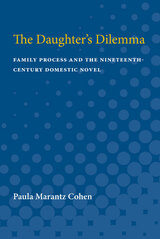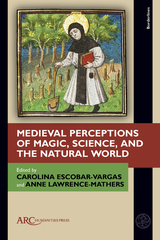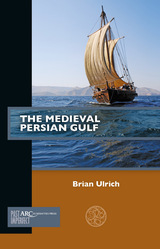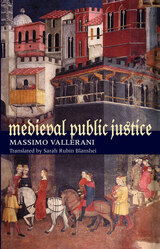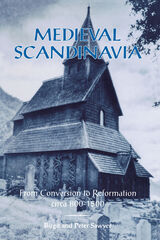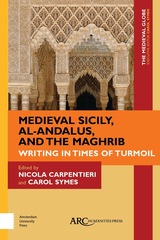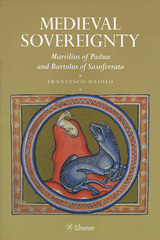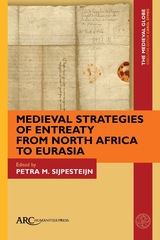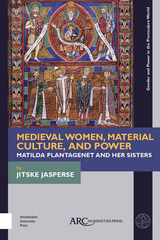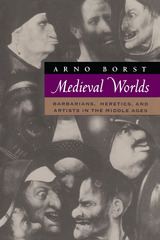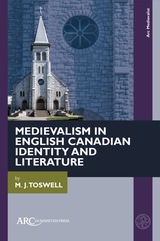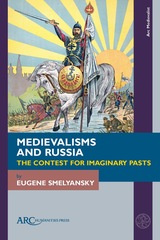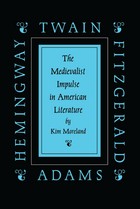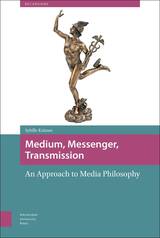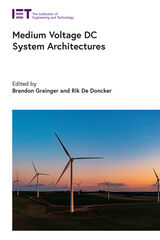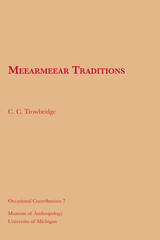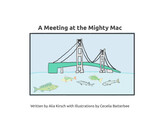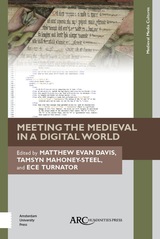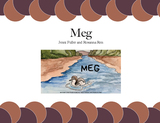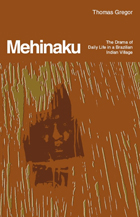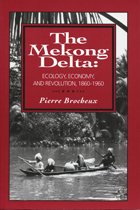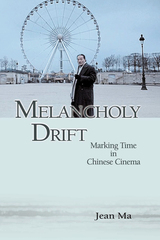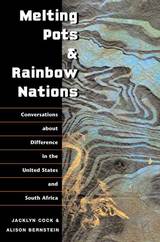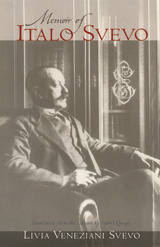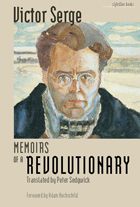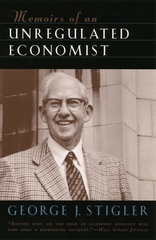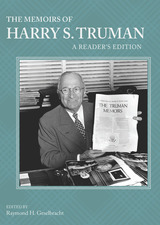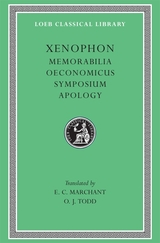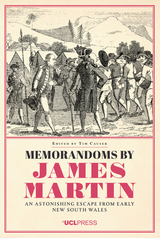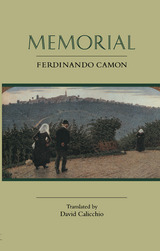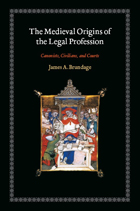 The Medieval Origins of the Legal Profession: Canonists, Civilians, and Courts
James A. Brundage
University of Chicago Press, 2008 In the aftermath of sixth-century barbarian invasions, the legal profession that had grown and flourished during the Roman Empire vanished. Nonetheless, professional lawyers suddenly reappeared in Western Europe seven hundred years later during the 1230s when church councils and public authorities began to impose a body of ethical obligations on those who practiced law. James Brundage’s The Medieval Origins of the Legal Profession traces the history of legal practice from its genesis in ancient Rome to its rebirth in the early Middle Ages and eventual resurgence in the courts of the medieval church.
By the end of the eleventh century, Brundage argues, renewed interest in Roman law combined with the rise of canon law of the Western church to trigger a series of consolidations in the profession. New legal procedures emerged, and formal training for proctors and advocates became necessary in order to practice law in the reorganized church courts. Brundage demonstrates that many features that characterize legal advocacy today were already in place by 1250, as lawyers trained in Roman and canon law became professionals in every sense of the term. A sweeping examination of the centuries-long power struggle between local courts and the Christian church, secular rule and religious edict, The Medieval Origins of the Legal Profession will be a resource for the professional and the student alike.
Medieval Perceptions of Magic, Science, and the Natural World
Carolina Escobar-Vargas
Arc Humanities Press, 2024
This volume presents new research in medieval conceptions of magic, science, and the natural world, bringing not only medicine but also meteorology and navigation into the discussion. Ground-breaking theoretical chapters on theology, natural sciences, and the writing of history are presented by established experts in their fields. These are accompanied by case studies of interactions between magic, science, and natural philosophy. Each chapter offers new findings while contributing to a comprehensive survey of the shifting boundaries between natural and supernatural across both space and time. Emerging areas, such as the study of prognostics, are represented by challenging new work. This collection will prove fascinating to everyone engaging with this expanding field.
The Medieval Persian Gulf
Brian Ulrich
Arc Humanities Press, 2023 The Persian Gulf today is home to multiple cosmopolitan urban hubs of globalization. This did not start with the discovery of oil. This book tells of the Gulf from the rise of Islam until the coming of the Portuguese, when port cities such as Siraf, Sohar, and Hormuz were entrepots for trading pearls, horses, spices, and other products across much of Asia and eastern Africa. Indeed, products traded there became a key part of the material culture of medieval Islamic civilization, and the Gulf region itself was a crucial membrane between the Middle East and the world of the broader Indian Ocean. The book also highlights the long-term presence of communities of South Asian and African ancestry, as well as patterns of religious change among Jews, Christians, Zoroastrians, and Muslims that belie the image of a region long polarized between Arabs and Persians and Sunnis and Shi’ites.
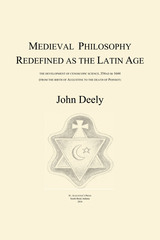 Medieval Philosophy Redefined as the Latin Age
John Deely
St. Augustine's Press, 2016 In a statement published for Paul Cobley’s edition of Realism for the 21st Century. A John Deely Reader, Umberto Eco wrote that “John Deely has not only paid attention to the Second Scholasticism but also to the first one”. In the present book, Deely goes one step further, by establishing the continuity of the Latin Age as a whole. He shows how the Latin thinkers demonstrated the presuppositions and created the framework of critical thought that made possible and inevitable the turn to science in the modern sense. The book thus shows how and why criticalachievements of the Latins remain requisite, even today, for the proper understanding of science and technology as offshot of the “Way of Signs” upon which all of thought, as also evikytuib as a whole, perforce travels.
“With the sophistic modern and Enlightenment misconceptions about philosophy’s nature and history daily crashing and burning around us, Deely’s unconventional way of understanding medieval philosophy is like a breath of fresh air amid intellectual smog. This is a great book, the single most important study of medieval thought in half a century or more. It deserves an unbiased hearing by anyone today claiming to be a serious philosopher.” — Peter A. Redpath
Founding Chairman, Universities of Western Civilization Chairman of the Board, The International Etienne Gilson Society
“Drawing upon the thought of John Poinsot and Charles Pierce, John Deely has opened a distinctively postmodern path to the metaphysics of being, at once illuminating much of this ancient tradition while casting new light upon it in the context of contemporary thought. His treatment notably of St. Thomas is not merely a return to an earlier thinker, but an opening to a different path, at once in profound agreement with St. Thomas and yet heretofore unexplored. This book, thus, not only constitutes a return to a past era, but shows this era in a new light that illuminates as well the contemporary scene.” — Kenneth L. Schmitz
Professor Emeritus, University of Toronto, Canada Pontifical John Paul II Institute for Studies on Marriage and Family, Washington, D.C.
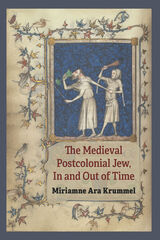 The Medieval Postcolonial Jew, In and Out of Time
Miriamne Ara Krummel
University of Michigan Press, 2022 The Medieval Postcolonial Jew, In and Out of Time studies violent temporal clashes that are written into the medieval vision of annus domini [the year of our Lord]. Christian temporality represents Jewish time as queerly oddly outmoded and advocating uncivil and socially disruptive behavior. Jewish temporality, in turn, records a marginalized people who work to rescue their embattled temporality from becoming a time forgotten and colonized. Through a select group of literature in Middle English, Latin, and Hebrew, as well as sixteen manuscript pictorials, author Miriamne Ara Krummel confronts the notion that annus domini time (whether disguised as CE or AD) figures as the universal standard. Krummel’s argument details how Other temporalities—ones outside and not like annus domini time—are cast as nonstandard and imagined as wholly devised out of stories that promote fear and terror, and are positioned as putative threats to the fabric of the temporal empire of Latin Christendom. Ultimately, the book reflects on the ways in which “common” time both marks and silences marginal identities and cultures and shows to what extent the dynamics of the medieval environment materialize in our modern world.
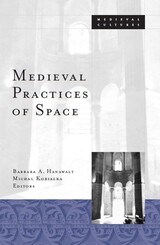 Medieval Practices Of Space
Barbara A. Hanawalt
University of Minnesota Press, 2000 Interprets space and place in the medieval era. Interprets space and place in the medieval era. A glance at medieval maps tells us that cartographers of the Middle Ages divided space differently than we do today. In the great mappae mundi, for instance, Jerusalem takes center stage, with an image of the crucified Christ separating one place from another. The architects of medieval cathedrals manipulated space to clarify the roles and status of all who entered. Even in the most everyday context, space was allotted according to gender and class and was freighted with infinitely subtle meanings. The contributors to this volume cross disciplinary and theoretical boundaries to read the words, metaphors, images, signs, poetic illusions, and identities with which medieval men and women used space and place to add meaning to the world.Contributors: Kathleen Biddick, U of Notre Dame; Charles Burroughs, SUNY, Binghamton; Michael Camille, U of Chicago; Tom Conley, Harvard U; Donnalee Dox, U of Arizona; Jody Enders, U of California, Santa Barbara; Valerie K. J. Flint, U of Hull, UK; Andrzej Piotrowski, U of Minnesota; Daniel Lord Smail, Fordham U.Barbara A. Hanawalt is King George III Professor of British History at Ohio State University. Michal Kobialka is associate professor of theatre at University of Minnesota.
Medieval Public Justice
Massimo Vallerani
Catholic University of America Press, 2012 In a series of essays based on surviving documents of actual court practices from Perugia and Bologna, as well as laws, statutes, and theoretical works from the 12th and 13th centuries, Massimo Vallerani offers important historical insights into the establishment of a trial-based public justice system.
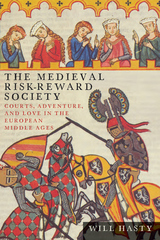 The Medieval Risk-Reward Society: Courts, Adventure, and Love in the European Middle Ages
Will Hasty
Ohio State University Press, 2016 The Medieval Risk-Reward Society offers a study of adventure and love in the European Middle Ages focused on the poetry of authors such as Marie de France, Chrétien de Troyes, Wolfram von Eschenbach, and Gottfried von Strassburg—showing how a society based on sacrifice becomes a society based on wagers and investments. Will Hasty’s sociological approach to medieval courtly literature, informed by the analytic tools of game theory, reveals the blossoming of a worldview in which outcomes are uncertain, such that the very self (of a character or an authorial persona) is contingent on success or failure in possessing the things it desires—and upon which its social identity and personal happiness depend. Drawing on a diverse selection of contrasting canonical works ranging from the Iliad to the biblical book of Joshua to High Medieval German political texts to the writings of Leibniz and Mark Twain, Hasty enables an appreciation of the distinctive contributions made in antiquity and the Middle Ages to the medieval emergence of a European society based on risks and rewards.
The Medieval Risk-Reward Society: Courts, Adventure, and Love in the European Middle Ages takes a descriptive approach to the competitions in religion, politics, and poetry that are constitutive of medieval culture. Culture is considered always to be happening, and to be happening on the cultural cutting edge as competitions for rewards involving the element of chance. This study finds adventure and love—the principal concerns of medieval European romance poetry—to be cultural game changers, and thereby endeavors to make a humanist contribution to the development of a cultural game theory.
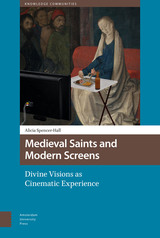 Medieval Saints and Modern Screens: Divine Visions as Cinematic Experience
Alicia Spencer-Hall
Amsterdam University Press, 2018 This ground-breaking book brings theoretical perspectives from twenty-first century media, film, and cultural studies to medieval hagiography. Medieval Saints and Modern Screens stakes the claim for a provocative new methodological intervention: consideration of hagiography as media. More precisely, hagiography is most productively understood as cinematic media. Medieval mystical episodes are made intelligible to modern audiences through reference to the filmic - the language, form, and lived experience of cinema. Similarly, reference to the realm of the mystical affords a means to express the disconcerting physical and emotional effects of watching cinema. Moreover, cinematic spectatorship affords, at times, a (more or less) secular experience of visionary transcendence: an 'agape-ic encounter'. The medieval saint's visions of God are but one pole of a spectrum of visual experience which extends into our present multi-media moment. We too conjure godly visions: on our smartphones, on the silver screen, and on our TVs and laptops. This book places contemporary pop-culture media - such as blockbuster movie The Dark Knight, Kim Kardashian West's social media feeds, and the outputs of online role-players in Second Life - in dialogue with a corpus of thirteenth-century Latin biographies, 'Holy Women of Liège'. In these texts, holy women see God, and see God often. Their experiences fundamentally orient their life, and offer the women new routes to knowledge, agency, and belonging. For the holy visionaries of Liège, as with us modern 'seers', visions are physically intimate, ideologically overloaded spaces. Through theoretically informed close readings, Medieval Saints and Modern Screens reveals the interconnection of decidedly 'old' media - medieval textualities - and artefacts of our 'new media' ecology, which all serve as spaces in which altogether human concerns are brought before the contemporary culture's eyes. Read Alicia Spencer-Hall's keynote paper 'Hagiography, Media, and the Politics of Visibility' from the Gender and Medieval Studies conference in Oxford on her blog Medieval She Wrote.
Medieval Sicily, al-Andalus, and the Maghrib: Writing in Times of Turmoil
Nicola Carpentieri
Arc Humanities Press, 2020 This book explores a millennium of literary exchanges among the peoples of the Maghrib, or westernmost strongholds of medieval Islam. In the seventh century, Muslim expansion into the western Mediterranean initiated a new phase in the layering of heterogeneous peoples and languages in this contact zone: Arabs and Berbers, Christians and Jews, Sunnī and Shīʿa Muslims, Greeks and Latins all helped shape identities, hybrid genealogies of knowledge, and political alliances. These essays excavate the literary artefacts produced in these times of turmoil, offering new perspectives on the intellectual networks and traditions that proved instrumental in overcoming the often traumatic transitions among political and/or religious regimes.
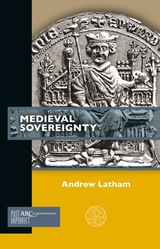 Medieval Sovereignty
Andrew Latham
Arc Humanities Press, 2022 Through a focused and systematic examination of medieval theologians, philosophers, and jurists, Andrew Latham explores how ideas about supreme political authority—sovereignty—first emerged during the high medieval period. The author provides a new model for understanding the concept of sovereignty, and traces its roots, not to the early modern or late medieval eras as do all other accounts, but to the High Middle Ages.
This book aims first to provide an account of a pivotal episode in the historical evolution of the idea of sovereignty—the supreme authority to command, legislate, and judge—in the thirteenth century. It also aims to reconnect early modern theorists of sovereignty to the medieval intellectual tradition out of which they emerged.
Latham traces the rise of a “dualist–regnalist” model whereby supreme authority was vested neither in the pope nor the emperor; nor was it divided between coordinate temporal and spiritual powers (kings and popes). Instead, it was vested exclusively in the king, who held it directly from God or (in the case of John of Paris, for example) “the people,” without any papal or imperial mediation.
Medieval Sovereignty: Marsilius of Padua and Bartolous of Saxoferrato
Francesco Maiolo
Eburon Academic Publishers, 2007 Medieval Sovereignty examines the idea of sovereignty in the Middle Ages and asks if it can be considered a fundamental element of medieval constitutional order. Francesco Maiolo analyzes the writings of Marsilius of Padua (1275/80–1342/43) and Bartolous of Saxoferrato (1314–57) and assesses their relative contributions as early proponents of popular sovereignty. Both are credited with having provided the legal justification for medieval popular government. Maiolo’s cogent reconsideration of this primacy is an important addition to current medieval studies.
Medieval Strategies of Entreaty from North Africa to Eurasia
Petra Sijpesteijn
Arc Humanities Press, 2024 This volume in The Medieval Globe Books series surveys the distinctive but also shared rhetorical practices that characterize written requests for intercession, support, and patronage across many languages, cultures, and forms of interaction. Examples range from mundane requests to diplomatic negotiations, preserved in a variety of material media: potsherds, papyrus, paper, administrative handbooks, chronicles, and letter collections. Each contribution focuses on one textual sample or corpus of letters, providing new English translations as well as editions of the original texts in cases where no previous edition is available. Together, they represent the textual conventions and innovations of learned and vernacular epistolary traditions from many regions of North Africa and Eurasia, from the eighth to the fifteenth centuries CE.
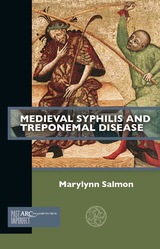 Medieval Syphilis and Treponemal Disease
Marylynn Salmon
Arc Humanities Press, 2022
Leaders in the field of paleopathology have found enough evidence to prove that treponematosis, including syphilis, existed in ancient and medieval Afro-Eurasia, settling a decades-long debate. Yet documentary and artistic evidence to support this important work remains scarce. After summarizing the confirmed cases of treponematosis detected to date, this book turns to contemporary accounts about the death of the English king, Edward IV, that strongly indicate syphilis as the cause. It then considers further evidence suggesting contemporary awareness that elites tended to experience the disease more severely than commoners, and includes numerous examples from medical treatises and artworks that are highly suggestive that both endemic and venereal treponematosis (bejel and syphilis) were present in late medieval Europe. In doing so, the author hopes to spark a conversation not only about the existence of the disease in various places and times, but also its wider impact on premodern society and culture.
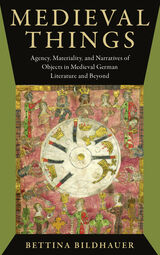 Medieval Things: Agency, Materiality, and Narratives of Objects in Medieval German Literature and Beyond
Bettina Bildhauer
Ohio State University Press, 2020 What does medieval literature look like from the point of view not of knights and ladies, but of treasure, and rings, nets and the grail? How does medieval literature imagine the agency of material things, and what exactly distinguishes human subjects from inanimate objects? Medieval Things: Agency, Materiality, and Narratives of Objects in Medieval German Literature and Beyond brings together a theoretically informed and politically engaged new materialist approach with a study of how everyday objects are understood in medieval literature. Bettina Bildhauer argues that medieval narratives can inspire current critical theory on agency and materiality. She focuses on famous and forgotten German narratives from the twelfth to the sixteenth centuries, including Wolfram of Eschenbach’s Parzival and the epic Song of the Nibelungs, and sets them in their global context. Many such tales can be reconceptualized as “thing biographies”—stories that follow the trajectory not of a human hero but of a coin, a gown, a treasure, or a ring. Many also use nets and networks to conceptualize dangerous structures of knowledge. Shine, glamour, and charisma emerge as particularly powerful ways in which material things exert a kind of agency that is neither pseudo-human nor fetishistic. In analyzing details like these from medieval literature, Bildhauer thus contributes in new ways to current theory on agency and materiality.
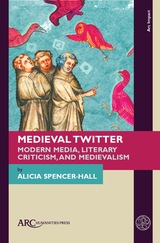 Medieval Twitter: Modern Media, Literary Criticism, and Medievalism
Alicia Spencer-Hall
Arc Humanities Press, 2024 This pioneering monograph provocatively explodes current research paradigms for the modern and the medieval by showing that Twitter shares key similarities with medieval literary forms, texts, and narrative techniques. Analyzing tweets with medieval texts, and vice versa, Spencer-Hall initiates readers into an innovative methodology of interdisciplinary literary criticism, posing vital questions about the politics of medievalism today. Chapters include brand-new readings of The Owl and the Nightingale, the Chastelaine de Vergi, and Marie de France’s Laüstic, and arresting insights into troubadour style, Margery Kempe, and #MedievalTwitter. The book culminates in a medieval(ist) reading of Twitter’s premature demise, and Elon Musk’s medievalism. Throughout, points of contact and divergence are dissected, re-contextualizing the socio-cultural meaning of communication and texts across the temporal divide.
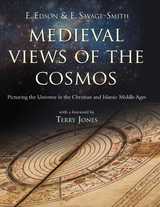 Medieval Views of the Cosmos
E. Edson and E. Savage-Smith
Bodleian Library Publishing, 2004 Once upon a time, the universe was much simpler: before our modern understanding of an infinite formless space scattered with pulsating stars, revolving planets, and mysterious black holes, the universe was seen as a rigid hierarchical system with the earth and the human race at its center. Medieval Views of the Cosmos investigates this worldview shared by medieval societies, revealing how their modes of thought affect us even today.
In the medieval world system—inherited by Christians and Muslims from the Greeks and Romans, and modified by their own religious tenets—spheres bearing the planets and stars wheeled around the earth, and at every level there was a moral lesson for humanity and a satisfying metaphor for the nature of God. The authors of this volume explain how the medieval view of the universe was harmonious on theological and practical levels, providing answers to the most puzzling of questions.
Medieval Views of the Cosmos is an engaging and beautifully illustrated introduction to a world where every moment was a theater of human drama directed by the hand of God.
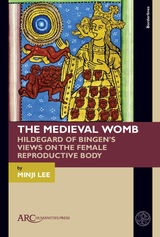 The Medieval Womb: Hildegard of Bingen’s Views on the Female Reproductive Body
Minji Lee
Arc Humanities Press, 2025 This study of the twelfth-century German abbess Hildegard of Bingen examines her understanding of the womb through her medical work Cause et cure and visionary work Scivias. Medieval tradition viewed female bodies negatively, seeing their porous nature as easily polluted. Women were considered weaker and more vulnerable to spiritual invasion. This volume shows how Hildegard’s revolutionary understanding of the female reproductive body reversed these assumptions. She connected female bodily flows not to pollution but to purification, presenting menstruation and reproductive fluids as vital components in natural cleansing and healing processes. The book concludes with a chapter showing how Hildegard's concept of beneficial bodily flow remains relevant in modern Western and non-Western alternative medicine, in which female bodily porosity and fluid exchange continue to be understood as sources of regenerative power.
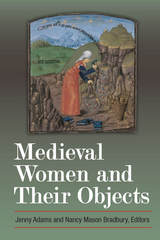 Medieval Women and Their Objects
Jenny Adams and Nancy Mason Bradbury, editors
University of Michigan Press, 2016 The essays gathered in this volume present multifaceted considerations of the intersection of objects and gender within the cultural contexts of late medieval France and England. Some take a material view of objects, showing buildings, books, and pictures as sites of gender negotiation and resistance and as extensions of women’s bodies. Others reconsider the concept of objectification in the lives of fictional and historical medieval women by looking closely at their relation to gendered material objects, taken literally as women’s possessions and as figurative manifestations of their desires.
The opening section looks at how medieval authors imagined fictional and legendary women using particular objects in ways that reinforce or challenge gender roles. These women bring objects into the orbit of gender identity, employing and relating to them in a literal sense, while also taking advantage of their symbolic meanings. The second section focuses on the use of texts both as objects in their own right and as mechanisms by which other objects are defined. The possessors of objects in these essays lived in the world, their lives documented by historical records, yet like their fictional and legendary counterparts, they too used objects for instrumental ends and with symbolic resonances. The final section considers the objectification of medieval women’s bodies as well as its limits. While this at times seems to allow for a trade in women, authorial attempts to give definitive shapes and boundaries to women’s bodies either complicate the gender boundaries they try to contain or reduce gender to an ideological abstraction. This volume contributes to the ongoing effort to calibrate female agency in the late Middle Ages, honoring the groundbreaking work of Carolyn P. Collette.
Medieval Women, Material Culture, and Power: Matilda Plantagenet and her Sisters
Jitske Jasperse
Arc Humanities Press, 2020 This book argues that the impressive range of belongings that can be connected to Duchess Matilda Plantagenet—textiles, illuminated manuscripts, coins, chronicles, charters, and literary texts—allows us to perceive elite women’s performance of power, even when they are largely absent from the official documentary record. It is especially through the visual record of material culture that we can hear female voices, allowing us to forge an alternative way toward rethinking assumptions about power for sparsely-documented elite women.
Medieval Worlds: Barbarians, Heretics and Artists in the Middle Ages
Arno Borst
University of Chicago Press, 1992 In Medieval Worlds: Barbarians, Heretics, and Artists, medieval historian Arno Borst offers at once an imaginatively narrated tour of medieval society. Issues of language, power, and cultural change come to life as he examines how knights, witches and heretics, monks and kings, women poets, and disputatious university professors existed in the medieval world.
Clearly interested in the forms of medieval behavior which gave rise to the seeds of modern society, Borst focuses on three in particular that gave momentum to medieval religious, social, and intellectual movements: the barbaric, heretical, and artistic. Borst concludes by reflecting on his own life as a scholar and draws out lessons for us from the turbulence of the Middle Ages.
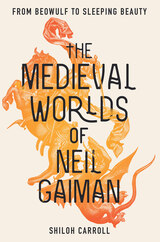 The Medieval Worlds of Neil Gaiman: From Beowulf to Sleeping Beauty
Shiloh Carroll
University of Iowa Press, 2023 Neil Gaiman is one of the most widely known writers of the twentieth and twenty-first centuries, having produced fiction and nonfiction, fantasy and horror, television, comics, and prose. He often attributes this eclecticism to his “compost heap” approach to writing, gathering inspiration from life, religion, literature, and mythology.
Readers love to sink into Gaiman’s medieval worlds—but what makes them “medieval”? Shiloh Carroll offers an introduction to the idea of medievalism, how the literature and culture of the Middle Ages have been reinterpreted and repurposed over the centuries, and how the layers of interpretation have impacted Gaiman’s own use of medieval material. She examines influences from Norse mythology and Beowulf to medieval romances and fairy tales in order to expand readers’ understanding and appreciation of Gaiman’s work, as well as the rest of the medievalist films, TV shows, and books that are so popular today.
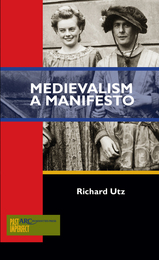 Medievalism: A Manifesto
Richard Utz
Arc Humanities Press, 2017 This book is called a manifesto because it has an unapologetically political objective. Richard Utz wants to help reform the way we think about and practise our academic engagement with medieval culture, and he uses his own observations as a medievalist and medievalism-ist over the last twenty-five years to offer ways in which we might reconnect with the general public that has allowed us to become, since the late nineteenth century, a rather exclusive clan of specialists who communicate mostly with each other.The traditional academic study of the Middle Ages, after more than a century of growing and plateauing, is now on the decline. While, at least over the next five to ten years, we will still be basking in the reassuring proximity (at conferences) of thousands of others who are involved in what we do ourselves, there is a manifest discrepancy between the large number of students who request that we address their love of Harry Potter, Lord of the Rings, Game of Thrones, and medieval-themed video and computer games, and the decreasing number of actual medievalists hired to replace retiring colleagues. We should pursue more lasting partnerships with so-called amateurs and enthusiasts for the sake of a sustainable future engagement with medieval culture. Richard Utz suggests some ways we might do this, and looks forward to “a more truly co-disciplinary, inclusive, democratic, and humanistic engagement with what we call, for better or worse, the Middle Ages”.
 Medievalism and Slavic Popular Culture
Anna Czarnowus
Arc Humanities Press, 2025 Although scholars are increasingly engaged with medievalism as a global phenomenon, its manifestations in the popular cultures of East and Central Europe are relatively unexamined. In a period of regional unrest, invocations of the medieval in Slavic regions are often political. Politicians use the past for nationalistic reasons. Popular renderings, such as animated films, can also appeal to nationalist sentiment. Yet, although medievalist appeals have been fundamental to official myths of nation-formation, they are also integral to countercultural ideologies. Medieval fantasy literature has traditionally provided one such nexus. More recently, medievalism has emerged in carnivalesque elements of pop punk music. Medievalisms also exist in the play spaces of reenactments of medieval life and combat. Yet even in play, these acts are never neutral: controlling the story of the past always has consequences in the now.
Medievalism in English Canadian Identity and Literature
M. J. Toswell
Arc Humanities Press, 2025 Canada has a deep layer of medievalism embedded in its architecture, governance structures, and sociocultural bedrock. This volume distinguishes between Canadian medievalism and its closest neighbours, British and American medievalism, and argues that the ignored or unnoticed medievalism of English Canada derives from its foundation by United Empire Loyalists escaping to the north in the late eighteenth century. The book considers particular literary and cultural expressions of medievalism—including Gothic architecture, heraldry, ice hockey, and Samuel de Champlain’s lost astrolabe; and the work of Guy Gavriel Kay, Earle Birney, Robertson Davies, Louise Penny, Alice Munro, Margaret Atwood, and George Longmore—arguing that medievalism remains a potent force in Canadian national identity.
Medievalisms and Russia: The Contest for Imaginary Pasts
Eugene Smelyansky
Arc Humanities Press, 2024
This new monograph devoted to a detailed exploration of the ways in which the medieval past has been wielded to propagandic effect in Imperial, Soviet, and post-Soviet Russia.
From politicians’ speeches to popular culture, from Orthodox Christianity to neo-paganism, the medieval Russian past remains crucial in constructing national identity, mobilizing society during times of crisis, and providing alternative models of communal belonging. Frequent appeals to a medieval Slavic past, its heroes and myths, have provided—and continue to provide—a particularly powerful tool for animating imperialist and populist sentiments.
This study explores persuasive—and pervasive—recourse to tropes concerned with the Middle Ages in Imperial, Soviet, and post-Soviet Russia, seeking to explain why an often romanticized medieval past remains potent in Russian politics, society, and culture today.
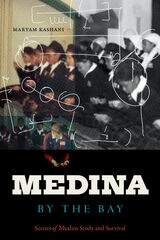 Medina by the Bay: Scenes of Muslim Study and Survival
Maryam Kashani
Duke University Press, 2023 From the Black Power movement and state surveillance to Silicon Valley and gentrification, Medina by the Bay examines how multiracial Muslim communities in the San Francisco Bay Area survive and flourish within and against racial capitalist, carceral, and imperial logics. Weaving expansive histories, peoples, and geographies together in an ethnographic screenplay of cinematic scenes, Maryam Kashani demonstrates how sociopolitical forces and geopolitical agendas shape Muslim ways of knowing and being. Throughout, Kashani argues that contemporary Islam emerges from the specificities of the Bay Area, from its landscapes and infrastructures to its Muslim liberal arts college, mosques, and prison courtyards. Theorizing the Medina by the Bay as a microcosm of socioeconomic, demographic, and political transformations in the twentieth- and twenty-first centuries, Kashani resituates Islam as liberatory and abolitionist theory, theology, and praxis for all those engaged in struggle.
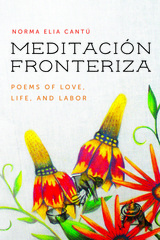 Meditación Fronteriza: Poems of Love, Life, and Labor
Norma Elia Cantú
University of Arizona Press, 2019 This collection is a beautifully crafted exploration of life in the Texas-Mexico borderlands. Written by Norma Elia Cantú, the award-winning author of Canícula, this collection carries the perspective of a powerful force in Chicana literature—and literature worldwide.
The poems are a celebration of culture, tradition, and creativity that navigates themes of love, solidarity, and political transformation. Deeply personal yet warmly relatable, these poems flow from Spanish to English gracefully. With Gloria Anzaldúa’s foundational work as an inspiration, Meditación Fronteriza unveils unique images that provide nuance and depth to the narrative of the borderlands.
Poems addressed to talented and influential women such as Gwendolyn Brooks and Adrienne Rich, among others, pour gratitude and recognition into the collection. While many of the poems in Meditación Fronteriza are gentle and inviting, there are also moments that grieve for the state of the borderlands, calling for political resistance.
 Meditation & the Martial Arts
Michael L. Raposa
University of Virginia Press, 2003 The relationship between meditation and the martial arts is a multifaceted one: meditation is one of the practices in which martial artists engage in order to prepare for combat, while the physical exercises constituting much of the discipline of the martial arts might well be considered meditative practices. Michael Raposa, himself a martial arts practitioner, suggests there is a sense in which meditation may in turn be considered a form of combat, citing a variety of spiritual disciplines that are not strictly classified as "martial arts" yet that employ the heavy use of martial images and categories as part of their self-description.
Raposa, in this extraordinary alloy of meditation manual, historical synthesis, and spiritual guide, provides a fascinating approach to understanding the connection between martial arts and spirituality in such diverse disciplines as Japanese aikido, Chinese tai chi chuan, Hindu yoga, Christian asceticism, Zen Buddhism, and Islamic jihad.
What happens when spiritual discipline is appropriated for exercises meant for health or recreation? How might prayer, meditation, and ritual be understood as martial activities? What is the nature of conflict, and who is the enemy? These are some of the questions Raposa raises and responds to in Meditation and the Martial Arts, his rumination on the martial arts as meditative practice and meditation as a martial discipline.
--------------------------------------------------------------------------------
Michael L. Raposa, Professor of Religion Studies at Lehigh University, is the author of Peirce's Philosophy of Religion and Boredom and the Religious Imagination (Virginia).
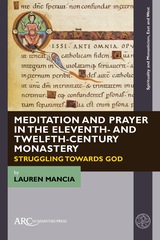 Meditation and Prayer in the Eleventh- and Twelfth-Century Monastery: Struggling towards God
Lauren Mancia
Arc Humanities Press, 2023 This book explores the dimensions of medieval monastic meditation, prayer, and contemplation in the heyday of Benedictine and Cistercian spiritual writing, the eleventh and twelfth centuries. Mancia aims to answer the following questions: What did extra-liturgical prayer and meditation look like for medieval monks and nuns in western medieval Europe? When, where, and how was it practised? Was there a set way to engage with monastic meditation, or were there a variety of medieval monastic meditative experiences in the eleventh and twelfth centuries? What did monks and nuns perceive as the limitations of monastic prayer and meditation, and how did they understand their own imperfections and failures to perform "perfect" devotion? What extra-textual tools—art, manuscripts, diagrams, spaces—did monks and nuns rely upon to stimulate their practices of meditation? What does monastic meditation reveal about the emotional lives of Benedictine and Cistercian monks and nuns in the high Middle Ages? And, finally, what does the monastic struggle to pursue a prayerful Christian life have to teach the secular world of the twenty-first century?
 Meditation as Spiritual Therapy: Bernard of Clairvaux's De consideratione
Matthew McWhorter
Catholic University of America Press, 2024 Christian persons today might seek spiritual development and ponder
the benefit of mindfulness exercises but also maintain concerns if they perceive such exercises to originate from other religious traditions. Such persons may not be aware of a long tradition of meditation practice in Christianity that promotes personal growth.
This spiritual tradition receives a careful formulation by Christian mo-
nastic authors in the twelfth century. One such teaching on meditation is found in the treatise De consideratione written by St. Bernard of Clairvaux (d. 1153) to Pope Eugene III (d. 1153). In textual passages where St. Bernard exhibits a clear concern for the mental health of the Pope (due to numerous ongoing ecclesial, political, and military problems), St. Bernard reminds Eugene III of his original monastic vocation and the meditation exercises associated with that vocation. The advice that St. Bernard gives to Eugene III can be received today in a way that provides a structure for Christian meditation practice which is relevant for personal develop-
ment, spiritual direction, and civil psychotherapy that integrates a client’s spirituality into the course of treatment. St. Bernard thus might be interpreted as a teacher of a kind of Christian mindfulness that can benefit both a person’s mental health as well as a person’s relationship with God. Meditation as Spiritual Therapy examines the historical context of Bernard’s work, his purpose for writing it, as well as the numerous Christian sources he drew upon to formulate his teaching. Bernard’s teaching on the course of meditation itself is explored in depth and in dialogue with
his other treatises, letters, and sermons.
Lastly, a contemporary summary of Bernard’s teaching is provided with reflections concerning the relationship of this teaching to contemporary spiritual direction and spiritually integrated civil psychotherapy.
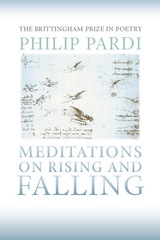 Meditations on Rising and Falling: Meditations on Rising and Falling
Philip Pardi
University of Wisconsin Press, 2008 Winner of the 2008 Brittingham Prize in Poetry, selected by David St. John From tumult to catharsis, the poems in Philip Pardi’s first collection, Meditations on Rising and Falling, explore the emotional tug-of-war that is the human experience. Present at every turn are people searching for meaning and sense in an elusive world: a doorman who plans to punch the senator who never speaks to him, a son who discusses ornithology with his father’s dying friend, a roofer who copes with his past as he senses his imminent fall to the ground. While the poems are witness to the turmoil of both body and soul, they are not without hope. Pardi finds grace in noise, and happiness in the mourning doves, showing us that often, the reasons for disbelief become precisely the reasons for belief. Pardi’s collection is a testimony to faith and resistance in a world where “falling is the given.” Winner, Award for Poetry and Literary Criticism, The Writers’ League of Texas Finalist, 2008 Norma Farber First Book Award, Poetry Society of America
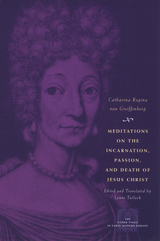 Meditations on the Incarnation, Passion, and Death of Jesus Christ
Catharina Regina von Greiffenberg
University of Chicago Press, 2009 Read by Protestants and Catholics alike, Catharina Regina von Greiffenberg (1633–94) was the foremost German woman poet and writer in the seventeenth-century German-speaking world. Privileged by her social station and education, she published a large body of religious writings under her own name to a reception unequaled by any other German woman during her lifetime. But once the popularity of devotional writings as a genre waned, Catharina’s works went largely unread until scholars devoted renewed attention to them in the twentieth century.
For this volume, Lynne Tatlock translates for the first time into English three of the thirty-six meditations, restoring Catharina to her rightful place in print. These meditations foreground women in the life of Jesus Christ—including accounts of women at the Incarnation and the Tomb—and in Scripture in general. Tatlock’s selections give the modern reader a sense of the structure and nature of Catharina’s devotional writings, highlighting the alternative they offer to the male-centered view of early modern literary and cultural production during her day, and redefining the role of women in Christian history.
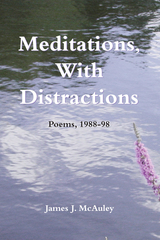 Meditations, With Distractions: Poems, 1988-1998
James McAuley
University of Arkansas Press, 2001 At the center of James McAuley’s new collection—the work of over a decade since his previous book, Coming & Going, New & Selected—is the sequence, “God’s Pattern,” meditations on the Stations of the Cross, an old devotional form of pilgrimage or “pattern” still practiced in rural parishes of the poet’s native country, Ireland. Theme and treatment vary throughout the collection, from somber reflection on the fate of a drunk in a cheap hotel room, “Cantata for the Feast of St. Anonymous,” to the scathing Celtic-style satire, “The Gingriad.” McAuley is well regarded for his experiments with traditional forms and rhythms: examples included are blank-verse narratives and elegies, a Haiku sequence, sonnets, a variation on the topographical poetry of the seventeenth century, even a carmen figurata. Meditations, With Distractions has the qualities that all good poetry should possess: depth, erudition, accessibility, a joy in the practice of language. Combine these qualities with McAuley’s humanity and humor, and the result is a collection that readers will come to enjoy and appreciate more and more with each successive reading.
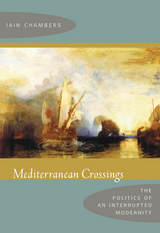 Mediterranean Crossings: The Politics of an Interrupted Modernity
Iain Chambers
Duke University Press, 2008 The cultural theorist Iain Chambers is known for his historically grounded, philosophically informed, and politically pointed inquiries into issues of identity, alterity, and migration, and the challenge postcolonial studies poses to conventional Western thought. With Mediterranean Crossings, he challenges insufficient prevailing characterizations of the Mediterranean by offering a vibrant interdisciplinary and intercultural interpretation of the region’s culture and history. The “Mediterranean” as a concept entered the European lexicon only in the early nineteenth century. As an object of study, it is the product of modern geographical, political, and historical classifications. Chambers contends that the region’s fundamentally fluid, hybrid nature has long been obscured by the categories and strictures imposed by European discourse and government. In evocative and erudite prose, Chambers renders the Mediterranean a mutable space, profoundly marked by the linguistic, literary, culinary, musical, and intellectual dissemination of Arab, Jewish, Turkish, and Latin cultures. He brings to light histories of Mediterranean crossings—of people, goods, melodies, thought—that are rarely part of orthodox understandings. Chambers writes in a style that reflects the fluidity of the exchanges that have formed the region; he segues between major historical events and local daily routines, backwards and forwards in time, and from one part of the Mediterranean to another. A sea of endlessly overlapping cultural and historical currents, the Mediterranean exceeds the immediate constraints of nationalism and inflexible identity. It offers scholars an opportunity to rethink the past and present and to imagine a future beyond the confines of Western humanistic thought.
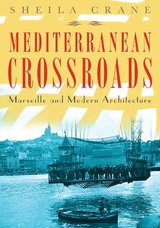 Mediterranean Crossroads: Marseille and Modern Architecture
Sheila Crane
University of Minnesota Press, 2010 In the first decades of the twentieth century, Marseille was a booming Mediterranean port. Positioned at the very edge of France, the city functioned as a critical fulcrum between the metropolitan center and its overseas empire. A notoriously dangerous and cosmopolitan city, Marseille became the focus of the extraordinary energies of some of the most remarkable architects and theorists of urban modernity.
Drawing together a cast of both world-renowned and less familiar architects, photographers, and cultural theorists, including Le Corbusier, Sigfried Giedion, Walter Benjamin, and László Moholy-Nagy, Mediterranean Crossroads examines how mythic ideas about Marseille helped to shape its urban landscape. Tracing successive planning proposals in tandem with shifting representations of the city in photographs, film, guidebooks, and postcards, Sheila Crane reconstructs the history and politics of architecture in Marseille from the 1920s through the years of rebuilding after World War II.
By exploring how architects and planners negotiated highly localized pressures, evolving imperial visions, and transnational aspirations at the borders of Europe and the Mediterranean region, Mediterranean Crossroads brings to life a lost chapter in the history of modern architecture.
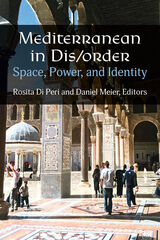 Mediterranean in Dis/order: Space, Power, and Identity
Rosita Di Peri and Daniel Meier, Editors
University of Michigan Press, 2023 Mediterranean in Dis/order reveals the connection between space and politics by examining the role that space has played in insurgencies, conflicts, uprisings, and mobilities in the Mediterranean region. With this approach, the authors are able to challenge well-established beliefs about the power structure of the state across different disciplines (including political science, history, sociology, geography, and anthropology), and its impact on the conception, production, and imagination of space in the broader Mediterranean. Further, they contribute to particular areas of studies, such as migration, political Islam, mobilization, and transition to democracy, among others. The book, infusing critical theory, unveils original and revelatory case studies in Tunisia, Libya, Lebanon, Turkey, Syria, Morocco, and the EU Mediterranean policy, through a various set of actors and practices—from refugees and migrations policies, to Islamist or students’ movements, architectural sites, or movies. This multidisciplinary perspective on space and power provides a valuable resource for practitioners interested in how space, context, and time interact to produce institutions, political subjectivities, and asymmetries of power, particularly since the turning point of the Arab uprisings. The book also helps readers understand the conditions under which the uprisings develop, giving a clearer picture about various national, regional, and international dynamics.
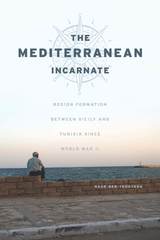 The Mediterranean Incarnate: Region Formation between Sicily and Tunisia since World War II
Naor Ben-Yehoyada
University of Chicago Press, 2017 In The Mediterranean Incarnate, anthropologist Naor Ben-Yehoyada takes us aboard the Naumachos for a thirty-seven-day voyage in the fishing grounds between Sicily and Tunisia. He also takes us on a historical exploration of the past eighty years to show how the Mediterranean has reemerged as a modern transnational region. From Sicilian poaching in North African territory to the construction of the TransMediterranean gas pipeline, Ben-Yehoyada examines the transformation of political action, imaginaries, and relations in the central Mediterranean while detailing the remarkable bonds that have formed between the Sicilians and Tunisians who live on its waters.
The book centers on the town of Mazara del Vallo, located on the southwestern tip of Sicily some ninety nautical miles northeast of the African shore. Ben-Yehoyada intertwines the town’s recent turbulent history—which has been fraught with conflicts over fishing rights, development projects, and how the Mediterranean should figure in Italian politics at large—with deep accounts of life aboard the Naumacho, linking ethnography with historical anthropology and political-economic analysis. Through this sophisticated approach, he crafts a new viewpoint on the historical processes of transnational region formation, one offered by these moving ships as they weave together new social and political constellations.
The Mediterranean Naval Situation, 1908-1914
Paul G. Halpern
Harvard University Press, 1971 During the early part of the twentieth century all the Mediterranean powers were transforming or at least expanding their navies from mere coastal defense forces to modern war machines, thus adding to a highly unstable political situation. The naval challenge of the Triple Alliance to Britain and especially to France was a serious one. Indeed, this study demonstrates that the Mediterranean situation had great influence on the plans and estimates of the British Admiralty.
Paul G. Halpern has uncovered new material in London, Paris, Rome, and Vienna that helps to explain the plans and dispositions of Entente and Triple Alliance forces at the outbreak of the war.
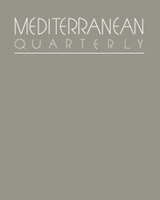 Mediterranean Security at the Cross Roads, Volume 8
Nikolaos Stavrou and Raymond C. Ewing
Duke University Press The Mediterranean is a diverse and volatile region, especially in its post—Cold War state, and it is entering a new phase of uncertainty. Twenty-two sovereign states surround this body of water: six are part of the Western alliance system, three have engaged in or supported terrorism, and others face serious internal tensions arising from territorial claims and ethnic strife. This special issue of Mediterranean Quarterly brings together scholars and policy makers representing a wide variety of interests and ideas to discuss this unique region and to explore its prospects for peace and stability.
The potential role of NATO is controversial but crucial to the future of the Mediterranean. Some contributors suggest that the southward expansion of NATO could be an important first step toward stability, while others argue that the Mediterranean should be treated as an integrated geostrategic region, with a central place in Western security considerations.
Highlighting this issue is a foreword by former U.S. Secretary of State George P. Schultz, and a piece focusing on NATO in the Mediterranean by Javier Solana, the Secretary General of NATO. Other essays discuss the comparative experience of UNPROFOR and IFOR in the former Yugoslavia; the role of Italy in the future of the Mediterranean; the economic challenges facing the Middle East; and the role of Israel and its relationship to its neighbors. Mediterranean Security at the Crossroads is one of the first in-depth looks at this region from a strictly post—Cold War perspective.
 Mediterranean Security at the Crossroads: A Reader
Nikolaos A. Stavrou, ed.
Duke University Press, 1999 The Mediterranean is a diverse and volatile region, especially in its post—Cold War state, and it is entering a new phase of uncertainty. Twenty-two sovereign states surround this body of water: six are part of the Western alliance system, three have engaged in or supported terrorism, and others face serious internal tensions arising from territorial claims and ethnic strife. An expansion of a previous issue of Mediterranean Quarterly, this book brings together a distinguished array of diplomats, politicians, scholars, and policymakers representing twelve countries and a variety of interests and ideas to discuss this unique region and to explore its prospects for peace and stability. New essays in this expanded volume include a reflection by former President Jimmy Carter on the causes of war and their links to human suffering, a prophetic analysis of the post-Cold War environment in the Mediterranean by former U.N. Secretary General Boutros-Boutros Ghali, an essay on the strategic significance of Turkey in the eastern Mediterranean by the former Turkish ambassador to the United States, and, in light of recent events in Kosovo and elsewhere in the former Yugoslavia, a piece on the issue of Balkan security by the editor. Introducing the volume is a foreword by former U.S. Secretary of State George P. Schultz and an essay focusing on NATO in the Mediterranean by Javier Solana, the Secretary General of NATO. Central to the Mediterranean debate is the question of NATO’s role in its future. Some contributors suggest that the southward expansion of NATO could be an important first step toward stability, while others argue that the Mediterranean should be treated as an integrated geostrategic region, with a central place in Western security considerations. Other essays discuss the comparative experience of UNPROFOR and IFOR in the former Yugoslavia; the role of Italy in the future of the Mediterranean; the economic challenges facing the Middle East; and the role of Israel and its relationship to its neighbors. Mediterranean Security at the Crossroads is one of the first in-depth looks at this region from a strictly post-Cold War perspective. Contributors. Hanan Bar-On, Ted Galen Carpenter, Jimmy Carter, Charles G. Cogan, Gregorios Demestichas, Boutros-Boutros Ghali, Carlo Jean, Nuzhet Kandemir, Nicolai A. Kovalsky, William H. Lewis, Peter H. Liotta, John A. MacInnis, Phebe Marr, Matthew Nimetz, George P. Schultz, Javier Solana, Richard F. Staar, Nikolaos A. Stavrou, George Vella, W. Bruce Weinrod
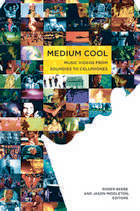 Medium Cool: Music Videos from Soundies to Cellphones
Roger Beebe and Jason Middleton, eds.
Duke University Press, 2007 Music videos are available on more channels, in more formats, and in more countries than ever before. While MTV—the network that introduced music video to most viewers—is moving away from music video programming, other media developments signal the longevity and dynamism of the form. Among these are the proliferation of niche-based cable and satellite channels, the globalization of music video production and programming, and the availability of videos not just on television but also via cell phones, DVDs, enhanced CDs, PDAs, and the Internet. In the context of this transformed media landscape, Medium Cool showcases a new generation of scholarship on music video. Scholars of film, media, and music revisit and revise existing research as they provide historically and theoretically expansive new perspectives on music video as a cultural form. The essays take on a range of topics, including questions of authenticity, the tension between high-art influences and mass-cultural appeal, the prehistory of music video, and the production and dissemination of music videos outside the United States. Among the thirteen essays are a consideration of how the rapper Jay-Z uses music video as the primary site for performing, solidifying, and discarding his various personas; an examination of the recent emergence of indigenous music video production in Papua New Guinea; and an analysis of the cultural issues being negotiated within Finland’s developing music video industry. Contributors explore precursors to contemporary music videos, including 1950s music television programs such as American Bandstand, Elvis’s internationally broadcast 1973 Aloha from Hawaii concert, and different types of short musical films that could be viewed in “musical jukeboxes” of the 1940s and 1960s. Whether theorizing music video in connection to postmodernism or rethinking the relation between sound and the visual image, the essays in Medium Cool reveal music video as rich terrain for further scholarly investigation. Contributors. Roger Beebe, Norma Coates, Kay Dickinson, Cynthia Fuchs, Philip Hayward, Amy Herzog, Antti-Ville Kärjä, Melissa McCartney, Jason Middleton, Lisa Parks, Kip Pegley, Maureen Turim, Carol Vernallis, Warren Zanes
 Medium Cool, Volume 101
Andrew McNamara and Peter Krapp, eds.
Duke University Press The fact that the mass media constitute such a ubiquitous presence in contemporary life often leads to the assumption that medium or media emerged as a specific issue only with the advent of mass media. The question of medium is today almost totally subsumed within discussions of the mass media. In this context, it is always regarded as plural. Yet the issue of the medium became a central concern of modernist art almost a century and a half ago. This collection of essays seeks to reopen this long history of exploration and engagement and to scrutinize the role of the medium in areas as diverse as modernist, contemporary, and avant-garde art, photography, cinema, and architecture, as well as in the more familiar guises of electronic media including television and computer games.
Contributors. Keith Broadfoot, Rex Butler, Patrick Crogan, Wolfgang Ernst, Gary Hall, Rosemary Hawker, Peter Krapp, Catherine Liu, John MacArthur, Andrew McNamara, Toni Ross, Lisa Trahair, Georg Stanitzek, Georg Christoph Tholen, Lisa Trahair, Samuel Weber, Simon Morgan Wortham
Medium, Messenger, Transmission: An Approach to Media Philosophy
Sybille Krämer
Amsterdam University Press, 2015 This rich study provides a comprehensive introduction to media philosophy while offering a new perspective on the concept and function of transmission media in all systems of exchange. Krämer uses the figure of the messenger as a key metaphor, examining a diverse range of transmission events, including the circulation of money, translation of languages, angelic visitations, spread of infectious diseases, and processes of transference and counter-transference that occur during psychoanalysis.
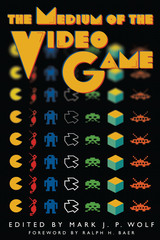 The Medium of the Video Game
Edited by Mark J. P. Wolf
University of Texas Press, 2002 Over a mere three decades, the video game became the entertainment medium of choice for millions of people, who now spend more time in the interactive virtual world of games than they do in watching movies or even television. The release of new games or game-playing equipment, such as the PlayStation 2, generates great excitement and even buying frenzies. Yet, until now, this giant on the popular culture landscape has received little in-depth study or analysis. In this book, Mark J. P. Wolf and four other scholars conduct the first thorough investigation of the video game as an artistic medium. The book begins with an attempt to define what is meant by the term "video game" and the variety of modes of production within the medium. It moves on to a brief history of the video game, then applies the tools of film studies to look at the medium in terms of the formal aspects of space, time, narrative, and genre. The book also considers the video game as a cultural entity, object of museum curation, and repository of psychological archetypes. It closes with a list of video game research resources for further study.
Medium Voltage DC System Architectures
Brandon Grainger
The Institution of Engineering and Technology, 2022 Direct Current (DC) transmission and distribution technologies have evolved in recent years. They offer superior efficiency, current carrying capacity, and response times as compared to conventional AC systems. Further, substantial advantages are their natural interface with many types of renewable energy resources, such as photovoltaic systems and battery energy storage systems at relatively high voltage, and compliance with consumer electronics at lower voltages, say, within a household environment. One of the core building blocks of DC-based technologies, especially at medium voltage levels, is power electronic systems technology. This cannot be emphasized enough as these units process, convert, and regulate all DC power and provide intelligence and sensing as electric power grids evolve.
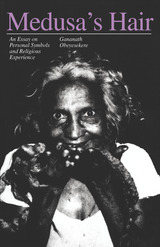 Medusa's Hair: An Essay on Personal Symbols and Religious Experience
Gananath Obeyesekere
University of Chicago Press, 1981 The great pilgrimage center of southeastern Sri Lanka, Kataragama, has become in recent years the spiritual home of a new class of Hindu-Buddhist religious devotees. These ecstatic priests and priestesses invariably display long locks of matted hair, and they express their devotion to the gods through fire walking, tongue-piercing, hanging on hooks, and trance-induced prophesying.
The increasing popularity of these ecstatics poses a challenge not only to orthodox Sinhala Buddhism (the official religion of Sri Lanka) but also, as Gananath Obeyesekere shows, to the traditional anthropological and psychoanalytic theories of symbolism. Focusing initially on one symbol, matted hair, Obeyesekere demonstrates that the conventional distinction between personal and cultural symbols is inadequate and naive. His detailed case studies of ecstatics show that there is always a reciprocity between the personal-psychological dimension of the symbol and its public, culturally sanctioned role. Medusa's Hair thus makes an important theoretical contribution both to the anthropology of individual experience and to the psychoanalytic understanding of culture. In its analyses of the symbolism of guilt, the adaptational and integrative significance of belief in spirits, and a host of related issues concerning possession states and religiosity, this book marks a provocative advance in psychological anthropology.
Meearmeear Traditions
C. C. Trowbridge
University of Michigan Press, 1938 In his position of secretary to Lewis Cass, the governor of Michigan Territory, C. C. Trowbridge negotiated treaties, served as interpreter, and wrote reports on the customs of the Miami, Menominee, Shawnee, and Wyandot tribes. He wrote the manuscript entitled Meearmeear Traditions (meearmeear being a transliteration of “Miami”) in the early 1820s; the University of Michigan published it in 1938. Contains 1 b&w plate.
 The Mee-Ow Show at 50: From Cultural Rebellion to Comedy Institution
Joseph B. Radding and Paul W. Warshauer
Northwestern University Press, 2025 The fifty-year history of the Mee-Ow Show at Northwestern University and its influence on contemporary comedy In the fall of 1973, two students at Northwestern University resolved to create something on stage that was wholly their own. Soon, they would be joined by a cohort of performers, musicians, and staff, and the resulting production would go on to launch the careers of scores of entertainment professionals, including some of the most well-known and awarded names in comedy today. This book is not only an account of the rebellious fifty-year history of the Mee-Ow Show, now the longest-running student sketch comedy and improv show in the country, but also its far-reaching influence. The storied group’s alumni include such household names as Craig Bierko, Ana Gasteyer, Julia Louis-Dreyfus, John Cameron Mitchell, Dermot Mulroney, Seth Meyers, and Kristen Schaal. Based on more than a hundred new interviews with group members, presenting their words alongside never-before-published photographs and ephemera, The Mee-Ow Show at 50 provides a chronicle of the last half-century of the American undergraduate experience—and reveals how, from New York to Los Angeles, contemporary comedy can trace its roots to an upstart student production in Evanston, Illinois.
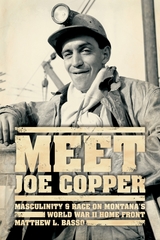 Meet Joe Copper: Masculinity and Race on Montana's World War II Home Front
Matthew L. Basso
University of Chicago Press, 2013 “I realize that I am a soldier of production whose duties are as important in this war as those of the man behind the gun.” So began the pledge that many home front men took at the outset of World War II when they went to work in the factories, fields, and mines while their compatriots fought in the battlefields of Europe and on the bloody beaches of the Pacific. The male experience of working and living in wartime America is rarely examined, but the story of men like these provides a crucial counter-narrative to the national story of Rosie the Riveter and GI Joe that dominates scholarly and popular discussions of World War II. In Meet Joe Copper, Matthew L. Basso describes the formation of a powerful, white, working-class masculine ideology in the decades prior to the war, and shows how it thrived—on the job, in the community, and through union politics. Basso recalls for us the practices and beliefs of the first- and second-generation immigrant copper workers of Montana while advancing the historical conversation on gender, class, and the formation of a white ethnic racial identity. Meet Joe Copper provides a context for our ideas of postwar masculinity and whiteness and finally returns the men of the home front to our reckoning of the Greatest Generation and the New Deal era.
 Meet Me at the Library: A Place to Foster Social Connection and Promote Democracy
Shamichael Hallman
Island Press, 2024 America is facing an epidemic of loneliness and isolation, with troubling effects on our mental and physical health. We live in one of the most divisive times in our history, one in which we tend to work, play, and associate only with people who think as we do. How do we create spaces for people to come together—to open our minds, understand our differences, and exchange ideas?
Shamichael Hallman argues that the public library may be our best hope for bridging these divides and creating strong, inclusive communities. While public libraries have long been thought of as a place for a select few, increasingly they are playing an essential role in building social cohesion, promoting civic renewal, and advancing the ideals of a healthy democracy. Many are reimagining themselves in new and innovative ways, actively reaching out to the communities they serve. Today, libraries are becoming essential institutions for repairing society.
Libraries have a unique opportunity to bridge socioeconomic divides and rebuild trust. But in order to do so, they must be truly welcoming to all. They and their communities must work collaboratively to bridge socioeconomic divides through innovative and productive partnerships.
Drawing from his experience at the Memphis Public Library and his extensive research and interviews across the country, Hallman presents a rich argument for seeing libraries as one of the nation’s greatest assets. He includes examples from libraries large and small--such as the Iowa’s North Liberty Library’s Lighthouse in the Library program to bring people together to discuss important topics in a safe and supportive space, to Cambridge Cooks, an initiative of the Cambridge MA Public Library that fosters social connection by bringing people together over shared interest in food.
As an institution that is increasingly under attack for creating a place where diverse audiences can see themselves, public libraries are under more scrutiny than ever. Meet Me at the Library offers us a revealing look at one of our most important civic institutions and the social and civic impact they must play if we are to heal our divided nation.
 Meet Me Halfway: Milwaukee Stories
Jennifer Morales
University of Wisconsin Press, 2015 When Johnquell, an African American teen, suffers a serious accident in the home of his white neighbor, Mrs. Czernicki, his community must find ways to bridge divisions between black and white, gay and straight, old and young. Set in one of the nation’s most highly segregated cities—Milwaukee, Wisconsin—Meet Me Halfway tells stories of connections in a community with a tumultuous and divided past. In nine stories told from diverse perspectives, Jennifer Morales captures a Rust Belt city’s struggle to establish a common ground and a collective vision of the future.
Morales gives life to multifaceted characters—white schoolteachers and senior citizens, Latino landlords, black and Puerto Rican teens, political activists, and Vietnam vets. As their lives unfold in these stories, we learn about Johnquell’s family—his grandparents’ involvement in the local Black Panther Party, his sister’s on-again, off-again friendship with a white classmate, and his aunt’s identity crisis as she finds herself falling in love with a woman. We also meet Johnquell’s mother, Gloria, and his school friend Taquan, who is struggling to chart his own future.
As an activist mother in the thick of Milwaukee politics, Morales developed a keen ear and a tender heart for the kids who have inherited the city’s troubled racial legacy. With a critical eye on promises unfulfilled, Meet Me Halfway raises questions about the notion of a “postracial” society and, with humor and compassion, lifts up the day-to-day work needed to get there.
Runner-up, Short Story/Anthology, Midwest Book Awards
Best books for public & secondary school libraries from university presses, American Library Association
Wisconsin representative for “Great Lakes Reads,” Library of Congress Center for the Book and its affiliated Midwest centers
Outstanding Achievement Award, Wisconsin Library Association (one of ten 2015 books chosen)
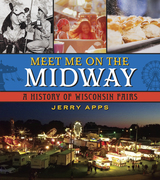 Meet Me on the Midway: A History of Wisconsin Fairs
Jerry Apps
Wisconsin Historical Society Press, 2022 Jerry Apps explores the history of county and state fairs in Wisconsin, from their earliest incarnations as livestock exhibitions to today’s multitude of exhibits and demonstrations, grandstand entertainment, games and rides, and competitions of all sorts. Drawing on his extensive research, interviews, and personal experience as a 4-H leader, county extension agent, fair judge, and lifelong fairgoer, Apps takes readers back through 178 years of Wisconsin fair history, covering everything from horsepulling and calf-showing contests to exhibit judging to the roar of gasoline engines powering the midway rides. He evokes the sights and sounds of fairs through the ages while digging in to the political and social forces that shaped the fair into an icon of our rural heritage. Illustrated with vintage and modern photos and featuring the voices of exhibitors, judges, volunteers, and visitors, Meet Me on the Midway vividly captures the thrills and cherished memories of these beloved annual gatherings.
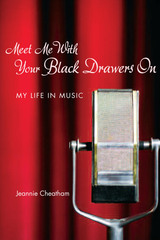 Meet Me with Your Black Drawers On: My Life in Music
By Jeannie Cheatham
University of Texas Press, 2006 Jeannie Cheatham is a living legend in jazz and blues. A pianist, singer, songwriter, and co-leader of the Sweet Baby Blues Band, she has played and sung with many of the greats in blues and jazz—T-Bone Walker, Dinah Washington, Cab Callaway, Joe Williams, Al Hibbler, Odetta, and Jimmy Witherspoon. Cheatham toured with Big Mama Thornton off and on for ten years and was featured with Thornton and Sippie Wallace in the award-winning PBS documentary Three Generations of the Blues. Her music, which has garnered national and international acclaim, has been described as unrestrained, exuberant, soulful, rollicking, wicked, virtuous, wild, and truthful. Cheatham's signature song, "Meet Me with Your Black Drawers On" is a staple in jazz and blues clubs across America and in Europe, Africa, and Japan.
In this delightfully frank autobiography, Jeannie Cheatham recalls a life that has been as exuberant, virtuous, wild, and truthful as her music. She begins in Akron, Ohio, where she grew up in a vibrant multiethnic neighborhood surrounded by a family of strong women. From those roots, she launched a musical career that took her from the Midwest to California, doing time along the way everywhere from a jail cell in Dayton, Ohio, where she was innocently caught in a police raid, to the University of Wisconsin-Madison—where she and Jimmy Cheatham taught music. Cheatham writes of a life spent fighting racism and sexism, of rage and resolve, misery and miracles, betrayals and triumphs, of faith almost lost in dark places, but mysteriously regained in a flash of light. Cheatham's autobiography is also the story of her fifty-years-and-counting love affair and musical collaboration with her husband and band partner, Jimmy Cheatham.
 Meet Shakur’s Family: A Shakur Series Board Book
Andrea Sonnier
Gallaudet University Press, 2024 After a long car ride filled with anticipation, Shakur is welcomed at his family reunion by a flurry of warm hugs from his grandparents. There are cousins to play with, including Judah, who Shakur has never met before. Judah is hearing and does not sign. No problem! Throughout a day filled with adventures together, Shakur teaches Judah a new language — American Sign Language. With this story, children will discover the joys of family and new friendships.
About the Shakur Series:
The Shakur Series features Black deaf characters who use American Sign Language, offering a unique and inclusive reading experience for children. The vibrant illustrations showcase a signing family and will captivate young minds, while the engaging text reinforces learning. These charming board books contain positive messages and practical lessons, support early childhood development, and encourage children to explore the world with Shakur. This series honors and celebrates Black deaf experiences through everyday adventures that will resonate with young children and their families.
Published in partnership with The Laurent Clerc National Deaf Education Center.
 Meeting at the Crossroads: Women’s Psychology and Girls’ Development
Lyn Mikel Brown and Carol Gilligan
Harvard University Press, 1992 On the way to womanhood, what does a girl give up? For five years, Lyn Mikel Brown and Carol Gilligan, asking this question, listened to one hundred girls who were negotiating the rough terrain of adolescence. This book invites us to listen, too, and to hear in these girls' voices what is rarely spoken, often ignored, and generally misunderstood: how the passage out of girlhood is a journey into silence, disconnection, and dissembling, a troubled crossing that our culture has plotted with dead ends and detours.
In the course of their research, Brown and Gilligan developed a Listener's Guide - a method of following the pathways of girls' thoughts and feelings, of distinguishing what girls are saying by the way they say it. We witness the struggle girls undergo as they enter adolescence only to find that what they feel and think and know can no longer be said directly. We see them at a cultural impasse, and listen as they make the painful, necessary adjustments, outspokenness giving way to circumspection, self-knowledge to uncertainty, authority to compliance. These changes mark the edge of adolescence as a watershed in women's psychological development, a time of wrenching disjunctions between body and psyche, voice and desire, self and relationship. Brown and Gilligan open their method to us and share their discoveries as they encourage girls at different ages to speak about themselves in conversation with women. They follow some of these girls over time, listening to changes in their distinct voices from one year to the next, addressing their successes and failures as they confront one barrier after another.
This groundbreaking work offers major new insights into girls' development and women's psychology. But perhaps more importantly, it provides women with the means of meeting girls at the critical crossroads of adolescence, of harkening to the voices of girlhood and sustaining their sell-affirming notes.
Meeting at the Hyphen: Schools-Universities-Communities-Professions in Collaboration for Student Achievement and Well Being
Edited by Mary M. Brabeck, Mary E. Walsh, and Rachel Latta
University of Chicago Press, 2003 This yearbook's focus is the scholarship of interprofessional collaborations—new ways of integrating services that avoid barriers to achievement and enhance both teaching and learning. The authors also examine new professional roles for school- and community-based practitioners and new university roles and partnerships, along with the scholarship that has emerged from such efforts. Contributors include Lee Benson, Ira Harkavy, Robert Crowson, Joy Dryfoos, Hal Lawson, Jacquelyn McCroskey, Jacob Murray, Richard Weissbourd, Jane Quinn, Adriana de Kanter, Jennifer K. Adair, An-Me Chung, and Robert Stonehill. Their essays will prove critical in informing future discussions of integrated services.
A Meeting at the Mighty Mac
Alia Kirsch
Michigan Publishing, 2023 This book was an assignment for the Winter 2022 course "Nature, Culture & Landscape" offered by Dr. Sara Adlerstein at the University of Michigan's School for Environment & Sustainability. The charge was to create a children's book related to the theme of the Great Lakes with the goal of inspiring children to care and make environmentally sound choices.
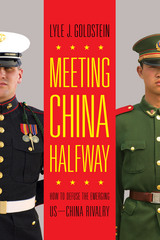 Meeting China Halfway: How to Defuse the Emerging US-China Rivalry
Lyle J. Goldstein
Georgetown University Press, 2015 Though a US-China conflict is far from inevitable, major tensions are building in the Asia-Pacific region. These strains are the result of historical enmity, cultural divergence, and deep ideological estrangement, not to mention apprehensions fueled by geopolitical competition and the closely related “security dilemma.” Despite worrying signs of intensifying rivalry, few observers have provided concrete paradigms to lead this troubled relationship away from disaster. This book is dramatically different in that Lyle J. Goldstein’s focus is on laying bare both US and Chinese perceptions of where their interests clash and proposing new paths to ease bilateral tensions through compromise. Each chapter contains a “cooperation spiral” —the opposite of an escalation spiral—to illustrate these policy proposals. Goldstein makes one hundred policy proposals over the course of this book to inaugurate a genuine debate regarding cooperative policy solutions to the most vexing problems in US-China relations. Goldstein not only parses findings from American scholarship but also breaks new ground by analyzing hundreds of Chinese-language sources, including military publications, never before evaluated by Western experts. Meeting China Halfway, new in paperback, remains a refreshing and unique contribution to the study of the world’s most important bilateral relationship.
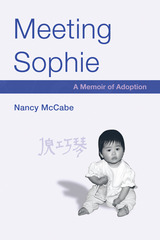 Meeting Sophie: A Memoir of Adoption
Nancy McCabe
University of Missouri Press, 2003 The baby is screaming again. My baby. I hoist her off the narrow hotel bed--again--and try to cradle her as I rock my torso back and forth in an uncomfortable straight-backed chair. This baby does not cradle. She doesn't know how to cuddle, to be soothed in anyone's arms. She howls and arches away, squirms and flops, a sixteen-pound fish out of water. I'm not used to holding babies, and she's not used to be being held, but when I try to put her down, she wails. My arms feel chafed, raw, and my wrists ache from the hours of straining to hang on to her. Huge tears pool in her eyes. These tears could break my heart. These screams could break my eardrums. After years as a temporary college instructor with no real home—her family and longtime friends scattered—Nancy McCabe yearned to settle down, establish a place she could call home, and rear a child there. A tough academic job market led her to accept a position at a church-connected college in the deep South, a move that felt like an uneasy return to the conservative environment of her childhood that she thought she had left behind. McCabe had many reservations about rearing a child alone in this climate, but the desire to become a mother would not go away. Meeting Sophie tells the story of McCabe adopting a Chinese daughter and the many obstacles she faced during the adoption and adjustment process as she renegotiated her role within her family and fought difficulties in her job. Especially poignant is her struggle to bond with a sick, grieving baby while in a foreign country during political unrest—followed, upon her return to the U.S., by a devastating loss and a career crisis.
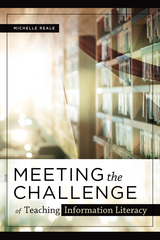 Meeting the Challenge of Teaching Information Literacy
Michelle Reale
American Library Association, 2020 While the profession has generated many books on information literacy, none to date have validated exactly why it is so difficult to teach. In her new book, Reale posits that examining and reflecting on the reality of those factors is what will enable practitioners to meet the challenge of their important mandate. Using the same warm and conversational tone as in her previous works, she - uses personal anecdotes to lay out the key reasons that teaching information literacy is so challenging, from the limited amount of time given to instructors and lack of collaboration with faculty to one’s own anxieties about the work;
- examines how these factors are related and where librarians fit in;
- validates readers’ struggles and frustrations through an honest discussion of the emotional labor of librarianship, including “imposter syndrome,” stress, and burnout;
- offers a variety of approaches, strategies, and topics of focus that will assist readers in their daily practice;
- looks at how a vibrant community of practice can foster positive change both personally and institutionally; and
- presents “Points to Ponder” at the end of each chapter that encourage readers to self-reflect and then transform personal insights into action.
Meeting the Medieval in a Digital World
Matthew Evan Davis
Arc Humanities Press, 2018 This book looks at the intersection between medieval studies and digital humanities, confronting how medievalists negotiate the “virtual divide” between the cultural artefacts that they study and the digital means by which they address those artefacts. The essays come from medievalists who have created digital resources or applied digital tools and methodologies in their scholarship. Text encoding and analysis, data modeling and provenance, and 3D design are all discussed as they apply to western European medieval literature, history, art history, and architecture.
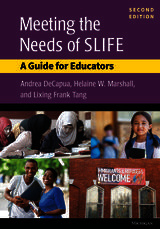 Meeting the Needs of SLIFE, Second Ed.: A Guide for Educators
Andrea DeCapua, Helaine W. Marshall, and Lixing Frank Tang
University of Michigan Press, 2020 Today's public schools are brimming with students who are not only new to English but who also have limited or interrupted schooling. These students, referred to as SLIFE (or SIFE), create unique challenges for teachers and administrators.
Like its predecessor, this book is grounded in research and is designed to be an accessible and practical resource for teachers, staff, and administrators who work with students with limited or interrupted formal education. Chapters 3-5 focus on classroom instruction, but others address issues of concern to administrators and staff too. For example, Chapter 6 explores different program models for SLIFE instruction, but the planning and commitment to creating a successful program require the involvement of many across the school community, not just teachers.
This edition features case studies, model programs, and teaching techniques and tips; also included is a new chapter focused on the Mutually Adaptive Learning Paradigm (MALP (R)). A major theme of this new edition is moving school personnel away from a deficit perspective, when it comes to teaching SLIFE, and toward one of difference. The goal is to help all stakeholders in the school community create and foster inclusion of, and equity for, a population that is all too often marginalized, ignored, and underserved.
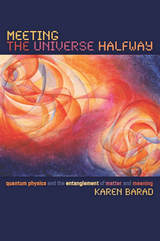 Meeting the Universe Halfway: Quantum Physics and the Entanglement of Matter and Meaning
Karen Barad
Duke University Press, 2006 Meeting the Universe Halfway is an ambitious book with far-reaching implications for numerous fields in the natural sciences, social sciences, and humanities. In this volume, Karen Barad, theoretical physicist and feminist theorist, elaborates her theory of agential realism. Offering an account of the world as a whole rather than as composed of separate natural and social realms, agential realism is at once a new epistemology, ontology, and ethics. The starting point for Barad’s analysis is the philosophical framework of quantum physicist Niels Bohr. Barad extends and partially revises Bohr’s philosophical views in light of current scholarship in physics, science studies, and the philosophy of science as well as feminist, poststructuralist, and other critical social theories. In the process, she significantly reworks understandings of space, time, matter, causality, agency, subjectivity, and objectivity. In an agential realist account, the world is made of entanglements of “social” and “natural” agencies, where the distinction between the two emerges out of specific intra-actions. Intra-activity is an inexhaustible dynamism that configures and reconfigures relations of space-time-matter. In explaining intra-activity, Barad reveals questions about how nature and culture interact and change over time to be fundamentally misguided. And she reframes understanding of the nature of scientific and political practices and their “interrelationship.” Thus she pays particular attention to the responsible practice of science, and she emphasizes changes in the understanding of political practices, critically reworking Judith Butler’s influential theory of performativity. Finally, Barad uses agential realism to produce a new interpretation of quantum physics, demonstrating that agential realism is more than a means of reflecting on science; it can be used to actually do science.
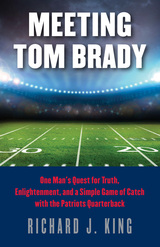 Meeting Tom Brady: One Man's Quest for Truth, Enlightenment, and a Simple Game of Catch with the Patriots Quarterback
Richard J. King
University Press of New England, 2015 Imagine that you are an average American man. You work hard and love football. Your present is a highway of unbounded opportunity, your future a far horizon unclouded by doubt. Then comes middle age. Who can you look to when the highway begins to crack, when opportunity shrinks to the size of a cubicle, and the horizon looms close? For Richard J. King, the answer is clear: Tom Brady. The legendary quarterback of the New England Patriots is not just a four-time Super Bowl champion, three-time MVP, and certain Hall of Famer. He is a male epitome. Gifted but humble. Driven but balanced. Aging but youthful. Devoted to both career and family. At the pinnacle of success but somehow still one of us. If anyone can point the way to living a worthy life, Tom Brady can. And so, at the start of the 2013 football season, King sets off in an ’88 Volkswagen minibus in a time-honored quest to answer life’s pressing questions—and to meet his hero. From training camp to the playoffs, from Spy-gate to Deflate-gate, King takes us on a tour of stadiums and bars across the country. Along the way he talks with players, sportswriters, and Patriots management, and poses the existential question, “What would you ask Tom Brady?” Meeting Tom Brady is funny and wise, a memoir of an eventful season in both King’s life and Brady’s—a determined pursuit, with uncertain results.
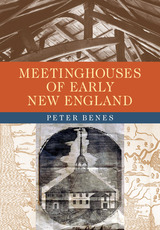 Meetinghouses of Early New England
Peter Benes
University of Massachusetts Press, 2012 Built primarily for public religious exercises, New England's wood-frame meetinghouses nevertheless were closely wedded to the social and cultural fabric of the neighborhood and fulfilled multiple secular purposes for much of the seventeenth and eighteenth centuries. As the only municipal building in the community, these structures provided locations for town and parish meetings. They also hosted criminal trials, public punishments and executions, and political and religious protests, and on occasion they served as defensive forts, barracks, hospitals, and places to store gunpowder.
Today few of these once ubiquitous buildings survive. Based on site visits and meticulous documentary research, Meetinghouses of Early New England identifies more than 2,200 houses of worship in the region during the period from 1622 to 1830, bringing many of them to light for the first time.
Within this framework Peter Benes addresses the stunning but ultimately impermanent blossoming of a New England "vernacular" tradition of ecclesiastical/ municipal architecture. He pinpoints the specific European antecedents of the seventeenth-century New England meetinghouse and traces their evolution through the eighteenth and early nineteenth centuries into Congregational, Presbyterian, and Baptist churches heavily influenced by an Anglican precedent that made a place of worship a "house of God." Undertaking a parish-by-parish examination, Benes draws on primary sources—original records, diaries, and contemporary commentators—to determine which religious societies in the region advocated (or resisted) this evolution, tying key shifts in meetinghouse architecture to the region's shifting liturgical and devotional practices.
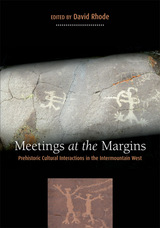 Meetings at the Margins: Prehistoric Cultural Interactions in the Intermountain West
David Rhode
University of Utah Press, 2012 Environmental conditions clearly influenced the cultural development of societies in the Intermountain West, but how did interactions with neighbors living along the region’s borders affect a society’s growth and advancement, its cultural integrity, and its long-term survival? Relationships among different societies are, of course, crucial to the spread of information, innovation, and belief systems; to the maintenance of exchange and mating networks; and to the forging of ethnic identity. In these ways and others, intergroup relationships can be as strong a force in shaping a society’s identity and future as are local social and economic dynamics. Meetings at the Margins focuses on the ways in which different societies in the Intermountain West profoundly influenced each other’s histories throughout the more than fourteen millennia of prehistoric occupation. Historically, inhabitants of this region frequently interacted with more than forty different groups—neighbors who spoke some two dozen different languages and maintained diverse economies. The contributors to this volume demonstrate that in the prehistoric Intermountain West, as elsewhere throughout the world, intergroup interactions were pivotal for the dynamic processes of cultural cohesion, differentiation, and change, and they affirm the value of a long-term, large-scale view of prehistory.
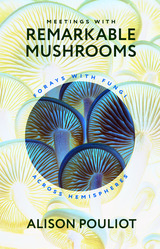 Meetings with Remarkable Mushrooms: Forays with Fungi across Hemispheres
Alison Pouliot
University of Chicago Press, 2023 A whirlwind journey through fungus frontiers that underscores how appreciating fungi is key to understanding our planet’s power and fragility. What can we learn from the lives of fungi? Splitting time between the northern and southern hemispheres, ecologist Alison Pouliot ensures that she experiences two autumns per year in the pursuit of fungi—from Australia’s deserts to Iceland’s glaciers to America’s Cascade Mountains. In Meetings with Remarkable Mushrooms, we journey alongside Pouliot, magnifiers in hand, as she travels the world. With Pouliot as our guide, we smell fire-loving truffles that transform their scent after burning to lure mammals who eat them and, ultimately, spread their spores. We spot the eerie glow of the ghost fungus, a deceptive entity that looks like an edible oyster mushroom but will soon heave back out—along with everything else in your stomach—if you take a bite. And we crawl alongside vegetable caterpillars, which are neither vegetable nor caterpillar but a fungus that devours insects from the inside out. Featuring stunning color photographs of these mycological miracles, Meetings with Remarkable Mushrooms shows that understanding fungi is fundamental for harmonizing with the natural world.
Meg
Jenni Fuller
Michigan Publishing, 2021
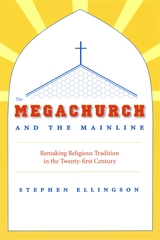 The Megachurch and the Mainline: Remaking Religious Tradition in the Twenty-first Century
Stephen Ellingson
University of Chicago Press, 2007 Religious traditions provide the stories and rituals that define the core values of church members. Yet modern life in America can make those customs seem undesirable, even impractical. As a result, many congregations refashion church traditions so they may remain powerful and salient. How do these transformations occur? How do clergy and worshipers negotiate which aspects should be preserved or discarded?
Focusing on the innovations of several mainline Protestant churches in the San Francisco Bay Area, Stephen Ellingson’s The Megachurch and the Mainline provides new understandings of the transformation of spiritual traditions. For Ellingson, these particular congregations typify a new type of Lutheranism—one which combines the evangelical approaches that are embodied in the growing legion of megachurches with American society’s emphasis on pragmatism and consumerism. Here Ellingson provides vivid descriptions of congregations as they sacrifice hymns in favor of rock music and scrap traditional white robes and stoles for Hawaiian shirts, while also making readers aware of the long history of similar attempts to Americanize the Lutheran tradition.
This is an important examination of a religion in flux—one that speaks to the growing popularity of evangelicalism in America.
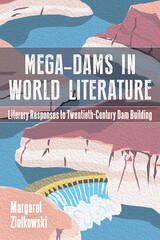 Mega-Dams in World Literature: Literary Responses to Twentieth-Century Dam Building
Margaret Ziolkowski
University of Wyoming Press, 2024 Mega-Dams in World Literature reveals the varied effects of large dams on people and their environments as expressed in literary works, focusing on the shifting attitudes toward large dams that emerged over the course of the twentieth century. Margaret Ziolkowski covers the enthusiasm for large-dam construction that took place during the mid-twentieth-century heyday of mega-dams, the increasing number of people displaced by dams, the troubling environmental effects they incur, and the types of destruction and protest to which they may be subject.
Using North American, Native American, Russian, Egyptian, Indian, and Chinese novels and poems, Ziolkowski explores the supposed progress that these structures bring. The book asks how the human urge to exploit and control waterways has affected our relationships to nature and the environment and argues that the high modernism of the twentieth century, along with its preoccupation with development, casts the hydroelectric dam as a central symbol of domination over nature and the power of the nation state.
Beyond examining the exultation of large dams as symbols of progress, Mega-Dams in World Literature takes a broad international and cultural approach that humanizes and personalizes the major issues associated with large dams through nuanced analyses, paying particular attention to issues engendered by high modernism and settler colonialism. Both general and specialist readers interested in human-environment relationships will enjoy this prescient book.
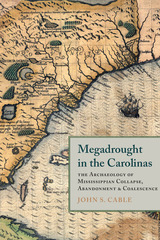 Megadrought in the Carolinas: The Archaeology of Mississippian Collapse, Abandonment, and Coalescence
John S. Cable
University of Alabama Press, 2020 Considers the Native American abandonment of the South Carolina coast
A prevailing enigma in American archaeology is why vast swaths of land in the Southeast and Southwest were abandoned between AD 1200 and 1500. The most well-known abandonments occurred in the Four Corners and Mimbres areas of the Southwest and the central Mississippi valley in the twelfth and thirteenth centuries and in southern Arizona and the Ohio Valley during the fifteenth century. In Megadrought in the Carolinas: The Archaeology of Mississippian Collapse, Abandonment, and Coalescence, John S. Cable demonstrates through the application of innovative ceramic analysis that yet another fifteenth-century abandonment event took place across an area of some 34.5 million acres centered on the South Carolina coast.
Most would agree that these sweeping changes were at least in part the consequence of prolonged droughts associated with a period of global warming known as the Medieval Climatic Anomaly. Cable strengthens this inference by showing that these events correspond exactly with the timing of two different geographic patterns of megadrought as defined by modern climate models.
Cable extends his study by testing the proposition that the former residents of the coastal zone migrated to surrounding interior regions where the effects of drought were less severe. Abundant support for this expectation is found in the archaeology of these regions, including evidence of accelerated population growth, crowding, and increased regional hostilities. Another important implication of immigration is the eventual coalescence of ethnic and/or culturally different social groups and the ultimate transformation of societies into new cultural syntheses. Evidence for this process is not yet well documented in the Southeast, but Cable draws on his familiarity with the drought-related Puebloan intrusions into the Hohokam Core Area of southern Arizona during the thirteenth and fourteenth centuries to suggest strategies for examining coalescence in the Southeast. The narrative concludes by addressing the broad implications of late prehistoric societal collapse for today’s human-propelled global warming era that portends similar but much more long-lasting consequences.
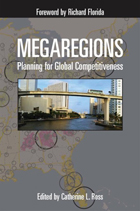 Megaregions: Planning for Global Competitiveness
Edited by Catherine L. Ross
Island Press, 2009 The concept of “the city” —as well as “the state” and “the nation state” —is passé, agree contributors to this insightful book. The new scale for considering economic strength and growth opportunities is “the megaregion,” a network of metropolitan centers and their surrounding areas that are spatially and functionally linked through environmental, economic, and infrastructure interactions. Recently a great deal of attention has been focused on the emergence of the European Union and on European spatial planning, which has boosted the region’s competitiveness. Megaregions applies these emerging concepts in an American context. It addresses critical questions for our future: What are the spatial implications of local, regional, national, and global trends within the context of sustainability, economic competitiveness, and social equity? How can we address housing, transportation, and infrastructure needs in growing megaregions? How can we develop and implement the policy changes necessary to make viable, livable megaregions? By the year 2050, megaregions will contain two-thirds of the U.S. population. Given the projected growth of the U.S. population and the accompanying geographic changes, this forward-looking book argues that U.S. planners and policymakers must examine and implement the megaregion as a new and appropriate framework. Contributors, all of whom are leaders in their academic and professional specialties, address the most critical issues confronting the U.S. over the next fifty years. At the same time, they examine ways in which the idea of megaregions might help address our concerns about equity, the economy, and the environment. Together, these essays define the theoretical, analytical, and operational underpinnings of a new structure that could respond to the anticipated upheavals in U.S. population and living patterns.
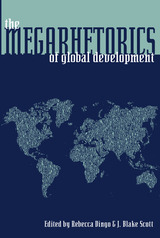 The Megarhetorics of Global Development
Rebecca Dingo
University of Pittsburgh Press, 2012
After World War II, an unprecedented age of global development began. The formation of the World Bank and the International Monetary Fund allowed war torn and poverty stricken nations to become willing debtors in their desire to entice Western investment and trade. New capital, it was foretold, would pave the way to political and economic stability, and the benefits would “trickle down” to even the poorest citizens. The hyperbole of this neocolonialism, however, has left many of these countries with nothing but compounded debt and unfulfilled promises.
The Megarhetorics of Global Development examines rhetorical strategies used by multinational corporations, NGOs, governments, banks, and others to further their own economic, political, or technological agendas. These wide-ranging case studies employ rhetorical theory, globalization scholarship, and analysis of cultural and historical dynamics to offer in-depth critiques of development practices and their material effects. By deconstructing megarhetorics, at both the local and global level, and following their paths of mobilization and diffusion, the concepts of “progress” and “growth” can be reevaluated, with the end goal of encouraging self-sustaining and ethical outcomes.
Megawatts and Megatons: The Future of Nuclear Power and Nuclear Weapons
Richard L. Garwin and Georges Charpak
University of Chicago Press, 2002 In Megawatts and Megatons, world-renowned physicists Richard L. Garwin and Georges Charpak offer an accessible, eminently well-informed primer on two of the most important issues of our time: nuclear weapons and nuclear power. They begin by explaining clearly and concisely how nuclear fission and fusion work in both warheads and reactors, and how they can impact human health. Making a strong and eloquent argument in favor of arms control, Garwin and Charpak outline specific strategies for achieving this goal worldwide. But they also demonstrate how nuclear power can provide an assured, economically feasible, and environmentally responsible source of energy—in a way that avoids the hazards of weapons proliferation. Numerous figures enliven the text, including cartoons by Sempé.
Mehinaku: The Drama of Daily Life in a Brazilian Indian Village
Thomas Gregor
University of Chicago Press, 1980 Thomas Gregor sees the Mehinaku Indians of central Brazil as performers of roles, engaged in an ongoing improvisational drama of community life. The layout of the village and the architecture of the houses make the community a natural theater in the round, rendering the villagers' actions highly visible and audible. Lacking privacy, the Mehinaku have become masters of stagecraft and impression management, enthusiastically publicizing their good citizenship while ingeniously covering up such embarrassments as extramarital affairs and theft.
 Meiji Graves in Happy Valley: Stories of Early Japanese Residents in Hong Kong
Yoshiko Nakano and Georgina Challen
Hong Kong University Press, 2024 Stories of Meiji-era Japanese residents and their final resting place in Hong Kong.
The Hong Kong Cemetery in Happy Valley is home to over 470 graves connected to the city’s Japanese population. Most of these graves belong to individuals who died during the Meiji era (1868–1912), a remarkable period of modernization and opening up of Japan that saw thousands of its inhabitants travel to other parts of the world to study, work, and settle. Who were these people? What were they doing in Hong Kong? And why were unbaptized Japanese buried in what was called at one time the "Protestant Cemetery"?
Hong Kong’s Meiji-era Japanese community was one of two halves. Company executives sat atop the social ladder and karayuki-san, or prostitutes, occupied the lower echelons, with tradespeople and professionals somewhere in between. By revealing the personal journeys of these mostly forgotten Japanese, the authors aim to add to transnational perspectives on Hong Kong and Japan during the late nineteenth and early twentieth centuries, as well as increase recognition of this fragmented community’s place in the development of this diverse city.
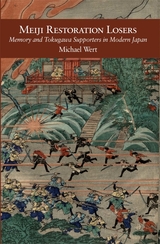 Meiji Restoration Losers: Memory and Tokugawa Supporters in Modern Japan
Michael Wert
Harvard University Press This book is about the “losers” of the Meiji Restoration and the supporters who promoted their legacy. Although the violence of the Meiji Restoration is typically downplayed, the trauma was real, and those who felt marginalized from the mainstream throughout modern Japan looked to these losers as models of action.
Using a wide range of sources, from essays by former Tokugawa supporters like Fukuzawa Yukichi to postwar film and “lost decade” manga, Michael Wert traces the shifting portrayals of Restoration losers. By highlighting the overlooked sites of memory such as legends about buried gold, the awarding of posthumous court rank, or fighting over a disembodied head, Wert illustrates how the process of commemoration and rehabilitation allows individuals a voice in the formation of national history. He argues that the commingling of local memory activists and nationally-known politicians, academics, writers, and treasure hunters formed interconnecting memory landscapes that promoted local figures as potential heroes in modern Japan.
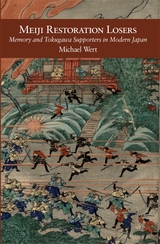 Meiji Restoration Losers: Memory and Tokugawa Supporters in Modern Japan
Michael Wert
Harvard University Press, 2013 This book is about the “losers” of the Meiji Restoration and the supporters who promoted their legacy. Although the violence of the Meiji Restoration is typically downplayed, the trauma was real, and those who felt marginalized from the mainstream throughout modern Japan looked to these losers as models of action.
Using a wide range of sources, from essays by former Tokugawa supporters like Fukuzawa Yukichi to postwar film and “lost decade” manga, Michael Wert traces the shifting portrayals of Restoration losers. By highlighting the overlooked sites of memory such as legends about buried gold, the awarding of posthumous court rank, or fighting over a disembodied head, Wert illustrates how the process of commemoration and rehabilitation allows individuals a voice in the formation of national history. He argues that the commingling of local memory activists and nationally-known politicians, academics, writers, and treasure hunters formed interconnecting memory landscapes that promoted local figures as potential heroes in modern Japan.
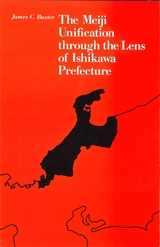 The Meiji Unification through the Lens of Ishikawa Prefecture
James C. Baxter
Harvard University Press, 1994 Credit for the swift unification of Japan following the 1868 overthrow of the Tokugawa shogunate is usually given to the national leaders who instigated the coup and formed the new Meiji government. But is brilliant leadership at the top sufficient to explain how regional separatist tendencies and loyalties to the old lords were overcome in the formation of a nationally unified state? On the contrary, argues James C. Baxter. Though plans were drawn up by policy makers in Tokyo, the efforts of citizens all over the country were required to implement these plans and create a sense of national identity among local populations.
Drawing on extensive archival resources, Baxter describes the transformation of the Tokugawa domain of Kaga into the Meiji prefecture of Ishikawa. The result is a richly detailed study that helps explain how Japan achieved national unity without the bloody struggles that have often accompanied modernization and nation-building.
 Meiroku Zasshi: Journal of the Japanese Enlightenment
William R. Braisted
Harvard University Press The Meiroku Zasshi is recognized as the single most important source for thought during the Japanese enlightenment that followed the Mei Restoration of 1868. The men who wrote for the Meiroku Zasshi (Meiroku refers to the sixth year of Meiji, that is, 1873, and zasshi means magazine) were the encyclopedists of the Meiji enlightenment. Trained as Western experts during the reopening of the country after 1853, they introduced mid-nineteenth-century European and American culture to Japan. The forty-three issues of the magazine represent a broad sampling of the way in which this culture was presented. The influence of the Meiroku Zasshi on the nation builders of Meiji Japan was second to that of the writings of the great enlightener, Fukuzawa Yukichi. This crucial work in Japanese cultural history is now accessible to readers in a precise, beautifully rendered translation by William R. Braisted.
In the magazine’s pages, the Meirokusha writers expressed their views on such concerns of the period as a popularly elected assembly, the separation of church and state, the status of women, economic policy, chemistry, language reform, and the nature of knowledge. Their prose style reflected their modernity—terse, dignified, less artificial than the traditional literary modes. They also translated articles from languages other than Dutch (until that time the only Western language known to Japanese scholars).
Nowhere else can one find gathered together such representative writings by the leading intellectuals of the day, many of them former samurai, who fused their country’s tradition of practical studies with the humane and useful knowledge of the West. Complete with Braisted’s highly informative introduction, this full translation of the Meiroku Zasshi suggests why Japan’s modern experience has been unique.
Mekong Delta: Ecology, Economy, and Revolution, 1860-1960
Pierre Brocheux
University of Wisconsin Press, 1995 Mining a wealth of archival sources in France and Vietnam, Pierre Brocheux constructs a fascinating picture of how French capital and technology transformed the Mekong Delta. By draining the swamps and encouraging a particular pattern of Vietnamese settlement, the French cultivated a volatile society, bound together by lines of credit and poised at the brink of social revolution. From the cutting of the first canals in the 1880s to the eruption of the Viet Cong’s insurgency in the 1950s, this book illuminates the subtle interactions between ecology and social change in a tropical delta. The Mekong Delta is valuable for students of the Vietnamese Revolution and for scholars of peasant movements around the globe. It fills a major gap in our knowledge of the social change that swept the great deltas of Southeast Asia.
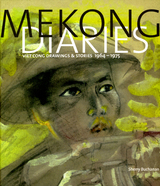 Mekong Diaries: Viet Cong Drawings and Stories, 1964-1975
Sherry Buchanan
University of Chicago Press, 2008 In May 1965, vice president Hubert Humphrey declared that “the Viet Cong has committed the most unbelievable acts of terrorism the world has ever known.” And throughout the long conflict in Vietnam, Americans similarly demonized the enemy fighters as reds, gooks, and fanatical killers. Offering a radically different view of these supposedly savage soldiers, Mekong Diaries presents never-before-published drawings, poems, letters, and oral histories by ten of the most celebrated Viet Cong war artists.
These guerrilla artists—some military officers and some civilians—lived clandestinely with the fighters, moving camp alongside them, going on reconnaissance missions, and carrying their sketchbooks, ink, and watercolors into combat. Trained by professors from the Hanoi Institute of Fine Arts who journeyed down the perilous Ho Chi Minh Trail to ensure a pictorial history of the war, they recorded battles and events from Operation Junction City to Khe Sanh to the Tet Offensive. They also sketched as the spirit moved them, rendering breathtaking landscapes, hut and bunker interiors, activities at base camps, troops on the move, portraits for the families of fallen soldiers, and the unimaginable devastation that the conflict left in its wake.
Their collective record—which Sherry Buchanan skillfully compiles here—is an extraordinary historical and artistic document of people at war. As such, it serves as a powerful response to the self-centeredness of American accounts of Vietnam, filling a profound gap in our national memory by taking us into the misunderstood worlds of those whom we once counted among our worst enemies.
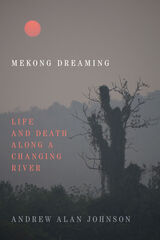 Mekong Dreaming: Life and Death along a Changing River
Andrew Alan Johnson
Duke University Press, 2020 The Mekong River has undergone vast infrastructural changes in recent years, including the construction of dams across its main stream. These projects, along with the introduction of new fish species, changing political fortunes, and international migrant labor, have all made a profound impact upon the lives of those residing on the great river. It also impacts how they dream. In Mekong Dreaming, Andrew Alan Johnson explores the changing relationship between the river and the residents of Ban Beuk, a village on the Thailand-Laos border, by focusing on the effect that construction has had on human and inhuman elements of the villagers' world. Johnson shows how inhabitants come to terms with the profound impact that remote, intangible, and yet powerful forces—from global markets and remote bureaucrats to ghosts, spirits, and gods—have on their livelihoods. Through dreams, migration, new religious practices, and new ways of dwelling on a changed river, inhabitants struggle to understand and affect the distant, the inassimilable, and the occult, which offer both sources of power and potential disaster.
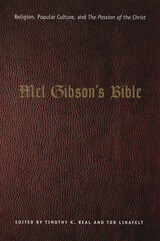 Mel Gibson's Bible: Religion, Popular Culture, and "The Passion of the Christ"
Edited by Timothy K. Beal and Tod Linafelt
University of Chicago Press, 2005 The Passion of the Christ was an extraordinary media event. But the film has also, and more importantly, been a religious phenomenon. Mel Gibson's professed intent was to create not just a cinematic experience but a spiritual one. And he has succeeded for many moviegoers, most notably evangelical Christians, of whom millions have embraced the film as a presentation of Holy Scripture, a twenty-first century incarnation of the Word.
In this volume, biblical scholars Timothy K. Beal and Tod Linafelt—along with an esteemed group of contributors—offer a provocative range of views on The Passion of the Christ. Their book is organized in three parts. The first analyzes the film in terms of its religious foundations, including the Gospels and nonbiblical religious texts: What are the film's literary sources and how does it use them? In what ways does the medium of film require a radically different way of representing gospel narrative? The second group of essays focuses on the ethical and theological implications of the film's presentation of the Christian gospel: What do we make of its representations of female sexuality? What are the implications of focusing on the Passion in terms of atonement rather than social justice? Finally, the third section explores the film as a pop cultural phenomenon: How has the film worked to create a sense of insider status for some and alienated so many others? What can we learn about the religious dimensions of contemporary mass culture from the film's reception?
Whether one is inspired or appalled by The Passion of the Christ, there can be no question that it is a defining moment in the cultural afterlife of the Bible. This volume tries to make sense of that moment and will prove to be a touchstone for adherents and detractors of the film alike.
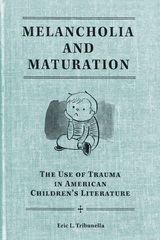 Melancholia and Maturation: The Use of Trauma in American Children's Literature
Eric L. Tribunella
University of Tennessee Press, 2009
“Coming of age” in children’s fiction often means achieving maturity through the experience of trauma. In classics ranging from Old Yeller to The Outsiders, a narrative of psychological pain defies expectations of childhood as a time of innocence and play. In this provocative new book, Eric L. Tribunella explores why trauma, especially the loss of a loved object, occurs in some of the most popular and critically acclaimed twentieth-century American fiction for children.
Tribunella draws on queer theory and feminist revisions of Freud’s notion of melancholia, which is described as a fundamental response to loss, arguing that the low-grade symptoms of melancholia are in fact what characterize the mature, sober, and responsible American adult. Melancholia and Maturation looks at how this effect is achieved in a society that purports to protect youngsters from every possible source of danger, thus requiring melancholia to be induced artificially.
Each of the book’s five chapters focuses on a different kind of lost object sacrificed so as to propel the child toward a distinctively gendered, sexual, ethical, and national adulthood—from same-sex friends to the companionship of boy-and-his-dog stories, from the lost ideals of historical fiction about the American Revolution to the children killed or traumatized in Holocaust novels. The author examines a wide spectrum of works—including Jack London’s dog tales, the contemporary “realistic” novels of S. E. Hinton, and Newbery Medal winners like Johnny Tremain and Bridge to Terabithia.
Tribunella raises fundamental questions about the value of children’s literature as a whole and provides context for understanding why certain books become required reading for youth.
Eric L. Tribunella is assistant professor of English at the University of Southern Mississippi. His articles have been published in Children’s Literature Association Quarterly, Children’s Literature in Education, The Lion and the Unicorn: A Critical Journal of Children’s Literature, and Children’s Literature.
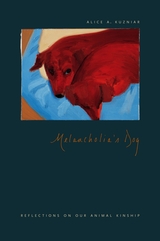 Melancholia's Dog: Reflections on Our Animal Kinship
Alice A. Kuzniar
University of Chicago Press, 2006 Bred to provide human companionship, dogs eclipse all other species when it comes to reading the body language of people. Dog owners hunger for a complete rapport with their pets; in the dog the fantasy of empathetic resonance finds its ideal. But cross-species communication is never easy. Dog love can be a precious but melancholy thing.
An attempt to understand human attachment to the canis familiaris in terms of reciprocity and empathy, Melancholia’sDog tackles such difficult concepts as intimacy and kinship with dogs, the shame associated with identification with their suffering, and the reasons for the profound mourning over their deaths. In addition to philosophy and psychoanalysis, Alice A. Kuzniar turns to the insights and images offered by the literary and visual arts—the short stories of Ivan Turgenev and Franz Kafka, the novels of J. M. Coetzee and Rebecca Brown, the photography of Sally Mann and William Wegman, and the artwork of David Hockney and Sue Coe. Without falling into sentimentality or anthropomorphization, Kuzniar honors and learns from our canine companions, above all attending to the silences and sadness brought on by the effort to represent the dog as perfectly and faithfully as it is said to love.
 Melancholy and Society
Wolf Lepenies
Harvard University Press, 1992 Rare is the person who has never known the feelings of apathy, sorrow, and uselessness that characterize the affliction known as melancholy. In this book, one of Europe's leading intellectuals shows that melancholy is not only a psychological condition that affects individuals but also a social and cultural phenomenon that can be of considerable help in understanding the modern middle class. His larger topic is, in fact, modernity in general.
Lepenies focuses not on what melancholy is but on what it means when people claim to be melancholy. His aim is to examine the origin and spread of the phenomenon with relation to particular social milieux, and thus he looks at a variety of historical manifestations: the fictional utopian societies of the Renaissance, the ennui of the French aristocracy in the seventeenth century, the cult of inwardness and escapism among the middle class in eighteenth-century Germany. In each case he shows that the human condition is shaped by historical and societal forces--that apathy, boredom, utopian idealism, melancholy, inaction, and excessive reflection are the correlates of class-wide powerlessness and the failure of purposeful efforts.
Lepenies makes inventive use of an extraordinary range of sociological, philosophical, and literary sources, from Robert Burton's Anatomy of Melancholy to the ideas of contemporary theorists such as Robert K. Merton and Arnold Gehlen. His study gains added richness from its examination of writers whose works express the melancholy of entire social classes--writers such as La Rochefoucauld, Goethe, and Proust. In his masterly analysis of these diverse ideas and texts, he illuminates the plight of people who have been cast aside by historical change and shows us the ways in which they have coped with their distress. Historians, sociologists, psychologists, students of modern literature, indeed anyone interested in the problems of modernity will want to read this daring and original book.
Melancholy Drift: Marking Time in Chinese Cinema
Jean Ma
Hong Kong University Press, 2010 Ma offers an innovative study of three provocative Chinese directors Wong Kar-wai, Hou Hsiao-hsien, and Tsai Ming-liang. Focusing on the highly stylized and nonlinear configurations of time in each director’s films, she argues that these directors have brought new global respect for Chinese cinema in amplifying motifs of loss, nostalgia, haunting, absence and ephemeral poetics. Hou, Tsai, and Wong all insist on the significance of being out of time, not merely out of place, as a condition of global modernity. Ma argues that their films collectively foreground the central place of contemporary Chinese films in a transnational culture of memory, characterized by a distinctive melancholy that highlights the difficulty of binding together past and present into a meaningful narrative.
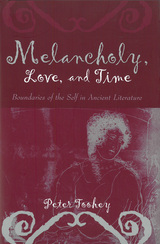 Melancholy, Love, and Time: Boundaries of the Self in Ancient Literature
Peter Toohey
University of Michigan Press, 2004
Ancient literature features many powerful narratives of madness, depression, melancholy, lovesickness, simple boredom, and the effects of such psychological states upon individual sufferers. Peter Toohey turns his attention to representations of these emotional states in the Classical, Hellenistic, and especially the Roman imperial periods in a study that illuminates the cultural and aesthetic significance of this emotionally charged literature. His probing analysis shows that a shifting representation of these afflicted states, and the concomitant sense of isolation from one's social affinities and surroundings, manifests a developing sense of the self and self-consciousness in the ancient world.
This book makes important contributions to a variety of disciplines including classical studies, comparative literature, literary and art history, history of medicine, history of emotions, psychiatry, and psychology.
Peter Toohey is Professor and Department Head of Greek and Roman Studies at the University of Calgary, Canada.
Melanie Klein: Her World and Her Work
Phyllis Grosskurth
Harvard University Press, 1987 Underestimated until recently in America, Melanie Klein was a leading figure in psychoanalytic circles from the 1920s until her death in 1960. From the moment she read Freud’s paper On Dreams she was enraptured, converted, and dedicated to psychoanalysis. She was the first European psychoanalyst to become a member of the British Psychoanalytical Society, and ultimately she became its dominant influence. Drawing on a wealth of hitherto unexplored documents as well as extensive interviews with people who knew and worked with Klein, Phyllis Grosskurth has written a superb account of this complicated woman and her theories—theories that are still growing in influence.
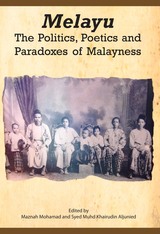 Melayu: The Politics, Poetics and Paradoxes of Malayness
Edited by Maznah Mohamad and Syed Muhd Khairudin Aljunied
National University of Singapore Press, 2012 People within the Malay world hold strong but diverse opinions about the meaning of the word Melayu, which can be loosely translated as Malayness. Questions of whether the Filipinos are properly called "Malay", or the Mon-Khmer speaking Orang Asli in Malaysia, can generate heated debates. So too can the question of whether it is appropriate to speak of a kebangsaan Melayu (Malay as nationality) as the basis of membership within an aspiring postcolonial nation-state, a political rather than a cultural community embracing all residents of the Malay states, including the immigrant Chinese and Indian population.
In Melayu: The Politics, Poetics and Paradoxes of Malayness, the contributors examine the checkered, wavering and changeable understanding of the word Melayu by considering hitherto unexplored case studies dealing with use of the term in connection with origins, nations, minority-majority politics, Filipino Malays, Riau Malays, Orang Asli, Straits Chinese literature, women's veiling, vernacular television, social dissent, literary women, and modern Sufism. Taken as a whole, this volume offers a creative approach to the study of Malayness while providing new perspectives to the studies of identity formation and politics of ethnicity that have wider implications beyond the Southeast Asian region.
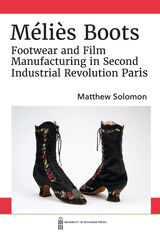 Méliès Boots: Footwear and Film Manufacturing in Second Industrial Revolution Paris
Matthew Solomon
University of Michigan Press, 2022 Before he became an influential cinematic innovator, Georges Méliès (1861–1938) was a maker of deluxe French footwear, an illusionist, and a caricaturist. Proceeding from these beginnings, Méliès Boots traces how the full trajectory of Georges Méliès’ career during the late-nineteenth and early-twentieth centuries, along with the larger cultural and historical contexts in which Méliès operated, shaped his cinematic oeuvre. Solomon examines Méliès’ unpublished drawings and published caricatures, the role of laughter in his magic theater productions, and the constituent elements of what Méliès called "the new profession of the cinéaste." The book also reveals Méliès' connections to the Incohérents, a group of ephemeral artists from the 1880s, demonstrating the group’s relevance for Méliès, early cinema, and modernity. By positioning Méliès in relation to the material culture of his time, Solomon demonstrates that Méliès’ work was expressive of a distinctly modern, and modernist, sensibility that appeared in France during the 1880s in the wake of the Second Industrial Revolution.
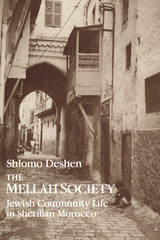 The Mellah Society: Jewish Community Life in Sherifian Morocco
Shlomo Deshen
University of Chicago Press, 1989 The Mellah Society is a compact yet detailed and fascinating account of Jewish life in precolonial Morocco, based on the voluminous but rarely studied writings of eighteenth- and nineteenth-century Judeo-Moroccan sages.
Shlomo Deshen, author of several books on North African Jewish immigrants to Israel, here turns his attention to the past. Taking as his focus the tension between individualism and communal authority—symbolized by the walls of the mellahs, the Jewish quarters—he applies to traditional Moroccan Jewish society questions of concern to sociologists everywhere regarding political organization, economic activity, religion, and the family.
From such documents as private correspondence, archival photographs, and the legal commentaries of rabbis who served in the Jewish community courts, Deshen draws out details of daily life: disputes between spouses, businessmen, craftsmen, and inheritors; the ramifications of marriage contracts; and claims involving community taxes and extortions by Muslim potentates. Linking this material with recent historical and anthropological studies of the Maghreb, Deshen reconstructs a community about which little has been known and places it squarely within the context of traditional Moroccan society.
Individual chapters deal with relations between Muslims and Jews, the material conditions of Jewish life, and the nature of politics within the mellah. Deshen devotes particular attention to the nature of the Moroccan rabbinate, the sociology of the mellah synagogue, lay community leadership, and the historic role of the Sephardic heritage in Morocco after the expulsion from medieval Spain. His close study of the nature of the extended family in traditional Morocco corrects popular misconceptions.
Originally published in Israel in 1983, now translated and expanded by its author, The Mellah Society draws upon Middle Eastern and Jewish history, textual Judaic studies, and social anthropology to make an original contribution that will interest scholars of the Middle East and North Africa as well as anyone concerned with Jewish history and ethnicity.
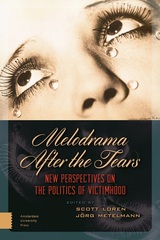 Melodrama After the Tears: New Perspectives on the Politics of Victimhood
Edited by Scott Loren and Jörg Metelmann
Amsterdam University Press, 2016 Melodrama, it is said, has expanded beyond the borders of genre and fiction to become a pervasive cultural mode. It encompasses distinct signifying practices and interpretive codes for meaning-making that help determine the parameters of identification and subject formation. From the public staging of personal suffering or the psychologization of the self in relation to consumer capitalism, to the emotionalization and sentimentalization of national politics, contributions to this volume address the following question: If melodramatic models of sense-making have become so culturally pervasive and emotionally persuasive, what is the political potential of melodramatic victimhood and where are its political limitations?
This volume represents both a condensation and an expansion in the growing field of melodrama studies. It condenses elements of theory on melodrama by bringing into focus what it recognizes to be the locus for subjective identification within melodramatic narratives: the victim. On the other hand, it provides an expansion by going beyond the common methodology of primarily examining fictive works - be they from the stage, the screen or the written word - for their explicit or latent commentary on and connection to the historical contexts within which they are produced. Inspiration for the volume is rooted in a curiosity about melodramatic forms purported to increasingly characterize aspects of both the private and the social sphere in occidental and western-oriented societies.
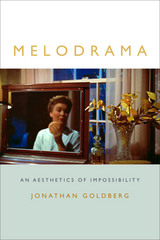 Melodrama: An Aesthetics of Impossibility
Jonathan Goldberg
Duke University Press, 2016 Offering a new queer theorization of melodrama, Jonathan Goldberg explores the ways melodramatic film and literature provide an aesthetics of impossibility. Focused on the notion of what Douglas Sirk termed the "impossible situation" in melodrama, such as impasses in sexual relations that are not simply reflections of social taboo and prohibitions, Goldberg pursues films by Rainer Werner Fassbinder and Todd Haynes that respond to Sirk's prompt. His analysis hones in on melodrama's original definition--a form combining music and drama--as he explores the use of melodrama in Beethoven's opera Fidelio, films by Alfred Hitchcock, and fiction by Willa Cather and Patricia Highsmith, including her Ripley novels. Goldberg illuminates how music and sound provide queer ways to promote identifications that exceed the bounds of the identity categories meant to regulate social life. The interaction of musical, dramatic, and visual elements gives melodrama its indeterminacy, making it resistant to normative forms of value and a powerful tool for creating new potentials.
Melodrama as Provocateur
Linda Williams. Edited by Christine Gledhill, Laura Horak, Elizabeth R. Anker
Duke University Press, 2026 As one of the most influential contemporary film scholars, Linda Williams brought her critical feminist lens to some of society’s most maligned and underappreciated film genres. Melodrama as Provocateur showcases what was to be Williams's last project in which, insisting on melodrama as a cross-generic, cross-media mode, she investigates the divergence between French and American attitudes to film melodrama. A diverse group of scholars respond to her provocations, rethinking melodrama’s transnational, transmedia histories and potential futures. Their contributions examine how melodrama became, as Williams argues, the default mode of contemporary media, and demonstrate how it plays an increasingly powerful role in public discourse and political rhetoric today.
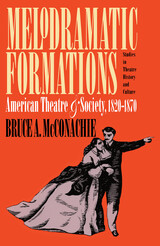 Melodramatic Formations: American Theatre and Society, 1820-1870
Bruce A. Mcconachie
University of Iowa Press, 1992 The middle years of the nineteenth century were a time of dynamic artistic and social changes in America. Now, Melodramatic Formations is the first study to trace these changes in popular stage melodrama's production, dramatic form, and audience reception. Bruce McConachie shows how the theatrical mutability that characterized the years 1820 to 1870 is inextricably tied to the decline of elite paternalism and republicanism and the rise of bourgeois rationalism and respectability. Taking a rigorous interdisciplinary approach, McConachie examines several historical regularities of production, genre, and audience. Here theatre (and its drama) has at long last been returned to its general culture, rather than being treated as an isolated phenomenon. Ultimately, he develops a new notion of a theatrical formation—a construct where groups of spectators and theatre performers produce each other as artists-to-be-experienced and audiences-to-be-entertained. Throughout Melodramatic Formations McConachie illustrates how theatre both maintains and produces various ideologies; he convincingly shows that theatre is a major player in our social and cultural history. This book will be of interest to all in American studies, theatre history, and American cultural history.
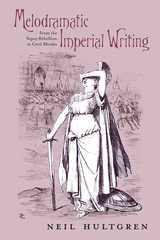 Melodramatic Imperial Writing: From the Sepoy Rebellion to Cecil Rhodes
Neil Hultgren
Ohio University Press, 2014 Melodrama is often seen as a blunt aesthetic tool tainted by its reliance on improbable situations, moral binaries, and overwhelming emotion, features that made it a likely ingredient of British imperial propaganda during the late nineteenth century. Yet, through its impact on many late-Victorian genres outside of the theater, melodrama developed a complicated relationship with British imperial discourse. Melodramatic Imperial Writing positions melodrama as a vital aspect of works that underscored the contradictions and injustices of British imperialism. Beyond proving useful for authors constructing imperialist fantasies or supporting unjust policies, the melodramatic mode enabled writers to upset narratives of British imperial destiny and racial superiority. Neil Hultgren explores a range of texts, from Dickens’s writing about the 1857 Sepoy Rebellion to W. E. Henley’s imperialist poetry and Olive Schreiner’s experimental fiction, in order to trace a new and complex history of British imperialism and the melodramatic mode in late-Victorian writing.
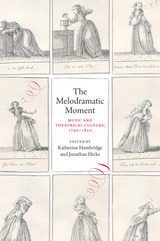 The Melodramatic Moment: Music and Theatrical Culture, 1790–1820
Edited by Katherine G Hambridge and Jonathan Hicks
University of Chicago Press, 2018 We seem to see melodrama everywhere we look—from the soliloquies of devastation in a Dickens novel to the abject monstrosity of Frankenstein’s creation, and from Louise Brooks’s exaggerated acting in Pandora’s Box to the vicissitudes endlessly reshaping the life of a brooding Don Draper.
This anthology proposes to address the sometimes bewilderingly broad understandings of melodrama by insisting on the historical specificity of its genesis on the stage in late-eighteenth-century Europe. Melodrama emerged during this time in the metropolitan centers of London, Paris, Vienna, and Berlin through stage adaptations of classical subjects and gothic novels, and they became famous for their use of passionate expression and spectacular scenery. Yet, as contributors to this volume emphasize, early melodramas also placed sound at center stage, through their distinctive—and often disconcerting—alternations between speech and music. This book draws out the melo of melodrama, showing the crucial dimensions of sound and music for a genre that permeates our dramatic, literary, and cinematic sensibilities today.
A richly interdisciplinary anthology, The Melodramatic Moment will open up new dialogues between musicology and literary and theater studies.
 The Melody of Theology: A Philosophical Dictionary
Jaroslav Pelikan
Harvard University Press, 1988 The German Romantic theologian and philosopher Schleiermacher wrote, "The virtuosity (or special calling) of a person is at the same time the melody of that person's life, and it remains a simple, meager series of notes unless religion, with its endlessly rich variety, accompanies it with all notes and raises the simple song to a full-voiced, glorious harmony." It is around this melody that Jaroslav Pelikan, a great theologian of our own day, weaves the polyphonic threads of philosophy, theology, morals, history, and personality to create a singular portrait of his life and work.
The Melody of Theology is really two books in one: a dictionary in which a reader can browse through piquant explorations of some of the most interesting topics in Christian theology, and an intellectual autobiography in which Jaroslav Pelikan has used those topics to give an account of the traditions to which he owes the formation of his own mind and spirit. As he says, "An intellectual autobiography in the format of a 'philosophical dictionary' permits the self-indulgence of employing the seeming objectivity of some eighty-two entries, arranged in the impersonal sequence of alphabetical order, to express a completely personal set of prejudices."
Among the large topics addressed in this volume are the Bible, Faith, Grace, Reformation and Renaissance, and Sin. Among the towering figures of religion and theology are Dante, Ralph Waldo Emerson, Erasmus, Gibbon, Martin Luther, Paul the Apostle, and Schleiermacher. Among the technical topics analyzed are Apocatastasis, Christian Creeds, the term "Ecumenical," Eschatology, Patristics, and the Trinity. The Melody of Theology belongs on the bookshelf of anyone who wants to study a history and tradition that precede us and will continue after us, and also of the reader who would like to make the acquaintance of a subtle analytic mind and a generous open heart.
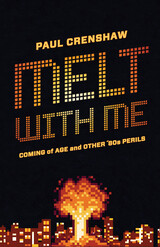 Melt with Me: Coming of Age and Other ’80s Perils
Paul Crenshaw
Ohio State University Press, 2023 At the intersection of 1980s pop culture, the Cold War, and the trials of coming of age sits Melt with Me. Paul Crenshaw takes up a range of topics from Star Wars to video games, Choose Your Own Adventure books to the Satanic Panic. Blending the personal with the historical, levity with gravity, Crenshaw shows how pop culture shaped those who grew up in 1980s America: how Reagan’s Strategic Defense Initiative drove fears of nuclear war, how professional wrestling taught us everyone was either a good guy or a bad guy, how Bugs Bunny cartoons reflected the absurdity of war and mutually assured destruction, and how video games taught young boys, in particular, that no matter how hard they tried to save it, the world would end itself. Reflecting on the decade and its dark influence on fear-based notions of nation and manhood, Crenshaw writes, “All this reminds me I’m still afraid of the same things I was afraid of as a child. Some days I think the movies are real and we’re watching the last hour of humanity. You’ll have to decide if there’s any hope.”
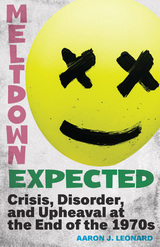 Meltdown Expected: Crisis, Disorder, and Upheaval at the end of the 1970s
Aaron J. Leonard
Rutgers University Press, 2024 In January 1978, President Jimmy Carter proclaimed that “There is all across our land a growing sense of peace and a sense of common purpose.” Yet in the ensuing months, a series of crises disturbed that fragile sense of peace, ultimately setting the stage for Reagan’s decisive victory in 1980 and ushering in the final phase of the Cold War.
Meltdown Expected tells the story of the power shifts from late 1978 through 1979 whose repercussions are still being felt. Iran’s revolution led to a hostage crisis while neighbouring Afghanistan became the site of a proxy war between the USSR and the US, who supplied aid to Islamic mujahideen fighters that would later form the Taliban. Meanwhile, as tragedies like the Jonestown mass suicide and the assassination of Harvey Milk captured the nation’s attention, the government quietly reasserted and expanded the FBI’s intelligence powers. Drawing from recently declassified government documents and covering everything from Three Mile Island to the rise of punk rock, Aaron J. Leonard paints a vivid portrait of a tumultuous yet pivotal time in American history.
 The Melting Pot and the Altar: Marital Assimilation in Early Twentieth-Century Wisconsin
Richard M. Bernard
University of Minnesota Press, 1981 The Melting Pot and the Altar was first published in 1981. Minnesota Archive Editions uses digital technology to make long-unavailable books once again accessible, and are published unaltered from the original University of Minnesota Press editions. Recent studies of assimilation in nineteenth-century America have focused on the ways in which immigrant groups maintained separate identities rather than on their absorption in American society. In The Melting Pot and the Altar Richard M. Bernard puts to test the theory of the melting pot. He concludes that although cultural and structural pluralism deserves attention so does interaction between the host society and the immigrants Through extensive quantitative analysis of census reports and marriage records Bernard studies the pattern of intergroup marriage - the ultimate test of assimilation - during a period of massive migration to this country. His research on eleven immigrant groups and the native-born population in Wisconsin suggests that there was considerable intergroup mixing. Moreover, once allowance is made for differing times of arrival, immigration generations, and rural or urban residences, the assimilative patterns of Western and Eastern European groups were remarkably similar. An examination of several factors, such as occupation, age, location, and birthplace of parents, shows that certain demographic and social characteristics rather than any particular ethnic identification increased the likelihood that an individual would marry outside his or her group. The Melting Pot and the Altar is the first multiple variable analysis of marital assimilation in an entire state whose immigration patterns is similar to that of the nation. Both historians and sociologist will find this work of interest as an example of quantitative methodology and for its new evidence on an important subject.
Melting Pots and Rainbow Nations: Conversations about Difference in the United States and South Africa
Jacklyn Cock and Alison Bernstein
University of Illinois Press, 2002 This passionate, intelligent commentary is an invigorating look at the implications of difference and diversity in two contrasting but similar societies: the United States and South Africa. Melting Pots and Rainbow Nations addresses how differences--of gender, race, culture, biology, and sexual orientation--are variously understood and acted on in both countries. The authors argue that the concepts of difference and diversity, although valuable, are hollow if disconnected from specific social and historical contexts in which power relations create and perpetuate disadvantage. Their thoughtful exploration includes accounts of their own experiences of difference and their perspectives on such pioneering women as Elizabeth Bishop, Frene Ginwala, Audre Lorde, Ruth First, Jane Goodall, and Mamphela Ramphele.
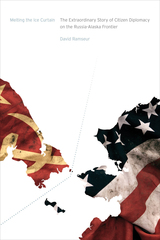 Melting the Ice Curtain: The Extraordinary Story of Citizen Diplomacy on the Russia-Alaska Frontier
David Ramseur
University of Alaska Press, 2017 Just five years after a Soviet missile blew a civilian airliner out of the sky over the North Pacific, an Alaska Airlines jet braved Cold War tensions to fly into tomorrow. Crossing the Bering Strait between Alaska and the Russian Far East, the 1988 Friendship Flight reunited Native peoples of common languages and cultures for the first time in four decades. It and other dramatic efforts to thaw what was known as the Ice Curtain launched a thirty-year era of perilous, yet prolific, progress.
Melting the Ice Curtain tells the story of how inspiration, courage, and persistence by citizen-diplomats bridged a widening gap in superpower relations. David Ramseur was a first-hand witness to the danger and political intrigue, having flown on that first Friendship Flight, and having spent thirty years behind the scenes with some of Alaska’s highest officials. As Alaska celebrates the 150th anniversary of its purchase, and as diplomatic ties with Russia become perilous, Melting the Ice Curtain shows that history might hold the best lessons for restoring diplomacy between nuclear neighbors.
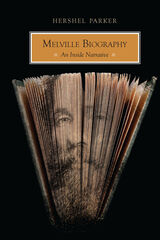 Melville Biography: An Inside Narrative
Hershel Parker
Northwestern University Press, 2013 Melville Biography: An Inside Narrative is Hershel Parker’s history of the writing of Melville biographies, enriched by a lifetime of intimate working partnerships with great Melville scholars of different generations and by the author’s experience of successive phases of literary criticism. Throughout this bold book, Hershel Parker champions archival-based biography and the all-but-lost art of embodying such scholarship in literary criticism. First is a mesmerizing autobiographical account of what went into creating the award-winning and comprehensive Herman Melville: A Biography. Then Parker traces six decades of the “unholy war” waged against biographical scholarship, in which critics repeatedly imposed the theory of organic unity on Melville’s disrupted life—not just on his writings—while truncating his body of work and ignoring his study of art and aesthetics. In this connection, Parker celebrates discoveries made by “divine amateurs,” before throwing open his workshop to challenge ambitious readers with research projects. This is a book for Melville fans and Parker fans, as well as for readers, writers, and would-be writers of biography.
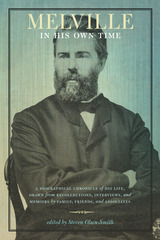 Melville in His Own Time: A Biographical Chronicle of His Life, Drawn from Recollection, Interviews, and Memoirs by Family, Friends, and Associates
Steven Olsen-Smith
University of Iowa Press, 2015 Owing to the decline of his contemporary fame and to decades of posthumous neglect, Herman Melville remains enigmatic to readers despite his status as one of America’s most securely canonical authors. Born into patrician wealth but plunged into poverty as a child, in 1840 he signed aboard the whaleship Acushnet in the midst of a nationwide depression and sailed to the South Pacific. At the Marquesas Islands, he deserted and lived for a time among one of the group’s last unsubjugated tribes. Upon his return home, he achieved overnight success with a book based on his experiences, Typee (1846).
Melville’s mastery of the English language and heterodox views made him a source of both controversy and fascination to western readers, until his increasing commitment to artistry and contempt for artificial conventions led him to write Moby-Dick (1851) and its successor Pierre (1852). Although the former is considered his masterwork today, the books offended mid-nineteenth-century cultural sensibilities and alienated Melville from the American literary marketplace. The resulting eclipse of his popular reputation was deepened by his voluntary withdrawal from society, so that obituaries written after his death in 1891 frequently expressed surprise that he hadn’t died long before.
With most of his personal papers and letters lost or destroyed, his library of marked and annotated books dispersed, and first-hand accounts of him scattered, brief, and frequently conflicting, Melville’s place in American literary scholarship illustrates the importance of accurately edited documents and the value of new information to our understanding of his life and thought. As a chronologically organized collection of surviving testimonials about the author, Melville in His Own Time continues the tradition of documentary research well-exemplified over the past half-century by the work of Jay Leyda, Merton M. Sealts, and Hershel Parker. Combining recently discovered evidence with new transcriptions of long-known but rarely consulted testimony, this collection offers the most up-to-date and correct record of commentary on Melville by individuals who knew him.
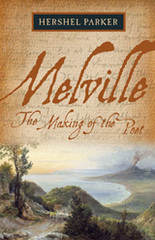 Melville: The Making of the Poet
Hershel Parker
Northwestern University Press, 2007 “Who would have looked for philosophy in whales, or for poetry in blubber?” the London John Bull remarked in October of 1851. And yet, the reviewer went on, “few books which professedly deal in metaphysics, or claim the parentage of the muses, contain as much true philosophy and as much genuine poetry as the tale of the Pequod's whaling expedition.” A decade and a half before surprising the world with a book of Civil war poetry, Melville was already confident of what was “poetic” in his prose. As Hershel Parker demonstrates in this book, Melville was steeped in poetry long before he called himself a poet.
Here Parker, the dean of Melville studies, gives a compelling, in-depth account of how one of America’s greatest writers grew into the vocation of a poet. His work corrects two of the most pernicious misconceptions about Melville perpetuated by earlier critics: that he repudiated fiction writing after Pierre, and that he hadn’t begun writing poetry (let alone had a book of poems ready for publication) as early as 1860. In clearing up these misapprehensions, Parker gives a thorough and thoroughly involving account of Melville’s development as a poet. Parker demonstrates for the first time just how crucial poetry was to Melville from childhood to old age, especially its re-emergence in his life after 1849. Drawing on Melville's shrewd annotations of great British poets and on his probing, skeptical engagement with commentaries on poetry (particularly by the great Scots reviewers), Parker paints a richly textured portrait of a hitherto unseen side of Herman Melville.
Melville’s Israel Potter: Reflections on the American Dream
Alexander Keyssar
Harvard University Press, 1969 Alexander Keyssar’s study focuses on Melville’s treatment of the social and existential condition of the American common man—his inability to realize the happiness promised by the American dream and the impurity of democracy in a society with marked economic classes. The author discusses the literary coherence—thematic rather than narrative—of Melville’s work as illustrated by Israel Potter and as representative of the novelist’s writing during the 1853–1856 period. He includes a brief analysis of Melville’s conception of literary “truth” and a discussion of the peculiar role of comedy in the sad story of Israel Potter. Melville’s insights into the political and social flaws of America “contain remarkable relevance for the contemporary reader.”
 Melville's Prisoners
Harrison Hayford
Northwestern University Press, 2003 Bringing together in one volume the essays of the world's foremost authority on Herman Melville, this collection is both an essential companion and guide to any reading of the American master's work and a model of literary interpretation that is at once precise, judicious, and inspired. The book allows those who (sometimes unknowingly) felt Harrison Hayford's influence to experience firsthand the interpretive force of his critical method and, through his work, to rediscover the compelling mysteries and intricacies of Melville's writing.
Written over many years, these essays retain the power to enlighten and surprise-and often, as Hershel Parker notes in his Foreword, to dazzle. Along with the never-before-published essay from which the book takes its title, Melville's Prisoners includes "Loomings," widely viewed as the single best piece of criticism ever written on Moby-Dick, and "Unnecessary Duplicates," a classic of textual speculation on Melville's methods. Others offer, along with their enduring insights into Melville's work, example after example of a capacious and astonishingly energetic mind at work and at play-a long view of how scholarship at its best is done. In sum, this volume constitutes the finest set of scholarly-critical essays ever written one of America's great writers.
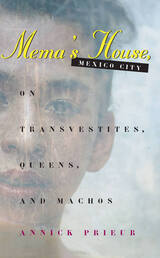 Mema's House, Mexico City: On Transvestites, Queens, and Machos
Annick Prieur
University of Chicago Press, 1998 Mema's house is in the poor barrio Nezahualcoyotl, a crowded urban space on the outskirts of Mexico City where people survive with the help of family, neighbors, and friends. This house is a sanctuary for a group of young, homosexual men who meet to do what they can't do openly at home. They chat, flirt, listen to music, and smoke marijuana. Among the group are sex workers and transvestites with high heels, short skirts, heavy make-up, and voluminous hairstyles; and their partners, young, bisexual men, wearing T-shirts and worn jeans, short hair, and maybe a mustache.
Mema, an AIDS educator and the leader of this gang of homosexual men, invited Annick Prieur, a European sociologist, to meet the community and to conduct her fieldwork at his house. Prieur lived there for six months between 1988 and 1991, and she has kept in touch for more than eight years. As Prieur follows the transvestites in their daily activities—at their work as prostitutes or as hairdressers, at night having fun in the streets and in discos—on visits with their families and even in prisons, a fascinating story unfolds of love, violence, and deceit.
She analyzes the complicated relations between the effeminate homosexuals, most of them transvestites, and their partners, the masculine-looking bisexual men, ultimately asking why these particular gender constructions exist in the Mexican working classes and how they can be so widespread in a male-dominated society—the very society from which the term machismo stems. Expertly weaving empirical research with theory, Prieur presents new analytical angles on several concepts: family, class, domination, the role of the body, and the production of differences among men.
A riveting account of heroes and moral dilemmas, community gossip and intrigue, Mema's House, Mexico's City offers a rich story of a hitherto unfamiliar culture and lifestyle.
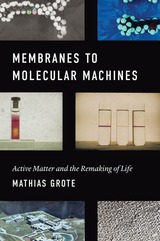 Membranes to Molecular Machines: Active Matter and the Remaking of Life
Mathias Grote
University of Chicago Press, 2019 Today's science tells us that our bodies are filled with molecular machinery that orchestrates all sorts of life processes. When we think, microscopic "channels" open and close in our brain cell membranes; when we run, tiny "motors" spin in our muscle cell membranes; and when we see, light operates "molecular switches" in our eyes and nerves. A molecular-mechanical vision of life has become commonplace in both the halls of philosophy and the offices of drug companies, where researchers are developing “proton pump inhibitors” or medicines similar to Prozac.
Membranes to Molecular Machines explores just how late twentieth-century science came to think of our cells and bodies this way. This story is told through the lens of membrane research, an unwritten history at the crossroads of molecular biology, biochemistry, physiology, and the neurosciences, that directly feeds into today's synthetic biology as well as nano- and biotechnology. Mathias Grote shows how these sciences not only have made us think differently about life, they have, by reworking what membranes and proteins represent in laboratories, allowed us to manipulate life as "active matter" in new ways. Covering the science of biological membranes in the United States and Europe from the mid-1960s to the 1990s, this book connects that history to contemporary work with optogenetics, a method for stimulating individual neurons using light, and will enlighten and provoke anyone interested in the intersection of chemical research and the life sciences—from practitioner to historian to philosopher.
The research described in the book and its central actor, Dieter Oesterhelt, were honored with the 2021 Albert Lasker Basic Medical Research Award for his contribution to the development of optogenetics.
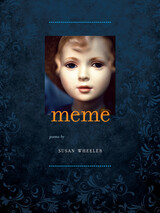 Meme
Susan Wheeler
University of Iowa Press, 2012 Acclaimed poet Susan Wheeler, whose last individual collection predicted the spiritual losses of the economic collapse, turns her attention to the most intimate of subjects: the absence or loss of love. A meme is a unit of thought replicated by imitation; examples of memes, Richard Dawkins wrote, “are tunes, ideas, catch-phrases, clothes fashions, ways of making pots or of building arches.” Occupy Wall Street is a meme, as are internet ideas and images that go viral. What could be more potent memes than those passed down by parents to their children? Wheeler reconstructs her mother’s voice—down to its cynicism and its mid twentieth-century midwestern vernacular—in “The Maud Poems,” a voice that takes a more aggressive, vituperative turn in “The Devil—or—The Introjects.” In the book’s third long sequence, a generational inheritance feeds cultural transmission in “The Split.” A set of variations on losses and break-ups—wildly, darkly funny throughout and, in places, devastatingly sad—“The Split” brings Wheeler’s lauded inventiveness, wit, and insight to the profound loss of love. One read, and the meme “Should I stay or should I go?” will be altered in your head forever.
A Memoir
John A. Hannah
Michigan State University Press, 1980
This is a very personal look at the growth and evolution of Michigan State University, as seen from the eyes of its dynamic president. As twelfth president of Michigan State University, John Alfred Hannah served from July 1, 1941, to April 1, 1969. His tenure was characterized by extensive growth of the University, in both size and enrollments. President Hannah's activities were not limited to the University, as he filled a variety of positions in both the federal government and private industry.
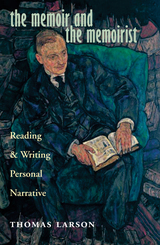 The Memoir and the Memoirist: Reading and Writing Personal Narrative
Thomas Larson
Ohio University Press, 2007 The memoir is the most popular and expressive literary form of our time. Writers embrace the memoir and readers devour it, propelling many memoirs by relative unknowns to the top of the best-seller list. Writing programs challenge authors to disclose themselves in personal narrative. Memoir and personal narrative urge writers to face the intimacies of the self and ask what is true. In The Memoir and the Memoirist, critic and memoirist Thomas Larson explores the craft and purpose of writing this new form. Larson guides the reader from the autobiography and the personal essay to the memoir—a genre focused on a particularly emotional relationship in the author’s past, an intimate story concerned more with who is remembering, and why, than with what is remembered. The Memoir and the Memoirist touches on the nuances of memory, of finding and telling the truth, and of disclosing one’s deepest self. It explores the craft and purpose of personal narrative by looking in detail at more than a dozen examples by writers such as Mary Karr, Frank McCourt, Dave Eggers, Elizabeth Wurtzel, Mark Doty, Nuala O’Faolain, Rick Bragg, and Joseph Lelyveld to show what they reveal about themselves. Larson also opens up his own writing and that of his students to demonstrate the hidden mechanics of the writing process. For both the interested reader of memoir and the writer wrestling with the craft, The Memoir and the Memoirist provides guidance and insight into the many facets of this provocative and popular art form.
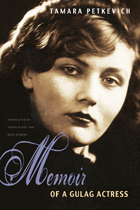 Memoir of a Gulag Actress
Tamara Petkevich
Northern Illinois University Press, 2010
In an abridged translation that retains the grace and passion of the original, Klots and Ufberg present the stunning memoir of a young woman who became an actress in the Gulag. Tamara Petkevich had a relatively privileged childhood in the beautiful, impoverished Petrograd of the Soviet regime’s early years, but when her father—a fervent believer in the Communist ideal—was arrested, 17-year- old Tamara was branded a “daughter of the enemy of the people.” She kept up a search for her father while struggling to support her mother and two sisters, finish school, and enter university. Shortly before the Russian outbreak of World War II, Petkevich was forced to quit school and, against her better judgment, she married an exiled man whom she had met in the lines at the information bureau of the NKVD (People’s Commissariat of Internal Affairs). Her mother and one sister perished in the Nazi siege of Leningrad, and Petkevich was herself arrested. With cinematic detail, Petkevich relates her attempts to defend herself against absurd charges of having a connection to the Leningrad terrorist center, counter-revolutionary propaganda, and anti-Semitism that resulted in a sentence of seven years’ hard labor in the Gulag.
While Petkevich became a professional actress in her own right years after her release from the Gulag, she learned her craft on the stages of the camps scattered across the northern Komi Republic. The existence of prisoner theaters and troupes of political prisoners such as the one Petkevich joined is a little-known fact of Gulag life. Petkevich’s depiction not only provides a unique firsthand account of this world-within-a-world but also testifies to the power of art to literally save lives. As Petkevich moves from one form of hardship to another she retains her desire to live and her ability to love.
More than a firsthand record of atrocities committed in Stalinist Russia, Memoir of a Gulag Actress is an invaluable source of information on the daily life and culture of the Soviet Union at the time. Russian literature about the Gulag remains vastly under-represented in the United States, and Petkevich’s unforgettable memoir will go a long way toward filling this gap. Supplemented with photographs from the author’s personal archive, Petkevich’s story will be of great interest to general readers, while providing an important resource for historians, political scientists, and students of Russian culture and history.
 Memoir of a Trustbuster: A Lifelong Adventure with Japan
Eleanor M. Hadley and Patricia Hagan Kuwayama
University of Hawaii Press, 2002 Eleanor Hadley was a woman ahead of her time. While working on a Ph.D. in economics at Harvard, she was recruited by the U.S. government for her knowledge of Japanese zaibatsu (business combines) and subsequently became one of MacArthur's key advisors during the Occupation. After completing her doctorate, she prepared for a career in Washington until she learned she was being blacklisted. Seventeen years passed before Hadley's name was cleared; she returned to government service in 1967 and began a distinguished career as a senior policy analyst with the U.S. Tariff Commission and the General Accounting Office. Widely known (and feared) by Japanese businessmen and government leaders as "the trust-busting beauty," Hadley published Antitrust in Japan, a seminal work on the impact of postwar deconcentration measures, in 1970. She received the Order of the Sacred Treasure from the Japanese government in 1986.
Hadley's personal story provides a colorful backdrop to her substantive discussions of early postwar policies, which were created to provide Japan with a more efficient and competitive economy. As someone closely involved in formulating U.S. economic policy toward Japan for nearly half a century, Eleanor Hadley brings a unique perspective--as well as a down-to-earth sense of humor--to the continuing challenge of communicating across the Pacific.
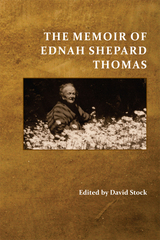 The Memoir of Ednah Shepard Thomas
Ednah Shepard Thomas
University Press of Colorado, 2017 The Memoir of Ednah Shepard Thomas offers an in-depth look at what it was to be a Writing Program Administrator during the period from after World War II up to the time of the early 1970s, a time for which we have little in the way of documentation for the work of early WPAs. Written at a time when the civil rights movement and the women's movement were just beginning to influence the way one thought and wrote about issues of race, class, and gender, this memoir offers insights into a period of time when the field was only beginning to come into focus. A foreword by Susan McLeod, an introduction and extensive footnotes by David Stock, and an afterword by David Fleming contextualize the memoir and highlight its relevance to scholars, teachers, and program administrators in composition-rhetoric. As a local history of writing program administration in its pre-professional era, the memoir offers a vital counternarrative to David Fleming's (2011) award-winning account of the abolition of UW-Madison's Freshman English program in 1969-70.
Memoir of Hungary: 1944-1948
Sándor Márai
Central European University Press, 1996 This scathing, at times humorous, and always insightful memoir by exiled Hungarian novelist Sándor Márai, provides one of the most poignant and human portraits of life in Hungary between the German occupation in 1944 and the solidification of communist power in 1948. Both a fervent anti-fascist and anti-communist, Márai draws a vivid portrait of the Hungarian peasantry and middle-class during this period, while delivering a telling indictment of the communist system from which he fled. Witty, aphoristic and psychologically clear-sighted, this memoir depicts the tragedy and pathos of a crucial period in the post-war history of a nation which has been 'central' to both the communists and the post-communist history of our times.
Memoir of Italo Svevo
Livia Veneziani Svevo
Northwestern University Press, 2001 Writer Italo Svevo had many things in common with other writers: a long struggle for recognition; a friendship with a noteworthy author (in Svevo's case, James Joyce); and a long list of neuroses. His choice of a wife, however, was anything but common. Livia Veneziani Svevo tirelessly worked on her husband's behalf after his tragic early death and also penned this remarkable portrait of a serious artist and a loving (if quirky) marriage. Memoir of Italo Svevo tells the story of how a successful middle-aged businessman, as obsessed with smoking as with his abandoned literary ambitions, somehow became one of the great authors of the twentieth century.
 The Memoir of James Jackson, The Attentive and Obedient Scholar, Who Died in Boston, October 31, 1833, Aged Six Years and Eleven Months
Susan Paul
Harvard University Press, 2000 “The design of this Memoir is, to present the incidents in the life of a little colored boy.” So begins the life story of James Jackson, as set down by his African American teacher, Susan Paul, in 1835, as an example to other children and adults who might learn from the boy’s goodness.This remarkable document—the first African American biography and a work that predates Harriet Jacobs’s Incidents in the Life of a Slave Girl by almost thirty years—is a lost treasure from the annals of African American history. With its combination of eyewitness accounts, personal testimony, and excerpts from traditional Sunday school texts, the memoir is an extraordinary social history rooted in both nineteenth-century evangelicalism and the experiences of free African Americans.Susan Paul’s portrayal of James Jackson’s Christian sensibility, his idealism, and his racial awareness emphasizes his humanity and exemplary American character over his racial identity, even as it embeds him in his African American community.
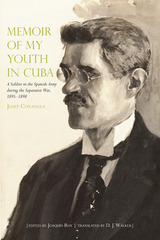 Memoir of My Youth in Cuba: A Soldier in the Spanish Army during the Separatist War, 1895–1898
Dolores J. Walker
University of Alabama Press, 2017 Memoir of My Youth in Cuba: A Soldier in the Spanish Army during the Separatist War, 1895–1898 is a translation of the memoir Memorias de mi juventud en Cuba: Un soldado del ejército español en la guerra separatista (1895–1898) by Josep Conangla. The English edition is based on the Spanish version edited by Joaquín Roy, who found the memoir and was given access to the Conangla family archives. Conangla’s memoir, now available in English, is an important addition to the accounts of Spanish and Cuban soldiers who served in Cuba’s second War of Independence.
Spaniard Josep Conangla was conscripted at the age of twenty and sent to Cuba. In the course of his time there, he reaffirmed his pacifism and support of Cuban independence. The young man was a believer who unfailingly connected his view of events to the Christian humanitarianism on which he prided himself. Conangla’s advanced education and the influence of well-placed friends facilitated his assignment to safe bureaucratic positions during the war, ensuring that he would not see combat. From his privileged position, he was a keen observer of his surroundings. He described some of the decisions he made—which at times put him at odds with the military bureaucracy he served—along with what he saw as the consequences of General Valeriano Weyler’s decree mandating the reconcentración, an early version of concentration camps. What Conangla saw fueled his revulsion at the collusion of the Spanish state and its state-sponsored religion in that policy. “Red Mass,” published six years after the War of Independence and included in his memoir, is a vivid expression in verse of his abhorrence.
Conangla’s recollections of the contacts between Spaniards and Cubans in the areas to which he was assigned reveal his ability to forge friendships even with Creole opponents of the insurrection. As an aspiring poet and writer, Conangla included material on fellow writers, Cuban and Spanish, who managed to meet and exchange ideas despite their circumstances. His accounts of the Spanish defeat, the scene in Havana around the end of the war, along with his return to Spain, are stirring.
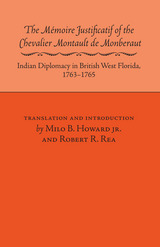 The Memoire Justificatif of Chevalier Monberaut: Indian Diplomacy in British West Florida, 1763-1765
Montault Monberaut
University of Alabama Press, 1965 Presents in greater detail the circumstances and procedure of Indian diplomacy on the Gulf Coast at the beginning of the British period
Historians of the Gulf Coast have long delighted in the romance of Spanish discovery and French settlement. The period of British occupation was relatively brief, fruitless, and prosaic, if we are to believe the older authorities. Today the availability of materials which were closed to an earlier generation enables us to re-create the story of British West Florida in terms more precise, with details more personal, and with no less dramatic coloration than has long been given-with less accuracy-to the earlier epochs.
In The Memoire Justificatif of Chevalier Monberaut, the translators have undertaken the resurrection of one of those gallant Frenchmen of the ancien regime who remained behind to serve the new Anglo-Saxon masters of West Florida. The Chevalier Montault de Monberaut is not unknown to historians of the colonial scene, but he has never enjoyed a full portrayal of his contribution nor a balanced evaluation of his role. By concentrating our attention upon the man as well as his milieu, we have been able to present in greater detail than before the circumstances and procedure of Indian diplomacy on the Gulf Coast at the beginning of the British period. By placing Monberaut against the backdrop of British colonial government and its problems, we have replaced some of the romantic fallacies with historic realities. The resulting clarity adds to the picture's significance and appeal.
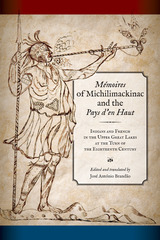 Mémoires of Michilimackinac and the Pays d'en Haut: Indians and French in the Upper Great Lakes at the Turn of the Eighteenth Century
José António Brandao
Michigan State University Press, 2019 Mémoires of Michilimackinac offers corrected, unabridged, and properly annotated and edited transcriptions and translations of three important documents related to the French presence and French–Native American relations in the Great Lakes region before 1715. The Relation du sieur De lamotte Cadillac; d’Aigremont’s Mémoire of November 14, 1708; and Bégon’s Mémoire on the Establishment of Michilimackinac of September 20, 1713, are thoroughly examined, with an introduction that places these documents in context; summarizes major findings about Michilimackinac, Native American cultures, and French imperial ambitions in the Great Lakes region; and includes a critical exploration of the documents’ authorship. All three mémoires provide windows into Michilimackinac’s centrality to the French imperial and trade network and the place of Native Americans in French policy during this period, and ultimately contribute to understanding trends, enduring and new, in the scholarship of French and Indians in the upper Great Lakes.
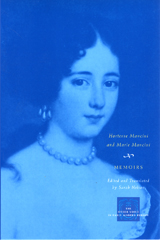 Memoirs
Marie Mancini and Hortense Mancini
University of Chicago Press, 2008 The memoirs of Hortense (1646–1699) and of Marie (1639–1715) Mancini, nieces of the powerful Cardinal Mazarin and members of the court of Louis XIV, represent the earliest examples in France of memoirs published by women under their own names during their lifetimes. Both unhappily married—Marie had also fled the aftermath of her failed affair with the king—the sisters chose to leave their husbands for life on the road, a life quite rare for women of their day.
Through their writings, the Mancinis sought to rehabilitate their reputations and reclaim the right to define their public images themselves, rather than leave the stories of their lives to the intrigues of the court—and to their disgruntled ex-husbands. First translated in 1676 and 1678 and credited largely to male redactors, the two memoirs reemerge here in an accessible English translation that chronicles the beginnings of women’s rights to personal independence within the confines of an otherwise circumscribed early modern aristocratic society.
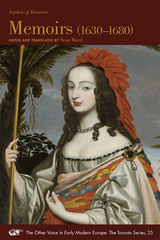 Memoirs (1630-1680)
Sophia of Hanover
Iter Press, 2013 Granddaughter of James I of England, Sophia (1630–1714) began life a penniless princess in exile. She ended it as electress dowager of Hanover, an emerging European power. Had she lived two months longer, she would have succeeded to the British crown before her son, George I. In keeping with Sophia’s reputation as the era’s “most entertaining woman,” her memoirs, which she wrote in French, paint a captivating and often humorous portrait of her life as one of Europe’s preeminent noblewomen and celebrities. They also recall, with insight and verve, her interactions with leading men and ladies (Charles II, Louis XIV, Queen Christina of Sweden) and long-forgotten bit players (cavaliers, concubines, clerics, and quacks). The memoirs, which recount the first fifty years of Sophia’s life, appear here in English for the first time in their entirety. Their publication in this series is particularly timely, as it coincides with the three hundredth anniversary of the Hanoverian succession (2014).
 Memoirs and Letters
Oscar W. Firkins
University of Minnesota Press, 1934
Memoirs and Letters was first published in 1934. Minnesota Archive Editions uses digital technology to make long-unavailable books once again accessible, and are published unaltered from the original University of Minnesota Press editions.
This volume, the last in a set of four containing posthumous works of Oscar W. Firkins, consists mainly of some two hundred personal letters, which reveal many delightful facets of a unique character.
Oscar W. Firkins—critic, biographer, playwright, lecturer, and teacher—was regarded as a recluse, living in a world peopled largely by "poets dead and gone" and the creatures of their imagination and his own. That he enjoyed warm friendships with men and women of his time is brought to light in these miscellaneous letters: letters to clergymen and children, to editors and club women, to students and poets, to actors and college deans.
Many brilliantly epigrammatic comments from Firkins' famous classroom lectures are included in the section of this book entitled "From Oscar Firkins' Notebooks." The "Estimate and Appreciation" with which the volume opens is by Dr. Richard Burton, for many years a colleague of Professor Firkins at the University of Minnesota. "Oscar Firkins as a Teacher" is contributed by a former student. A complete bibliography, compiled by Ina Ten Eyck Firkins, concludes the volume.
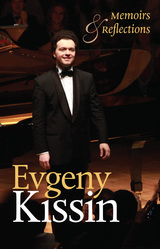 Memoirs and Reflections
Evgeny Kissin
University Press of New England, 2018 Evgeny Kissin is an internationally renowned classical pianist admired for his interpretations of the repertoires of Beethoven, Schubert, Chopin, Liszt, Schumann, Brahms, Rachmaninoff, and Prokofiev. The intensity of Kissin’s thinking animates this candid memoir, illuminating his astonishing memory, his fondness for his family and teachers, and his artistic sense of self. Memoirs and Reflections chronicles Kissin’s musical education and his early career. His writing is infused with his lifelong engagement with music: an obsessive love that captured, challenged, and nurtured him from a young age. He recounts fortuitous events and serendipitous encounters with remarkable musicians and conductors, including Herbert von Karajan. This book shows Kissin to be surprisingly modest and down-to-earth in spite of his astonishing gift. He writes of his family and friends with tender affection and touching detail. Reading this intimate memoir is like having a private audience with the great pianist himself.
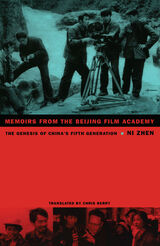 Memoirs from the Beijing Film Academy: The Genesis of China's Fifth Generation
Zhen Ni
Duke University Press, 2002 After graduating from the Beijing Film Academy in 1982, directors like Chen Kaige and Zhang Yimou transformed Chinese cinema with Farewell My Concubine, Yellow Earth, Raise the Red Lantern, and other international successes. Memoirs from the Beijing Film Academy tells the riveting story of this class of 1982, China’s famous "Fifth Generation" of filmmakers. It is the first insider’s account of this renowned cohort to appear in English. Covering these directors’ formative experiences during China’s tumultuous Cultural Revolution and later at the Beijing Film Academy, Ni Zhen—who was both their screenwriter and teacher—provides unique insights into the origins of the Fifth Generation’s creativity. Drawing on his personal knowledge and interviews conducted especially for this volume, Ni Zhen demonstrates the diversity of the Fifth Generation. He comments on the breadth of styles and themes explored by its members and introduces a range of male and female directors, cinematographers, and production designers famous in China but less well-known internationally. The book contains vivid descriptions of the production processes of two pioneering films—One and Eight and Yellow Earth.
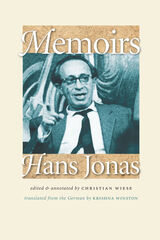 Memoirs: Hans Jonas
Hans Jonas
Brandeis University Press, 2021 When Hans Jonas died in 1993, he was revered among American scholars specializing in European philosophy, but his thought had not yet made great inroads among a wider public. In Germany, conversely, during the 1980s, when Jonas himself was an octogenarian, he became a veritable intellectual celebrity, owing to the runaway success of his 1979 book The Imperative of Responsibility. In the 1920s, Jonas studied philosophy with Edmund Husserl and Martin Heidegger, but the Nazi regime forced him to leave Germany for London in 1933. He later emigrated to Palestine and eventually enlisted in the British Army’s Jewish Brigade to fight against Hitler. Following the Israeli War of Independence, he emigrated to the United States and took a position at the New School for Social Research in New York. He became part of a circle of friends around Hannah Arendt and Heinrich Blucher, which included Adolph Lowe and Paul Tillich. This memoir, a diverse collection of previously unpublished materials—diaries, letters, interviews, and public statements—has been organized by Christian Wiese, whose afterword links the Jewish dimensions of Jonas’s life and philosophy. Because Jonas’s life spanned the entire twentieth century, this memoir provides nuanced pictures of German Jewry during the Weimar Republic, of German Zionism, of the Jewish emigrants in Palestine during the 1930s and 1940s, and of German Jewish émigré intellectuals in New York. Since Memoirs was first published in 2008, interest in the work of Hans Jonas has grown among American academics in recent years.
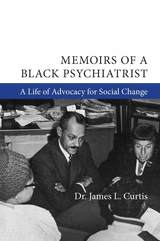 Memoirs of a Black Psychiatrist: A Life of Advocacy for Social Change
Dr. James L. Curtis
Michigan Publishing, 2017 Born during the Great Migration, pursuing an education during World War II, and beginning a career during the Civil Rights movement, Dr. James L. Curtis has surmounted many racial hurdles to rise to the top of academic medicine. Memoirs of a Black Psychiatrist tells Dr. Curtis’s story of working toward his life goal of improving the quality of life and full citizenship of his people, with the help of mentors both black and white. He shows that in only a few decades of his life was it possible for his parents—later, for him and other family members, the whole black community, and eventually the world—to step up a little higher, or be forced back again to the back of the bus.
In his two previous books, Dr. Curtis illustrated the leadership role he played in changing how medicine is practiced for the better. His first book, Blacks, Medical Schools and Society (University of Michigan Press, 1971), was written when he was an associate dean of the Cornell University Medical College. As dean in the beginning years of Affirmative Action in Medicine, Dr. Curtis took action in this movement by desegregating medical school admissions not only at Cornell, but also in all US medical schools. After his retirement, his second book, Affirmative Action in Medicine: Improving Health Care for All (University of Michigan Press, 2003), was published: a twenty-five-year progress report on the social benefit of these programs in the American practice of medicine.
Dr. Curtis retired in 2000 as Clinical Professor of Psychiatry of Columbia University College of Physicians and Surgeons, having been a faculty member for eighteen years. During his tenure at Columbia he was also Director of Psychiatry at Harlem Hospital Center, serving one of the most economically deprived neighborhoods of New York City. Since 2003, he has lived in his hometown of Albion, Michigan, one of the formerly vibrant and prosperous cities devastated by the collapse of the automobile industry. With a small group of others, he is developing new social service programs to benefit Albion.
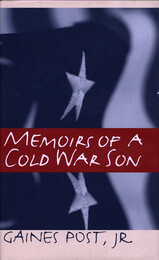 Memoirs Of A Cold War Son
Post, Gaines, Jr.
University of Iowa Press, 2000 In 1951 Gaines Post was a gangly, bespectacled, introspective teenager preparing to spend a year in Paris with his professorial father and older brother; his mother, who suffered from extreme depression, had been absent from the family for some time. Ten years later, now less gangly but no less introspective, he was finishing a two-year stint in the army in West Germany and heading toward Oxford on a Rhodes scholarship, having narrowly escaped combat in the Berlin crisis of 1961. His quietly intense coming-of-age story is both self-revealing and reflective of an entire generation of young men who came to adulthood before the Cuban Missile Crisis and the Vietnam War. Post's experiences in high school in Madison, Wisconsin, and Paris, his Camus-influenced undergraduate years at Cornell University, and his army service in Germany are set very effectively against the events of the Cold War. McCarthyism and American crackdowns on dissidents, American foreign and military policy in Western Europe in the nuclear age, French and German life and culture, crises in Paris and Berlin that nearly bring the West to war and the Post family to dissolution—these are the larger scenes and subjects of his self-disclosure as a contemplative, conflicted "Cold War agnostic." His intelligent, talented mother and her fragile health hover over Post's narrative, informing his hesitant relationships with women and his acutely questioning sense of self-worth. His story is strongly academic and historical as well as political and military; his perceptions and judgments lean toward no ideological extreme but remain true to the heroic ideals of his boyhood during the Second World War.
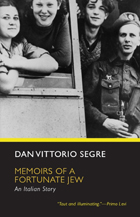 Memoirs of a Fortunate Jew: An Italian Story
Dan Vittorio Segre
University of Chicago Press, 2008 “I was probably less than five years old when my father fired a shot at my head.” From this first line, Dan Vittorio Segre’s memoir moves from one startling turning point to the next. The child of aristocratic parents, Segre fled Fascist Italy and Mussolini’s anti-Semitic laws only to be thrust into the pioneering culture of Palestine, completely unprepared for the dangers of life in Israel during World War II. Beautifully narrated, Memoirs of a Fortunate Jew is an ironic, philosophical meditation on the historical reverberations of the twentieth century.
“Taut and illuminating . . . memorable . . . written with the humility of he who confesses himself and with the honesty of he who bore witness.”—Primo Levi
“The writing of memoirs is a difficult art that Dan Segre fully possesses. Under his pen, history and psychology merge in one captivating narrative which illuminates the turmoils, fears and triumphs of his generation.”—Elie Wiesel
“Beautifully written. . . . [A] labyrinthine, spell-binding autobiography, full of passionate tenderness.”—New York Review of Books
“An unusually attractive book—attractive in its irony, its energy and its moral insight. Mr. Segre had some rich material to work with, and he has done it justice.”—New York Times
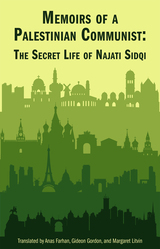 Memoirs of a Palestinian Communist: The Secret Life of Najati Sidqi
Najati Sidqi; translated by Margaret Litvin, Gideon Gordon, and Anas Farhan
University of Texas Press, 2025 The secret life of a Palestinian Communist activist during the leadup to World War II. In the public eye, Najati Sidqi was known as a journalist and writer, a translator of Russian classics, and an outspoken opponent of Nazism. However, Sidqi concealed a critical component of his life from the world and his family. He was an underground activist for the Palestinian Communist Party, a risky and influential pursuitthat took him to early Bolshevik Moscow, British courts and prison cells in Palestine, Nazi Germany, intrigue-heavy interwar Paris, and Civil War Spain, Morocco, and Algeria. Throughout his journey, Sidqi continued to write, even as he faced fascism, intense surveillance, active warzones, the death of friends, and exile. Memoirs of a Palestinian Communist brings Sidqi’s incredible life and work to light, wryly narrating his international travels, his work as an activist, and his political dealings at a crucial moment for Palestine and the international fight against fascism. Translated from Arabic into English for the first time, it is a riveting firsthand account of an often-overlooked aspect of the history of the global left. Generous supplementary materials make the memoir accessible to students and non-specialist scholars: a preface by Sidqi’s grandson, a foreword by renowned historian Joel Beinin, a translators’ introduction that presents new research on Sidqi’s family history, a map of his travels, and a timeline, as well as a bibliographic essay offering pointers for further research.
 Memoirs of a Revolutionist
Vera Figner
Northern Illinois University Press, 1991
Born into the comforts of the Russian aristocracy in 1852, Vera Figner as a child harbored the fairy-tale dream of one day becoming tsarina. By the age of thirty-two, however, Figner had become one of Russia's most vocal revolutionaries, a terrorist and member of the Executive Committee of the People's Will party, and a prisoner sentenced for life for her involvement in the assassination of Alexander II.
In this classic memoir, Figner recounts her journey from aristocrat to revolutionary, candidly relating the experiences that shaped her ideas and provoked her to political action and violence. As she reflects on her own lifelong commitment to improving the lives of ordinary Russians, she reveals much about the concept, structure, and leadership behind the radical movement in late nineteenth-century Russia. In his incisive introduction to this edition, Richard Stites discusses the importance of the memoir as a personal testimony and provides background for understanding a courageous woman's role in the struggle for political change.
Memoirs of a Yukon Priest
Segundo Llorente, SJ
Georgetown University Press This is an engagingly personal account of the hardships, challenges, and rewards of a life lived wholly in the presence of God and at the service of the Alaskan people. In September 1935, Segundo Llorente, a wide-eyed twenty-eight-year-old Jesuit priest from Spain set foot in Alaska for the the first time. His memoirs are filled with all that he saw, endured, and enjoyed for forty years in Uncle Sam's "icebox," whether by dogsled in the 1930s or by plane and snowmobile in the 1970s. He prayed, worked, scolded, helped, and laughed with a practical wisdom that recalls the Ignatian spirituality in everyday life that also marks Father Walter Cisek's Russian journal, He Leadeth Me.
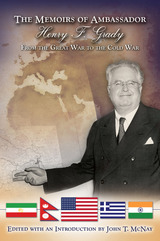 The Memoirs of Ambassador Henry F. Grady: From the Great War to the Cold War
Edited & Intro by John T. McNay
University of Missouri Press, 2009
When Henry Grady died in 1957, one obituary called him “America’s top diplomatic soldier” for a critical period of the Cold War, and over a long career he was deeply involved in events that changed our role in the world. Even so, this self-described “soft” cold warrior has been largely overlooked by historians. His memoirs, left to languish with his other papers, are now published for the first time, offering new insight into the origins and implementation of American trade and development policies—and into the tumult that was the Cold War.
A specialist in international economic policy, Grady helped create the system of reciprocal trade established under FDR during the depression. Progressing in his career through his abilities rather than through political connections, he was sent to India during World War II to spark its production for the war effort, then to Italy to help jump-start its economy once German forces were driven out. After the war, he was the first American ambassador to an independent India, then served as ambassador to Greece and Iran—where he was embroiled in the oil industry crisis that eventually led to the CIA’s overthrow of Prime Minister Mohammad Mossadegh.
Grady’s memoirs are an intriguing and informative account of early Cold War diplomacy in significant and turbulent regions of the Third World, embellished by his thoughts about the changing nature of American economic policies and his role as a representative of that system abroad. It offers new perspectives on the crisis in Iran in the early 1950s, where Grady was especially critical of Secretary of State Dean Acheson’s support for the remnants of British imperialism in Iran—and paid for his criticism with his job. Editor John McNay’s introduction and comments shed light on Grady’s thinking and his role in the policy-making process.
More than a chronicle of a wide-ranging career—one that reflects the emergence of the United States as the world’s leading economic power—Grady’s memoirs are a trenchant critique of U.S. foreign policy in the first half of the twentieth century. They provide modern readers an opportunity to reconsider the conflict between realism and idealism in foreign relations during the Cold War years.
 Memoirs of an Early Arab Feminist: The Life and Activism of Anbara Salam Khalidi
Anbara Salam Khalidi
Pluto Press, 2013 Memoirs of an Early Arab Feminist is the first English translation of the memoirs of Anbara Salam Khalidi, the iconic Arab feminist. At a time when women are playing a leading role in the Arab Spring, this book brings to life an earlier period of social turmoil and women's activism through one remarkable life.
Anbara Salam was born in 1897 to a notable Sunni Muslim family of Beirut. She grew up in 'Greater Syria', in which unhindered travel between Beirut, Jerusalem and Damascus was possible, and wrote a series of newspaper articles calling on women to fight for their rights within the Ottoman Empire. In 1927 she caused a public scandal by removing her veil during a lecture at the American University of Beirut.
Later she translated Homer and Virgil into Arabic and fled from Jerusalem to Beirut following the establishment of Israel in 1948. She died in Beirut in 1986. These memoirs have long been acclaimed by Middle East historians as an essential resource for the social history of Beirut and the larger Arab world in the 19th and 20th centuries.
 Memoirs of an Indo Woman: Twentieth Century Life in the East Indies and Abroad
Marguérite Schenkhuizen
Ohio University Press, 1993 The memoirs of Marguérite Schenkhuizen provide an overview of practically the whole of the twentieth century as experienced by persons of mixed Dutch and Indonesian ancestry who lived in the former Dutch East Indies. The memoirs provide vignettes of Indonesian life, both rural and urban, as seen through the eyes of the author first as a girl, then as a wife separated from her husband during the Japanese occupation, finally as an immigrant to the United States after World War II. This self-portrait gives glimpses of the life of Indos from inside their society, glimpses that are valuable for their descendents as well as for outsiders. Written with humor and a positive town, Schenkhuizen’s story sets aside the myth that Indos were denied access to the upper layers of Dutch colonial society or were otherwise disadvantaged. Instead, her life story provides an authentic view of a vital Indo culture and experience that has been unavailable to the general reader of English.
Memoirs of an Unregulated Economist
George J. Stigler
University of Chicago Press, 2003 In this witty and modest intellectual autobiography, George J. Stigler gives us a fascinating glimpse into the little-known world of economics and the people who study it. One of the most distinguished economists of the twentieth century, Stigler was awarded the Nobel Prize in 1982 for his work on public regulation. He also helped found the Chicago School of economics, and many of his fellow Chicago luminaries appear in these pages, including Fredrich Hayek, Milton Friedman, Ronald Coase, and Gary Becker. Stigler's appreciation for such colleagues and his sense of excitement about economic ideas past and present make his Memoirs both highly entertaining and highly educational.
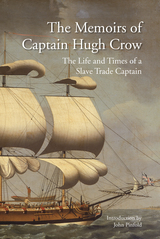 The Memoirs of Captain Hugh Crow: The Life and Times of a Slave Trade Captain
Edited by the Bodleian Library
Bodleian Library Publishing, 2007 Numerous documents attest to the horrific conditions endured by African slaves during the centuries of the Atlantic slave trade. Less well known is the perspective of those who wielded power during this dark time in human history. The Bodleian Library fills that gap here with the memoirs of a principal figure in the slave trade, Captain Hugh Crow. The first-hand account of a man who commanded one of the last legal slave vessels to cross the Atlantic, Life and Times of a Slave Trade Captain offers a revealing if frequently troubling look into the psyche of a slave trader. His chronicle leaves nothing to the imagination, as he recounts the harsh routine of daily life on a slave vessel, where on average a fifth of the crew—let alone the human cargo—never survived the crossing. Crow portrays himself as an “enlightened” slaver, a claim he justifies through the link between his close attention to his “negroes” and his financial success, and the songs composed for him by the slaves. His account also includes commentary on the social propriety of the slave trade and notes about the conditions on West Indian and Caribbean plantations as well as on slave ships. John Pinfold’s illuminating introduction recounts the life of Hugh Crow and sets him in the rich historical context of eighteenth-century mercantilism and its battle with the abolitionist movement. An eye-opening read, Life and Times of a Slave Trade Captain reveals an often overlooked facet in the complicated history of transatlantic slavery.
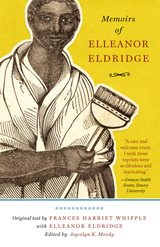 Memoirs of Elleanor Eldridge
Frances H. Whipple
West Virginia University Press, 2013 Elleanor Eldridge, born of African and US indigenous descent in 1794, operated a lucrative domestic services business in nineteenth century Providence, Rhode Island. In defiance of her gender and racial background, she purchased land and built rental property from the wealth she gained as a business owner. In the 1830s, Eldridge was defrauded of her property by a white lender. In a series of common court cases as alternately defendant and plaintiff, she managed to recover it through the Rhode Island judicial system. In order to raise funds to carry out this litigation, her memoir, which includes statements from employers endorsing her respectable character, was published in 1838. Frances Harriet Whipple, an aspiring white writer in Rhode Island, narrated and co-authored Eldridge’s story, expressing a proto-feminist outrage at the male “extortioners” who caused Eldridge’s loss and distress.
With the rarity of Eldridge’s material achievements aside, Memoirs of Elleanor Eldridge forms an exceptional antebellum biography, chronicling Eldridge’s life from her birth through the first publication of almost yearly editions of the text between 1838 and 1847. Because of Eldridge’s exceptional life as a freeborn woman of color entrepreneur, it constitutes a counter-narrative to slave narratives of early 19th-century New England, changing the literary landscape of conventional American Renaissance studies and interpretations of American Transcendentalism.
With an introduction by Joycelyn K. Moody, this new edition contextualizes the extraordinary life of Elleanor Eldridge—from her acquisition of wealth and property to the publication of her biography and her legal struggles to regain stolen property. Because of her mixed-race identity, relative wealth, local and regional renown, and her efficacy in establishing a collective of white women patrons, this biography challenges typical African and indigenous women’s literary production of the early national period and resituates Elleanor Eldridge as an important cultural and historical figure of the nineteenth century.
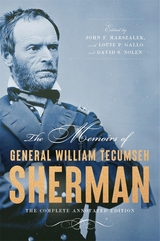 The Memoirs of General William Tecumseh Sherman: The Complete Annotated Edition
William T. Sherman
Harvard University Press, 2025 A titan among Civil War military geniuses gives an unvarnished account of his career, presented for the first time in a definitive annotated edition, marking the 150th anniversary of the original publication.
William Tecumseh Sherman’s memoirs were a sensation when first published in 1875, as Americans grappled with the aftermath of the Civil War and its emerging place in collective memory. Today, Sherman’s account remains arguably the most significant work of Civil War military history after that of his friend and commanding general Ulysses S. Grant.
In blunt terms, Sherman chronicles his military life and leadership from the First Battle of Bull Run to the Battle of Shiloh and the Atlanta and Vicksburg Campaigns. Most notably, he gives a detailed account of his notorious March to the Sea, which instituted a new and uniquely destructive type of warfare that would include civilians in the conflict between armies ever after. Along the way, he provides candid and often unsparing commentary on his fellow officers, subordinates, and adversaries. These assessments created immediate and lasting controversy, so much so that Sherman published a second edition with extensive appendixes responding to the outcry.
This newly annotated volume, featuring an introduction by leading Civil War historian John F. Marszalek, presents Sherman’s life and legacy for today’s audience. Detailed notes shed light on his editorial process, while contextualizing individuals, places, and events that loomed large for nineteenth-century readers but have since become obscure. Reintroducing a classic work of American military history, this edition brings to life a remarkable figure whose leadership continues to be debated today.
The Memoirs of Harry S. Truman: A Reader's Edition
Edited by Raymond H. Geselbracht
University of Missouri Press, 2019 This new “Reader’s Edition” of Harry Truman’s memoirs removes the overload of detail and reproduced historical documents, reduces the bloated cast of characters, clarifies the often confusing balance between chronological and thematic presentation, and corrects some important problems of presentation that made the two volumes of Truman’s memoirs, published in 1955 and 1956, difficult to read and enjoy. This new edition, reduced to half the length of the original text, offers a new generation of readers the thrill of hearing the unique and authentic voice of Harry S. Truman, probably the most important president of the last seventy-five years, telling the story of his life, his presidency, and some of the most important years in American history.
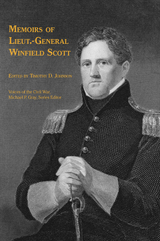 Memoirs of Lieut.-General Winfield Scott
Timothy D. Johnson
University of Tennessee Press, 2015 The remarkable military career of General Winfield Scott spanned fifty-three years, fourteen presidents, and six wars, both foreign and domestic. However, his lengthy service did not secure his rightful place among the nation’s pantheon of great military leaders. Instead, he is most often remembered as the aged, overweight, and sickly commanding general who was replaced by George McClellan at the beginning of the Civil War. Originally published in 1864, only two years before his death, Scott’s memoirs touch on many of the significant events of the early and mid-nineteenth century. This new edition of those remembrances, expertly edited by Timothy D. Johnson, showcases Scott’s rare strategic insights, battlefield prowess, and diplomatic shrewdness, restoring him to his proper place as arguably the most important American general to ever serve his country.
Scott joined the army in 1808, earned the rank of brigadier general in 1814, and was promoted to commanding general in 1841. During the Mexican-American War, he commanded one of the most brilliant military campaigns in American history and mentored the generation of officers who fought the Civil War, including Generals Grant, Lee, Longstreet, Beauregard, Jackson, and Meade. As a young general, he wrote the first comprehensive set of regulations to govern the army and pushed for the professionalization of the U.S. officer corps. Yet, he was ridiculed at the beginning of the war for his prescient prediction that the Civil War would be a prolonged conflict requiring extensive planning and superior strategic thinking.
With this edition, Johnson has merged Scott’s large two-volume memoir into a single, manageable volume without losing any of the original 1864 text. Extensive new annotations update Scott’s outdated notes and provide valuable illumination and context. Covering a wide range of events—from the famous 1804 duel between Aaron Burr and Alexander Hamilton through the end of the Civil War—Scott’s extraordinary account reveals the general as a sometimes egocentric but always astute witness to the early American republic.
Timothy D. Johnson, professor of history at Lipscomb University in Nashville, is the author of Winfield Scott: The Quest for Military Glory and A Gallant Little Army: The Mexico City Campaign. He is coeditor, with Nathaniel Cheairs Hughes Jr., of A Fighter from Way Back: The Mexican War Diary of Lt. Daniel Harvey Hill and Notes of the Mexican War by J. Jacob Oswandel.
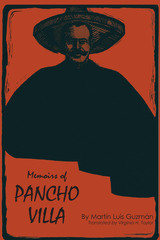 Memoirs of Pancho Villa
By Martín Luis Guzmán
University of Texas Press, 1965 This is a tale that might be told around a campfire, night after night in the midst of a military campaign. The kinetic and garrulous Pancho Villa talking on and on about battles and men; bursting out with hearty, masculine laughter; weeping unashamed for fallen comrades; casually mentioning his hotheadedness—"one of my violent outbursts"—which sent one, two, or a dozen men before the firing squad; recounting amours; and always, always protesting dedication to the Revolutionary cause and the interests of "the people." Villa saw himself as the champion, eventually almost the sole champion, of the Mexican people. He fought for them, he said, and opponents who called him bandit and murderer were hypocrites. This is his story, his account of how it all began when as a peasant boy of sixteen he shot a rich landowner threatening the honor of his sister. This lone, starved refugee hiding out in the mountains became the scourge of the Mexican Revolution, the leader of thousands of men, and the hero of the masses of the poor. Great battles of the Revolution are described, sometimes as broad sweeps of strategy, sometimes as they developed half hour by half hour. Long, dusty horseback forays and cold nights spent pinned down under enemy fire on a mountainside are made vivid and gripping. The assault on Ciudad Juárez in 1911, the battles of Tierra Blanca, of Torreón, of Zacatecas, of Celaya, all are here, told with a feeling of great immediacy. This volume ends as Villa and Obregón prepare to engage each other in the war between victorious generals into which the Revolution degenerated before it finally ended. Martín Luis Guzmán, eminent historian of Mexico, knew and traveled with Pancho Villa at various times during the Revolution. General Villa offered young Martín Luis a position as his secretary, but he declined. When many years later some of Villa's private papers, records, and what was apparently the beginning of an autobiography came into Guzmán's hands, he was ideally suited to blend all these into an authentic account of the Revolution as Pancho Villa saw it, and of the General's life as known only to Villa himself. The Memoirs were first published in Mexico in 1951, where they were extremely popular; this volume was the first English publication. Virginia H. Taylor, translator in the Spanish Archives of the State of Texas Land Office, has accurately captured in English the flavor of the narrative.
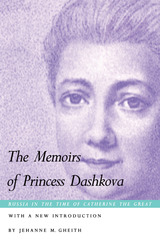 The Memoirs of Princess Dashkova
Ekaterina Romanovna Dashkova
Duke University Press, 1995 Ekaterina Romanovna Dashkova (1743–1810), Russian princess, playwright, author, President of the Academy of Sciences, and founder and Director of the Russian Academy, was one of the first women in Europe to hold public office. Her memoir, among the earliest examples of autobiography in Russia, is part of what has become a long and powerful tradition of autobiographical writing by Russian women. It offers a rare glimpse into the life of a strong and outspoken public figure who was well recognized in much of her own time for her potent intellect but who died in isolation and has largely been forgotten today.
Originally written in French, first published in English, and long out of print, Dashkova’s Memoirs tell the story of a woman who at age eighteen played an important role in the coup that brought Catherine the Great to the throne. The relationship between these two women, often tense, is a central theme throughout this story. Dashkova, occupying the highly unusual position of both stateswoman and mother, also reveals her own path between the demands and limitations of the "private" and "public" spheres of her society. She provides a view of the expectations of Russian aristocratic women, the possibilities available to them, and the ways in which gender roles were conceived in the eighteenth century.
With a new introduction by Jehanne M Gheith, The Memoirs of Princess Dashkova will renew interest in the life of a fascinating woman for students of Russian history, women’s studies, and eighteenth-century studies. It will be a significant text for those engaged in the cross-cultural study of the traditions of women’s autobiographical writing.
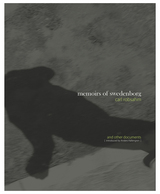 Memoirs of Swedenborg and Other Documents
Carl Robsahm
Swedenborg Foundation Publishers, 2011 Written in 1782, Memoirs of Swedenborg by Carl Robsahm is without doubt the most compelling eyewitness account of Emanuel Swedenborg (1688–1772) to be published in any language. Drawing on reminiscences from his own long-standing friendship with and years as a neighbor to Swedenborg, Robsahm offers a fascinating picture of the Swedish philosopher and mystic as a man of gentleness and integrity.
Rich in detail and generosity, this memoir is a classic in its own right and a primary resource for all subsequent biographies. This edition has been selected and edited by Stephen McNeilly featuring revised translations, an introduction, and annotations by the renowned Swedish scholar Anders Hallengren. It also contains eight other historical documents concerning Swedenborg’s day-to-day life, three of which are from the hand of Swedenborg himself.
The volume includes:
• “Memoirs of Swedenborg” by Carl Robsahm
• “Reply to a Letter from a Friend” by Emanuel Swedenborg
• “A Truthful Account of the Late Queen Dowager at Haga in 1774” by Anders von Hopken
• Extract from the Proceedings of the Exegetic and Philanthropic Society in Stockholm
• “Memoranda in the Notebook of 1747–48” by Emanuel Swedenborg
• “Description of the Late Assessor, Mr. Emanuel Swedenborg’s Estate at Södermalm”
• “A List of Valuables of 1770” by Emanuel Swedenborg
• “A Visit to Swedenborg’s Home” by Carl Christoffer Gjörwell
• Testimony by Christian de Tuxen
Each document is accompanied by its own individual contextual introduction and annotations by Anders Hallengren. Also included in the volume are a general foreword and introduction by Anders Hallengren, a chronology of Swedenborg’s life and works, and an index.
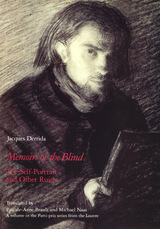 Memoirs of the Blind: The Self-Portrait and Other Ruins
Jacques Derrida
University of Chicago Press, 1993 In this brilliant essay, Jacques Derrida explores issues of
vision, blindness, self-representation, and their relation to
drawing, while offering detailed readings of an extraordinary
collection of images. Selected by Derrida from the prints
and drawings department of the Louvre, the works depict
blindness—fictional, historical, and biblical. From Old
and New Testament scenes to the myth of Perseus and the
Gorgon and the blinding of Polyphemus, Derrida uncovers in
these images rich, provocative layers of interpretation.
For Derrida drawing is itself blind; as an act rooted in
memory and anticipation, drawing necessarily replaces one
kind of seeing (direct) with another (mediated). Ultimately,
he explains, the very lines which compose any drawing are
themselves never fully visible to the viewer since they exist
only in a tenuous state of multiple identities: as marks on
a page, as indicators of a contour. Lacking a "pure"
identity, the lines of a drawing summon the supplement of the
word, of verbal discourse, and, in doing so, obscure the
visual experience. Consequently, Derrida demonstrates, the
very act of depicting a blind person undertakes multiple
enactments and statements of blindness and sight.
Memoirs of the Blind is both a sophisticated
philosophical argument and a series of detailed readings.
Derrida provides compelling insights into famous and lesser
known works, interweaving analyses of texts—including
Diderot's Lettres sur les aveugles, the notion of
mnemonic art in Baudelaire's The Painter of Modern
Life, and Merleau-Ponty's The Visible and the
Invisible. Along with engaging meditations on the history
and philosophy of art, Derrida reveals the ways viewers
approach philosophical ideas through art, and the ways art
enriches philosophical reflection.
An exploration of sight, representation, and art,
Memoirs of the Blind extends and deepens the
meditation on vision and painting presented in Truth and
Painting. Readers of Derrida, both new and familiar, will
profit from this powerful contribution to the study of the
visual arts.
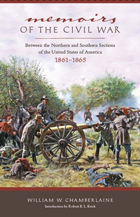 Memoirs of the Civil War: Between the Northern and Southern Sections of the United States of America 1861 to 1865
William W. Chamberlaine
University of Alabama Press, 2011 Contains much valuable information and engaging narrative passages
Memoirs of the Civil War, though relatively little known because of its rarity in the original edition, contains much valuable information and engaging narrative passages. A Virginian whose Confederate career included service in an infantry regiment early in the war, Chamberlaine’s most important military service was as a staff officer attached to Brigadier General Reuben Lindsay Walker, who commanded the Third Corps artillery in the Army of Northern Virginia.
Includes excellent material on the duties of staff officers, operation of Confederate conscription, and the role of artillery in Lee’s campaigns. He is especially eloquent and revealing about a number of famous battles: the Seven Days; Antietam, where Chamberlaine distinguished himself and was wounded; and the Wilderness, where he had a memorable encounter with Lee.
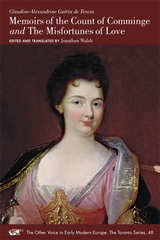 Memoirs of the Count of Comminge and The Misfortunes of Love
Claudine-Alexandrine Guérin de Tencin
Iter Press, 2016 These translations from the French bring two of Claudine-Alexandrine de Tencin’s novels back to life: The Memoirs of the Count of Comminge (1735), presented as a much-needed new translation, and The Misfortunes of Love (1747), appearing here for the first time in English. Published more than half a century after Marie-Madeleine de Lafayette’s La Princesse de Clèves, they belonged less to Tencin’s time than to the tradition of the “feminine historical novel” inspired by Lafayette. Beautifully written in the spare but powerful prose characteristic of French classicism and widely read both in Tencin’s lifetime and beyond, the novels were forgotten in the mid-nineteenth century. Like the work of Abbé Prévost and Pierre de Marivaux, they were important contributions to the early sentimental novel. They also anticipated, surprisingly, the gothic novels of Ann Radcliffe which appeared later in the century.
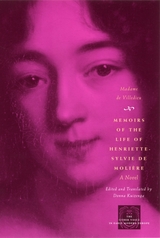 Memoirs of the Life of Henriette-Sylvie de Moliere: A Novel
Madame de Villedieu
University of Chicago Press, 2004 Known as Madame de Villedieu, Marie-Catherine Desjardins (ca. 1640-83) was a prolific writer who played an important role in the evolution of the early modern French novel. One of the earliest women to write for a living, she defied cultural convention by becoming an innovator and appealing to popular tastes through fiction, drama, and poetry.
Memoirs of the Life of Henriette-Sylvie de Molière, a semi autobiographical novel, portrays an enterprising woman who writes the story of her life, a complex tale that runs counter to social expectations and novelistic conventions. A striking work, the story skillfully mixes real events from the author's life with fictional adventures. At a time when few women published, Villedieu's Memoirs is a significant achievement in creating a voice for the early modern woman writer. Produced while the French novel form was still in its infancy, it should be welcomed by any scholar of women's writing or the early development of the novel.
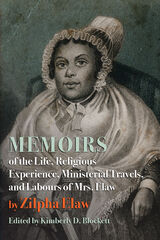 Memoirs of the Life, Religious Experience, Ministerial Travels, and Labours of Mrs. Elaw
Zilpha Elaw
West Virginia University Press, 2021 The remarkable autobiography of a Black woman evangelist.
As a young Black orphan indentured to a Quaker family in Bristol, Pennsylvania, Zilpha Elaw (c. 1793–1873) decided to join the upstart Methodists in 1808. She preached her first sermon a decade later, ignoring her husband and the many church leaders, clergy, and laity who tried to silence her. Elaw’s memoir chronicles the first twenty years of her forty-year itinerant ministry during massive Protestant revivalism in the United States and England.
Elaw preached from Maine to Virginia, attracting multiracial and multidenominational audiences that included powerful men, wealthy White women, poor families, and enslaved communities. She moved from Bristol to Burlington, New Jersey, then to Nantucket, Massachusetts, and finally, in 1840, to London’s East End. In England, Elaw’s celebrity expanded, and at least twice she drew crowds so large they caused human stampedes and multiple injuries.
Blockett’s introduction and extensive annotations draw on newly unearthed information about the entirety of Elaw’s evangelism to provide context for this remarkable story of an antebellum Black woman’s personal and professional mobility.
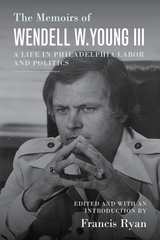 The Memoirs of Wendell W. Young III: A Life in Philadelphia Labor and Politics
Francis Ryan
Temple University Press, 2019 Philadelphia native Wendell W. Young III was one of the most important American labor leaders in the last half of the twentieth century. An Acme Markets clerk in the 1950s and ’60s, he was elected top officer of the Retail Clerks Union when he was twenty-four. His social justice unionism sought to advance wages while moving beyond collective bargaining to improve the conditions of the working-class majority, whether in a union or not. Young quickly gained a reputation for his independence, daring at times to publicly criticize the policies of the city’s powerful AFL-CIO leadership and tangle with the city’s political machine. Editor Francis Ryan, whose introduction provides historical context, interviewed Young about his experiences working in the region’s retail and food industry, measuring the changes over time and the tangible impact that union membership had on workers. Young also describes the impact of Philadelphia’s deindustrialization in the 1970s and ’80s and recounts his activism for civil rights and the anti-war movements as well as on John F. Kennedy’s presidential campaign. The Memoirs of Wendell W. YoungIII provides the most extensive labor history of late twentieth-century Philadelphia yet written.
 Memoirs Red and White: Poland, the War, and After
Peter F. Dembowski
University of Notre Dame Press, 2015 “Like the Polish flag, composed of two contrasting colors, red and white, my memoirs are cast in red and white. 'Red' treats largely my wartime life in Europe, life full of blood and death. My success in that part of my life was survival. 'White' represents my successful migration and peaceful life in America.” —from the Preface
Born after World War I into an educated and progressive Polish family, Peter F. Dembowski was a teenager during the joint occupation of Poland by Nazi Germany and the Soviet Union. His account of life as a young Polish soldier, as an immigrant to Canada, and finally as an American professor is a gripping narrative of life before, during, and after the horrors of World War II. Skillfully weaving a tapestry of emotion and history, Dembowski recounts the effects of loss: at age twelve, his father’s death; and later, the arrest of his mother and sister by the Gestapo and their execution in 1942 in the women’s concentration camp of Ravensbrück. Balancing those tragedies, Dembowski recalls the loving care given him by Janina Dembowska, the wife of his paternal uncle, as well as the inspiring strength of character he witnessed in his teachers and extended family.
Still a very young-looking teenager, Dembowski became involved with the Polish Underground in 1942. Suspected as a konspirator, he was incarcerated in Pawiak Prison and later, after a rare release, fought in the Warsaw Uprising of 1944. His on-the-ground account describes the deprivations Polish soldiers faced as well as the fierce patriotism they shared. With the defeat of the Uprising, he was deported to Sandbostel; once liberated, he joined the Polish Army in Italy, serving there for two years.
In 1947, Dembowski made the momentous decision not to return to Poland but rather to emigrate to Canada. We learn of his stint as a farmhand and, later, of his studies at the University of British Columbia in Vancouver. He continued his education in France, receiving a Doctorat de l’Université de Paris in Russian philology and, in 1960, a PhD from the University of California at Berkeley in medieval French. In tandem with his successful academic career teaching at the University of Toronto and at the University of Chicago, Dembowski describes his happy marriage and the joy of family life.
“Peter F. Dembowski’s Memoirs Red and White: Poland, the War, and After is the moving testimony of an individual who has had firsthand knowledge of the most dramatic moments in the history of the twentierth century. His story is one of heroic courage, honesty, and optimism.”
—Thomas Pavel, Gordon J. Laing Distinguished Service Professor in Romance Languages and Literature, University of Chicago
"Memoirs Red and White: Poland, the War, and After is a powerful portrait of Polish life in the late 1930s and 1940s, told beautifully through the lens of Peter F. Dembowski's heroic family. Dembowski recounts the adventures of his brave and ethical family members during the Depression, as members of the konspiracja, as well as his mother's and sister's executions in Ravensbrück. The author provides a riveting account of his own heroism during the 1944 Warsaw Uprising and his incarceration in Stalag XB near Sandbostel, as well as his life in the United States after the war. The book describes the patriotism of Poles during a very difficult era. Dembowski's book is an excellent choice for readers who want to learn more about Polish life, patriotism, and history during the Second World War." —Eric Sterling, Distinguished Research Professor of English, Auburn University at Montgomery
"Memoirs Red and White vividly describes life in Poland before and during the war. It touches on the issues of war and resistance, life in the camps, and the gruesome toll of death and survival. While there is no shortage of literature on the war and camps, Dembowski adds new vignettes and details that will be of interest to a general reader. I think it is important to have Dembowski's record of the events in print as the last of the war generation is disappearing, taking with them their memories and life stories." —Michael Khodarkovsky, Loyola University Chicago
 Memorabilia. Oeconomicus. Symposium. Apology
Xenophon
Harvard University Press Socrates without Plato.
Xenophon (ca. 430 to ca. 354 BC), a member of a wealthy but politically quietist Athenian family and an admirer of Socrates, left Athens in 401 BC to serve as a mercenary commander for Cyrus the Younger of Persia, then joined the staff of King Agesilaus II of Sparta before settling in Elis and, in the aftermath of the battle of Leuctra in 371 BC, retiring to Corinth. His historical and biographical works, Socratic dialogues and reminiscences, and short treatises on hunting, horsemanship, economics, and the Spartan constitution are richly informative about his own life and times.
This volume collects Xenophon’s portrayals of his associate, Socrates. In Memorabilia (or Memoirs of Socrates) and in Oeconomicus, a dialogue about household management, we see the philosopher through Xenophon’s eyes. Here, as in the accompanying Symposium, we also obtain insight on life in Athens. The volume concludes with Xenophon’s Apology, an interesting complement to Plato’s account of Socrates’ defense at his trial.
Memorabilia. Oeconomicus. Symposium. Apology
Xenophon
Harvard University Press In Memorabilia or Memoirs of Socrates and in Oeconomicus, a dialogue about household management, we see the philosopher through Xenophon's eyes. Here, and in the accompanying Symposium we also obtain insight on life in Athens. The volume concludes with Xenophon's Apology, an interesting complement to Plato's account of Socrates' defense at his trial. Ostensibly an account of a dinner party in the summer of 421 BCE, Xenophon's Symposium is a vibrant picture of an Athenian evening of quiet entertainment and conversation. Among the guests Socrates is the central figure, and—as in Plato's Symposium—love is the main subject of debate. But the style here is more relaxed and less artful than in Plato's philosophical dialogue, yielding an engaging portrait of Socrates and of Athenian social life.
 Memorable Doings and Sayings, Volume I: Books 1–5
Valerius Maximus
Harvard University Press, 2000 Exemplary wisdom from ancient Rome.
Valerius Maximus compiled his handbook of notable deeds and sayings during the reign of Tiberius (AD 14–37). The collection was admired in antiquity and has recently been attracting renewed scholarly attention. Yet to date there has been no modern English translation of Memorable Doings and Sayings. This work is now added to the Loeb Classical Library, in two volumes, a freshly edited Latin text facing D. R. Shackleton Bailey’s pleasing and authoritative translation.
Valerius arranges his instructive examples in short chapters, each focused on a particular virtue, vice, religious practice, or traditional custom—including Omens, Dreams, Anger, Cruelty, Bravery, Fidelity, Gratitude, Friendship, Parental Love. The moral undercurrent of this collection is readily apparent. But Valerius tells us that the book’s purpose is simply practical: he decided to select worthwhile material from famous writers so that people looking for illustrative examples might be spared the trouble of research. Whatever the author’s intention, his book is an interesting source of information on Roman attitudes toward religion and moral values in the first century.
 Memorable Doings and Sayings, Volume II: Books 6–9
Valerius Maximus
Harvard University Press, 2000 Exemplary wisdom from ancient Rome.
Valerius Maximus compiled his handbook of notable deeds and sayings during the reign of Tiberius (AD 14–37). The collection was admired in antiquity and has recently been attracting renewed scholarly attention. Yet to date there has been no modern English translation of Memorable Doings and Sayings. This work is now added to the Loeb Classical Library, in two volumes, a freshly edited Latin text facing D. R. Shackleton Bailey’s pleasing and authoritative translation.
Valerius arranges his instructive examples in short chapters, each focused on a particular virtue, vice, religious practice, or traditional custom—including Omens, Dreams, Anger, Cruelty, Bravery, Fidelity, Gratitude, Friendship, Parental Love. The moral undercurrent of this collection is readily apparent. But Valerius tells us that the book’s purpose is simply practical: he decided to select worthwhile material from famous writers so that people looking for illustrative examples might be spared the trouble of research. Whatever the author’s intention, his book is an interesting source of information on Roman attitudes toward religion and moral values in the first century.
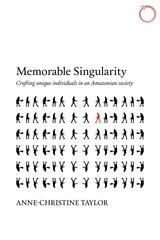 Memorable Singularity: Crafting Unique Individuals in an Amazonian Society
Anne-Christine Taylor
HAU, 2018 Individual sovereignty is a central value among Amazonian groups, in keeping with a cosmology premised on the production of people rather than material property. The Jivaroan Indians of Western Amazonia exemplify these ideals to an unusual degree. Jivaroean have long been notorious for a reputed addiction to warfare, their custom of shrinking enemies’ heads, and their fierce resistance to colonial and post-colonial attempts to convert them to Christianity and to deprive them of their land, identity, and lifeways. Becoming and remaining an accomplished Jivaroan person is a taxing and risk-fraught achievement: it requires living and imagining in the heroic mode and mastering the art of making one’s self memorable.
In Memorable Singularity, anthropologist Anne-Christine Taylor describes how Jivaroans strive for uniqueness of being and destiny, unconstrained by the claims of any institutionalized form authority beyond the individual. Taylor covers a wide range of subjects: feuding and intertribal warfare, Jivaroan notions of personhood, corporeality, reflexive consciousness, thought and affect, memory, and visual culture. An essential collection of one of the foremost Amazonian specialists, Memorable Singularity is at once a richly literary work and an illuminating meditation on the process of crafting and imagining the human self.
Memorandoms by James Martin: An Astonishing Escape from Early New South Wales
Edited by Tim Causer
University College London, 2017 On the night of March 28, 1791, James Martin, William Bryant, his wife Mary, and their two children, along with six other male convicts—among the first cohort of prisoners sent to Australia from England— stole a small boat from Sydney Harbor and sailed up the coast of Australia. They reached East Timor on June 5. Once there, they posed as survivors of a shipwreck, until they were eventually discovered and ordered back to England. The Memorandoms of James Martin is the only known chronicle written by members of that first group of prisoners, and this convict narrative is also the only firsthand account of the best-known Australian convict escape. This document, confirmed in its details by careful scholarly analysis, clarifies one of the most important origin stories of Australian history.
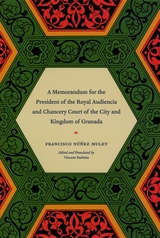 A Memorandum for the President of the Royal Audiencia and Chancery Court of the City and Kingdom of Granada
Francisco Núñez Muley
University of Chicago Press, 2007 Conquered in 1492 and colonized by invading Castilians, the city and kingdom of Granada faced radical changes imposed by its occupiers throughout the first half of the sixteenth century—including the forced conversion of its native Muslim population. Written by Francisco Núñez Muley, one of many coerced Christian converts, this extraordinary letter lodges a clear-sighted, impassioned protest against the unreasonable and strongly assimilationist laws that required all converted Muslims in Granada to dress, speak, eat, marry, celebrate festivals, and be buried exactly as the Castilian settler population did.
Now available in its first English translation, Núñez Muley’s account is an invaluable example of how Spain’s former Muslims made active use of the written word to challenge and openly resist the progressively intolerant policies of the Spanish Crown. Timely and resonant—given current debates concerning Islam, minorities, and cultural and linguistic assimilation—this edition provides scholars in a range of fields with a vivid and early example of resistance in the face of oppression.
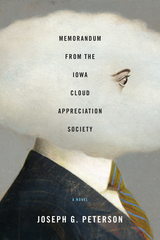 Memorandum from the Iowa Cloud Appreciation Society: A Novel
Joseph G. Peterson
University of Iowa Press, 2022 When his girlfriend, Rosemary, asks about his life, Jim Moore, a successful salesman whose territory covers the entire continental United States and parts of Canada, doesn’t think there is anything to say and so he tells her “nothing happened,” or maybe he doesn’t know how to put it all into words or maybe he doesn’t want to.
Stuck in an airport because of blizzard conditions, and packed into a crowded terminal with other travelers, Moore has come to believe that his life is not worth reporting about because it has largely been a life lived without incident. However, chance encounters with a yoga instructor, a man traveling to bury his mother, and an enigmatic woodsman reawaken long dormant emotions about his father’s suicide and cause Jim to newly reflect on his own life and on a memorandum that he later discovered in his deceased father’s papers, which lists all the names of the clouds, and which Jim now, from time to time, recants as if it were his own private kaddish to memorialize his lost father.
Like the pilgrims in Chaucer’s The Canterbury Tales who pass the time telling stories while stranded in the Tabard Inn, Memorandum from the Iowa Cloud Appreciation Society tells the tale of a traveling salesman and what really happened over the course of his forty- six years.
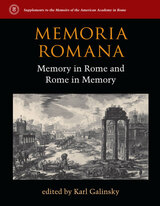 Memoria Romana: Memory in Rome and Rome in Memory
edited by Karl Galinsky
University of Michigan Press, 2014 Concern with memory permeated Roman literature, history, rhetorical training, and art and architecture. This is the first book to look at the phenomenon from a variety of perspectives, including cognitive science. There is no orthodoxy in memory studies and the approaches are both empirical and theoretical. A central issue is: who and what preserved and shaped cultural memory in Rome, and how did that process work? Areas and subjects covered include the Romans' view of the changing physical fabric of the city, monuments (by etymology related to memory) such as the Arch of Constantine, memory and the Roman triumph, Roman copies of Greek sculpture and their relation to memory, the importance of written information and of continuing process, the creation of memory in Republican memoirs and Flavian poetry, the invention of traditions, and the connection of cultural and digital memory. The ten chapters present original findings that complement earlier scholarship from the perspective of memory and open up new horizons for inquiry. The introduction by volume editor Karl Galinsky situates the work within current studies on cultural and social memory, and the concluding chapter by Daniel Libeskind provides the perspective of a contemporary practitioner. Additional contributors include Richard Jenkyns, Harriet I. Flower, T. P. Wiseman, Karl-J. Hölkeskamp, Gianpiero Rosati, Diane Favro, Jessica Hughes, Anna Anguissola, Lisa Marie Mignone, and Bernard Frischer.
Memorial
Ferdinando Camon
Northwestern University Press, 1996 Memorial is the third part of the celebrated trilogy Camon called "the cycle of the lowliest," which traced one of the most important but least recognized events of modern history: the death of Italy's peasant civilization.
Camon's northern Italy was primitive and poor; little more than strong religious beliefs helped sustain its people through years of poverty, hunger, and disease. With the arrival of modern life and its "civilizing" aspects, the peasant ways, and all they stood for, changed forever.
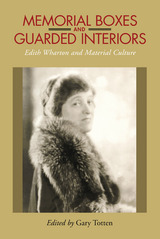 Memorial Boxes and Guarded Interiors: Edith Wharton and Material Culture
Gary Totten
University of Alabama Press, 2007 In Edith Wharton’s works, references to architecture, interior decoration, painting, sculpture, and fashion abound. As these essays demonstrate, art and objects are for Wharton evidence of cultural belief and reflect the values, assumptions, and customs of the burgeoning consumer culture in which she lived and about which she wrote. Furthermore, her meditations about issues of architecture, design, and decoration serve as important commentaries on her vision of the literary arts.
In The Decoration of Houses she notes that furniture and bric-à-brac are often crowded into a room in order to compensate for a "lack of architectural composition in the treatment of the walls," and that unless an ornamental object "adequately expresses an artistic conception" it is better removed from the room. These aesthetic standards apply equally to her construction of narratives and are evidence of a sensibility that counters typical understandings of Wharton as a novelist of manners and place her instead as an important figure in the development of American literary modernism.
Essays in this collection address issues such as parallels between her characters and the houses they occupy; dress as a metaphor for the flux of critical fashion; the marketing of Wharton's work to a growing female readership ; her relationship to mass culture industries such as advertising, theater, and cinema; the tableaux vivant both as set piece and as fictional strategy; the representation of female bodies as objets d’art; and her characters’ attempts at self-definition through the acquisition and consumption of material goods. All of Wharton’s major novels—The House of Mirth, The Fruit of the Tree, Ethan Frome, The Custom of the Country, Summer, The Age of Innocence, and Twilight Sleep—as well as her short stories, criticism, and essays are explored.
Gary Totten is Assistant Professor of English at North Dakota State University. His essays on Wharton and her contemporaries have appeared in American Indian Quarterly, American Literary Realism, College Literature, Dreiser Studies, and MELUS.
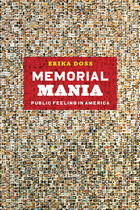 Memorial Mania: Public Feeling in America
Erika Doss
University of Chicago Press, 2010 In the past few decades, thousands of new memorials to executed witches, victims of terrorism, and dead astronauts, along with those that pay tribute to civil rights, organ donors, and the end of Communism have dotted the American landscape. Equally ubiquitous, though until now less the subject of serious inquiry, are temporary memorials: spontaneous offerings of flowers and candles that materialize at sites of tragic and traumatic death. In Memorial Mania, Erika Doss argues that these memorials underscore our obsession with issues of memory and history, and the urgent desire to express—and claim—those issues in visibly public contexts. Doss shows how this desire to memorialize the past disposes itself to individual anniversaries and personal grievances, to stories of tragedy and trauma, and to the social and political agendas of diverse numbers of Americans. By offering a framework for understanding these sites, Doss engages the larger issues behind our culture of commemoration. Driven by heated struggles over identity and the politics of representation, Memorial Mania is a testament to the fevered pitch of public feelings in America today.
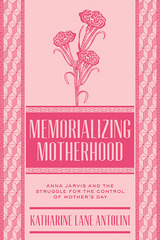 Memorializing Motherhood: Anna Jarvis and the Struggle for Control of Mother's Day
Katharine Lane Antolini
West Virginia University Press, 2017 Few know the name Anna Jarvis, yet on the second Sunday in May, we mail the card, buy the flowers, place the phone call, or make the brunch reservation to honor our mothers, all because of her. Anna Jarvis organized the first official Mother’s Day celebration in Grafton, West Virginia in 1908 and then spent decades promoting the holiday and defending it from commercialization. She designed her Mother’s Day celebration around a sentimental view of motherhood and domesticity, envisioning a day venerating the daily services and sacrifices of mothers within the home.
After Mother’s Day became a national holiday in 1914, many organizations sought to align the holiday’s meaning with changing perceptions of modern motherhood in the twentieth century. Instead of restricting a mother’s service and influence solely to the domestic sphere, they emphasized the power of mothers both within their homes and throughout their communities.
Jarvis refused to accept this changing interpretation, claiming both intellectual and legal ownership of Mother’s Day. Her obsession with protecting the purity of her vision sustained a war of verbal and legal assaults against rival holiday promoters, patriotic women’s organizations, charitable foundations, public health reformers, and the Franklin D. Roosevelt administration. The struggle for control of Mother’s Day ultimately threatened her livelihood, physical health, and emotional stability. Memorializing Motherhood explores the complicated history of Anna Jarvis’s movement to establish and control Mother’s Day, as well as the powerful conceptualization of this day as both a holiday and a cultural representation of motherhood.
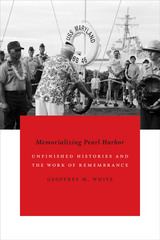 Memorializing Pearl Harbor: Unfinished Histories and the Work of Remembrance
Geoffrey M. White
Duke University Press, 2016 Memorializing Pearl Harbor examines the challenge of representing history at the site of the attack that brought America into World War II. Analyzing moments in which history is re-presented—in commemorative events, documentary films, museum design, and educational programming—Geoffrey M. White shows that the memorial to the Pearl Harbor bombing is not a fixed or singular institution. Rather, it has become a site in which many histories are performed, validated, and challenged. In addition to valorizing military service and sacrifice, the memorial has become a place where Japanese veterans have come to seek recognition and reconciliation, where Japanese Americans have sought to correct narratives of racial mistrust, and where Native Hawaiians have challenged their ongoing erasure from their own land. Drawing on extended ethnographic fieldwork, White maps these struggles onto larger controversies about public history, museum practices, and national memory.
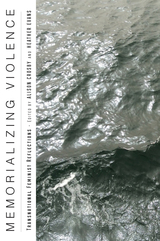 Memorializing Violence: Transnational Feminist Reflections
Alison Crosby
Rutgers University Press, 2025 Memorializing Violence brings together feminist and queer reflections on the transnational lives of memorialization practices, asking what it means to grapple with loss, mourning, grief, and desires to collectively remember and commemorate–as well as urges to forget–in the face of disparate yet entangled experiences of racialized and gendered colonial, imperial, militarized, and state violence. The volume uses a transnational feminist approach to ask, How do such efforts in seemingly unconnected remembrance landscapes speak to, with, and through each other in a world order inflected by colonial, imperial, and neoliberal logics, structures, and strictures? How do these memorializing initiatives not only formulate within but move through complex transnational flows and circuits, and what transpires as they do? What does it mean to inhabit loss, mourning, resistance, and refusal through memorialization at this moment, and what’s at stake in doing so? What might transnational feminist analyses of gender, race, sexuality, class, and nation have to offer in this regard?
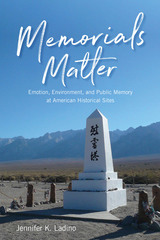 Memorials Matter: Emotion, Environment, and Public Memory at American Historical Sites
Jennifer K. Ladino
University of Nevada Press, 2019 From the sculptured peaks of Mount Rushmore to the Coloradan prairie lands at Sand Creek to the idyllic islands of the Pacific, the West’s signature environments add a new dimension to the study of memorials. In such diverse and often dramatic landscapes, how do the natural and built environments shape our emotions?
In Memorials Matter, author Jennifer Ladino investigates the natural and physical environments of seven diverse National Park Service (NPS) sites in the American West and how they influence emotions about historical conflict and national identity. Chapters center around the region’s diverse inhabitants (Mexican, Chinese, Japanese, African, and Native Americans) and the variously traumatic histories these groups endured—histories of oppression, exploitation, incarceration, slavery, and genocide. Drawing on material ecocritical theory, Ladino emphasizes the ideological and political importance of memorials and how they evoke visceral responses that are not always explicitly “storied,” but nevertheless matter in powerful ways.
In this unique blend of narrative scholarship and critical theory, Ladino demonstrates how these memorial sites and their surrounding landscapes, combined with written texts, generate emotion and shape our collective memory of traumatic events. She urges us to consider our everyday environments and to become attuned to features and feelings we might have otherwise overlooked.
 Memorias
Sancho Cota
Harvard University Press This is the first printed edition of the sixteenth-century autograph manuscript by the Castilian Sancho Cota, secretary to Eleanor, sister of the Spanish Emperor Charles V, and later Queen of Portugal and France. The language of the original, typical of Toledan speech in the early sixteenth century, is preserved without change. An informative introduction by Keniston discusses the language and the work, and provides the reader with a brief biography of the author.
Though not a great work of literature, Sancho Cota's combination of diary, prose, and verse presents an account of the ideas and customs of the courts of Flanders, Spain, and France at the time. Included is his interesting summary of the major events of Western Europe during the period from 1506 to 1538, written partly from his eyewitness observation, and partly from official dispatches to which his position gave him access.
The lyrical and allegorical verses contained in the Memorias are the only example we have of the literary activity of the Castilians who were in Flanders during the early years of the young Prince Charles. To the gentlemen and prelates who read his poems Cota brought the revelation that far-off Spain was not wholly barbarous, but had a tradition of classical learning and literary composition.
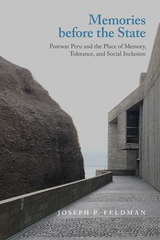 Memories before the State: Postwar Peru and the Place of Memory, Tolerance, and Social Inclusion
Joseph P. Feldman
Rutgers University Press, 2021 Honorable Mention for Best Book Award from the Historia Reciente y Memoria Section of the Latin American Studies Association (LASA)
Memories before the State examines the discussions and debates surrounding the creation of the Place of Memory, Tolerance, and Social Inclusion (LUM), a national museum in Peru that memorializes the country’s internal armed conflict of the 1980s and 1990s. Emerging from a German donation that the Peruvian government initially rejected, the Lima-based museum project experienced delays, leadership changes, and limited institutional support as planners and staff devised strategies that aligned the LUM with a new class of globalized memorial museums and responded to political realities of the country’s postwar landscape. The book analyzes forms of authority that emerge as an official institution seeks to incorporate and manage diverse perspectives on recent violence.
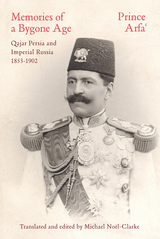 Memories of a Bygone Age: Qajar Persia and Imperial Russia 1853-1902
Prince Arfa
Gingko, 2016 Set against the backdrop of Iran’s struggle against the rising powers of Russia and Britain, the memoirs of Mirza Riza Khan Arfa’-ed-Dowleh—otherwise known as Prince Arfa (1853–1902)—are packed with picaresque adventures as the prince tells the story of his rise from humble provincial beginnings to the heights of the Iranian state. With this translation, his incredible story is brought to life for the first time in English.
Prince Arfa writes with arresting wit about the deadly intrigues of the Qajar court. Lamentingly, but resolutely, he chronicles the decline of Iran from a once great empire to an almost bankrupt, lawless state, in which social unrest is channelled and exploited by the clergy. He describes the complex interactions between Iran and Europe, including an account of Naser-od-Din Shah’s profligate visits to Britain and France; the splendor and eccentricities of the doomed Tsar Nicholas II’s court; the Tsar’s omen-laden coronation; and his own favor with the Tsarina, who would grant him concessions on matters of vital importance to his country. The result is a memoir of extraordinary political intrigue.
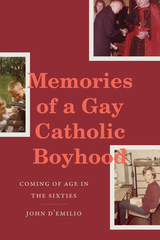 Memories of a Gay Catholic Boyhood: Coming of Age in the Sixties
John D'Emilio
Duke University Press, 2022 John D’Emilio is one of the leading historians of his generation and a pioneering figure in the field of LGBTQ history. At times his life has been seemingly at odds with his upbringing. How does a boy from an Italian immigrant family in which everyone unfailingly went to confession and Sunday Mass become a lapsed Catholic? How does a family who worshipped Senator Joseph McCarthy and supported Richard Nixon produce an antiwar activist and pacifist? How does a family in which the word divorce was never spoken raise a son who comes to explore the hidden gay sexual underworld of New York City?
Memories of a Gay Catholic Boyhood is D’Emilio’s coming-of-age story in which he takes readers from his working-class Bronx neighborhood to an elite Jesuit high school in Manhattan to Columbia University and the political and social upheavals of the late 1960s. He shares his personal experiences of growing up in a conservative, tight-knit, multigenerational family, how he went from considering entering the priesthood to losing his faith and coming to terms with his same-sex desires. Throughout, D’Emilio outlines his complicated relationship with his family while showing how his passion for activism influenced his decision to use research, writing, and teaching to build a strong LGBTQ movement.
This is not just John D’Emilio’s personal story; it opens a window into how the conformist baby boom decade of the 1950s transformed into the tumultuous years of radical social movements and widespread protest during the 1960s. It is the story of what happens when different cultures and values collide and the tensions and possibilities for personal discovery and growth that emerge. Intimate and honest, D’Emilio’s story will resonate with anyone who has had to chart their own path in a world they did not expect to find.
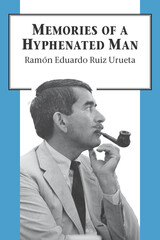 Memories of a Hyphenated Man
Ramón Eduardo Ruiz Urueta
University of Arizona Press, 2003 Ramon Eduardo Ruiz would be the first to admit that he is not your typical Mexican American. But he has always known who he is. Historian, author, and intellectual, Ruiz has established himself through such books as Triumphs and Tragedy: A History of the Mexican People and Cuba: The Making of a Revolution, and in 1998 he was awarded the National Humanities Medal by President Clinton. Now he turns his pen on his own life to offer a personal look at what it really means to be American by birth but Mexican by culture. Little has been written by or about persons of Mexican origin who have achieved the academic stature of Ruiz, and his memoir provides insights not found in the more common biographies of labor leaders and civil rights activists. His early life straddled the social worlds of his parent's Mexico and semi-rural America, where his father's success as an entrepreneur and property owner set his family's experiences apart from those of most other Mexican Americans at the time. His parents reinforced in their children an identity as mexicanos, and that connection with his ancestral roots was for Ruiz a lifejacket in the days of acute bigotry in America. In making an early, self-conscious commitment to a life of the mind, Ruiz became aware of his unique nature, and while not immune to prejudice he was able to make a name for himself in several endeavors. As a student, he attended college when few Mexican Americans were given that opportunity, and he was one of the first of his generation to earn a Ph.D. As an Army Air Force officer during World War II, he served as a pilot in the Pacific theatre. And as an intellectual, he navigated the currents of the historical profession and charted new directions in Latin American research through his prolific writing. Ruiz's career teaching took him to Mexico, Massachusetts, Texas, Oregon—often as the lone "Mexican professor," and ultimately back to his native California. While teaching at Smith, he exulted in being "free to interpret Spanish American life and culture to my heart's content," and at the University of California, San Diego, he saw the era of campus racial barrier give way to the birth of affirmative action. While at UCSD, he taught hundreds of Chicanos and trained one of the largest groups of Chicano Ph.D's. Memories of a Hyphenated Man is the story of a unique individual who, while shaped by his upbringing and drawing on deep cultural roots, steadfastly followed his own compass in life. It tells of a singular man who beat the odds as it poignantly addresses the ambiguities associated with race, class, citizenship, and nationality for Mexicans and Mexican Americans.
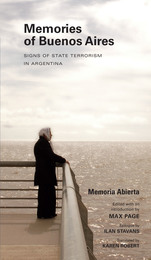 Memories of Buenos Aires: Signs of State Terrorism in Argentina
Max Page
University of Massachusetts Press, 2013 In the 1970s, Argentina was the leader in the "Dirty War," a violent campaign by authoritarian South American regimes to repress left-wing groups and any others who were deemed subversive. Over the course of a decade, Argentina's military rulers tortured and murdered upwards of 30,000 citizens. Even today, after thirty years of democratic rule, the horror of that time continues to roil Argentine society.
Argentina has also been in the vanguard in determining how to preserve sites of torture, how to remember the "disappeared," and how to reflect on the causes of the Dirty War. Across the capital city of Buenos Aires are hundreds of grassroots memorials to the victims, documenting the scope of the state's reign of terror. Although many books have been written about this era in Argentina's history, the original Spanish-language edition of Memories of Buenos Aires was the first to identify and interpret all of these sites. It was published by the human rights organization Memoria Abierta, which used interviews with survivors to help unearth that painful history.
This translation brings this important work to an English-speaking audience, offering a comprehensive guidebook to clandestine sites of horror as well as innovative sites of memory. The book divides the 48 districts of the city into 9 sectors, and then proceeds neighborhood-by-neighborhood to offer descriptions of 202 known "sites of state terrorism" and 38 additional places where people were illegally detained, tortured, and killed by the government.
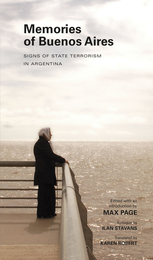 Memories of Buenos Aires: Signs of State Terrorism in Argentina
Memoria Abierta
University of Massachusetts Press, 2013 In the 1970s, Argentina was the leader in the “Dirty War,” a violent campaign by authoritarian South American regimes to repress left-wing groups and any others who were deemed subversive. Over the course of a decade, Argentina’s military rulers tortured and murdered upwards of 30,000 citizens. Even today, after thirty years of democratic rule, the horror of that time continues to roil Argentine society. Argentina has also been in the vanguard in determining how to preserve sites of torture, how to remember the “disappeared,” and how to reflect on the causes of the Dirty War. Across the capital city of Buenos Aires are hundreds of grassroots memorials to the victims, documenting the scope of the state’s reign of terror. Although many books have been written about this era in Argentina’s history, the original Spanish-language edition of Memories of Buenos Aires was the first to identify and interpret all of these sites. It was published by the human rights organization Memoria Abierta, which used interviews with survivors to help unearth that painful history. This translation brings this important work to an English-speaking audience, offering a comprehensive guidebook to clandestine sites of horror as well as innovative sites of memory. The book divides the 48 districts of the city into 9 sectors, and then proceeds neighborhood-by-neighborhood to offer descriptions of 202 known “sites of state terrorism” and 38 additional places where people were illegally detained, tortured, and killed by the government.
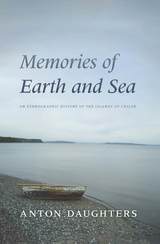 Memories of Earth and Sea: An Ethnographic History of the Islands of Chiloé
Anton Daughters
University of Arizona Press, 2019 Memories of Earth and Sea recounts the history of more than two dozen islands clustered along the Patagonian flank of South America. Settled over the centuries by nomadic seafarers, indigenous farmers, and Spanish explorers, southern Chile’s Archipelago of Chiloé remained until recently a rural outpost resistant to cultural pressures from the mainland. Islanders developed a way of life heavily dependent on marine resources, native crops like the potato, and the cooperative labor practice known as the minga.
Staring in the 1980s, Chiloé was thrust into the global economy when major companies moved into the region to extract wild stocks of fish and to grow salmon and shellfish for export. The archipelago’s economy shifted abruptly from one of subsistence farming and fishing to wage labor in export industries. Local knowledge, traditions, memories, and identities similarly shifted, with young islanders expressing a more critical view of the rural past than their elders.
This book highlights the region’s unique past, emphasizing the generational tensions, disconnects, and continuities of the last half century. Drawing on interviews, field observations, and historical documents, Anton Daughters brings to life one of South America’s most culturally distinct regions.
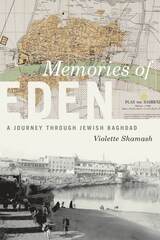 Memories of Eden: A Journey Through Jewish Baghdad
Violette Shamash
Northwestern University Press, 2010 According to legend, the Garden of Eden was located in Iraq, and for millennia, Jews resided peacefully in metropolitan Baghdad. Memories of Eden: A Journey Through Jewish Baghdad reconstructs the last years of the oldest Jewish Diaspora community in the world through the recollections of Violette Shamash, a Jewish woman who was born in Baghdad in 1912, sent to her daughter Mira Rocca and son-in-law, the British journalist Tony Rocca. The result is a deeply textured memoir—an intimate portrait of an individual life, yet revealing of the complex dynamics of the Middle East in the twentieth century. Toward the end of her long life, Violette Shamash began writing letters, notes, and essays and sending them to the Roccas. The resulting book begins near the end of Ottoman rule and runs through the British Mandate, the emergence of an independent Iraq, and the start of dictatorial government. Shamash clearly loved the world in which she grew up but is altogether honest in her depiction of the transformation of attitudes toward Baghdad’s Jewish population. Shamash’s world is finally shattered by the Farhud, the name given to the massacre of hundreds of Iraqi Jews over three days in 1941. An event that has received very slight historical coverage, the Farhud is further described and placed in context in a concluding essay by Tony Rocca.
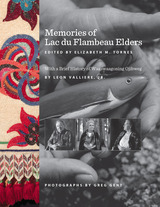 Memories of Lac du Flambeau Elders
Edited by Elizabeth M. Tornes
University of Wisconsin Press, 2004 Memories of Lac du Flambeau Elders is a collection of interviews with fifteen Ojibwe elders of the Lac du Flambeau Band of Lake Superior Chippewa Indians in northern Wisconsin. The elders, in their seventies and eighties when interviewed, all experienced enormous changes in their lifetimes. In their stories they discuss these changes as well as the traditions and beliefs that the Ojibwe have continued to maintain, despite attempts at forced assimilation on the part of the U.S. government and others. Their stories are testimony to the enduring strength of the Ojibwe people and their way of life.
Most historical accounts of the Ojibwe have been written by Americans of European descent. This book tells the history of the Lac du Flambeau Ojibwe in their own words. It also includes a historical introduction, by Leon Valliere, Jr., going back four hundred years to Lac du Flambeau’s original settlement. A black-and-white photographic portrait of each elder prefaces each interview, and historical photos from the George W. Brown Jr. Ojibwe Museum Cultural Center and collection illustrate the text.
Distributed for the Center for the Study of Upper Midwestern Cultures.
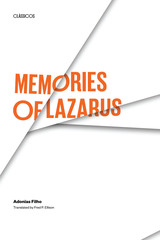 Memories of Lazarus
By Adonias Filho
University of Texas Press, 1969 These are the recollections of Alexandre—of his life, his death-in-life, and his ultimate death, as they are played out against the mobile tapestry of the valley where he was born. The valley itself, in the backlands of the state of Bahia, Brazil, alternates at different stages in Alexandre’s consciousness between reality and symbol. It swings from a harsh regional specificity to become the panorama of all human life, its endless, eroding wind the devouring hostility of all environments and its pain the pain of every human being in the face of his own brutality and that of others.
Throughout the novel Alexandre’s mind ranges from sharp awareness, through hallucination, to oblivion (“a man dies while alive,” says Jeronimo, his mentor), and back again as he experiences the violent, obtuse phenomena of life in the valley—his universe and ours. This latter-day Lazarus leaves the resisting hills and black sky once only, hounded by the valley dwellers who believe he has murdered his wife, her father, and her brother. Yet despite his awareness of the horror of the valley and his intuition of something beyond it, it is precisely his contact with the gentler existence to which he escapes that forces Alexandre to recognize his nature for what it is. Turning his back on a greater and more varied range of feeling and experience, he chooses the narrow ferocity of the valley, to which he returns to die the final death for which the earlier deaths have prepared him.
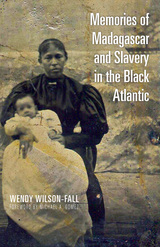 Memories of Madagascar and Slavery in the Black Atlantic
Wendy Wilson-Fall
Ohio University Press, 2015 From the seventeenth century into the nineteenth, thousands of Madagascar’s people were brought to American ports as slaves. In Memories of Madagascar and Slavery in the Black Atlantic, Wendy Wilson-Fall shows that the descendants of these Malagasy slaves in the United States maintained an ethnic identity in ways that those from the areas more commonly feeding the Atlantic slave trade did not. Generations later, hundreds, if not thousands, of African Americans maintain strong identities as Malagasy descendants, yet the histories of Malagasy slaves, sailors, and their descendants have been little explored. Wilson-Fall examines how and why the stories that underlie this identity have been handed down through families—and what this says about broader issues of ethnicity and meaning-making for those whose family origins, if documented at all, have been willfully obscured by history. By analyzing contemporary oral histories as well as historical records and examining the conflicts between the two, Wilson-Fall carefully probes the tensions between the official and the personal, the written and the lived. She suggests that historically, the black community has been a melting pot to which generations of immigrants—enslaved and free—have been socially assigned, often in spite of their wish to retain far more complex identities. Innovative in its methodology and poetic in its articulation, this book bridges history and ethnography to take studies of diaspora, ethnicity, and identity into new territory.
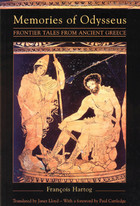 Memories of Odysseus: Frontier Tales From Ancient Greece
François Hartog
University of Chicago Press, 2001 The conception of the Other has long been a problem for philosophers. Emmanuel Levinas, best known for his attention to precisely that issue, argued that the voyages of Ulysses represent the very nature of Western philosophy: "His adventure in the world is nothing but a return to his native land, a complacency with the Same, a misrecognition of the Other." In Memories of Odysseus, François Hartog examines the truth of Levinas' assertion and, in the process, uncovers a different picture. Drawing on a remarkable range of authors and texts, ancient and modern, Hartog looks at accounts of actual travelers, as well as the way travel is used as a trope throughout ancient Greek literature, and finds that, instead of misrecognition, the Other is viewed with doubt and awe in the Homeric tradition. In fact, he argues, the Odyssey played a crucial role in shaping this attitude in the Greek mind, serving as inspiration for voyages in which new encounters caused the Greeks to revise their concepts of self and other. Ambitious in scope, this book is a sophisticated exploration of ancient Greece and its sense of identity.
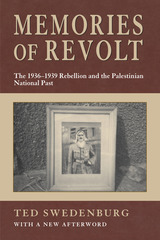 Memories of Revolt: The 1936–1939 Rebellion and the Palestinian National Past
Ted Swedenburg
University of Arkansas Press, 2003 “This wonderful monograph treats a subject that resonates with anyone who studies the Palestinian-Israeli conflict and particularly Palestinian nationalism: that how Palestinian history is remembered and constructed is as meaningful to our understanding of the current struggle as arriving as some sort of ‘complete empirical understanding’ of its history. Swedenburg . . . studies how a major anti-colonial insurrection, the 1936–38 strike and revolt in Palestine [against the British], is remembered in Palestinian nationalist historiography, western and Israeli ‘official’ historical discourse, and Palestinian popular memory. Using primarily oral history interviews, supplemented by archival material and national monuments, he presents multiple, complex, contradictory, and alternative interpretations of historical events. . . . The book is thematically divided into explorations of Palestinian nationalist symbols, stereotypes, and myths; Israeli national monuments that simultaneously act as historical ‘injunctions against forgetting’ Jewish history and efforts to ‘marginalize, vilify, and obliterate’ the Arab history of Palestine; Palestine subaltern memories as resistance to official narratives, including unpopular and controversial recollections of collaboration and assassination; and finally, how the recodification and revival of memories of the revolt informed the Palestinian intifada that erupted in 1987.” —MESA Bulletin
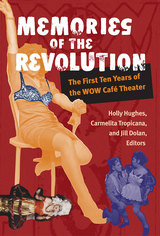 Memories of the Revolution: The First Ten Years of the WOW Café Theater
Holly Hughes, Carmelita Tropicana, and Jill Dolan, Editors
University of Michigan Press, 2015 The women’s experimental theater space called the WOW Café (Women’s One World) has been a vital part of New York’s downtown theater scene since 1980. Since that time, WOW has provided a place for feminist and particularly lesbian theater artists to create, perform, and witness a cultural revolution. Its renowned alumnae include playwright and actor Lisa Kron, performance artists Holly Hughes and Carmelita Tropicana, the theater troupe the Five Lesbian Brothers, and actors/playwrights Peggy Shaw, Lois Weaver, and Deb Margolin, among others. Memories of the Revolution collects scripts, interviews, and commentary to trace the riotous first decade of WOW. While the histories of other experimental theater collectives have been well documented, WOW’s history has only begun to be told. The anthology also includes photographs of and reminiscences by Café veterans, capturing the history and artistic flowering of the first ten years of this countercultural haven.
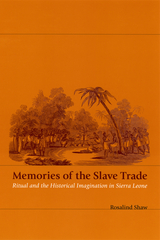 Memories of the Slave Trade: Ritual and the Historical Imagination in Sierra Leone
Rosalind Shaw
University of Chicago Press, 2002 How is the slave trade remembered in West Africa? In a work that challenges recurring claims that Africans felt (and still feel) no sense of moral responsibility concerning the sale of slaves, Rosalind Shaw traces memories of the slave trade in Temne-speaking communities in Sierra Leone. While the slave-trading past is rarely remembered in explicit verbal accounts, it is often made vividly present in such forms as rogue spirits, ritual specialists' visions, and the imagery of divination techniques.
Drawing on extensive fieldwork and archival research, Shaw argues that memories of the slave trade have shaped (and been reshaped by) experiences of colonialism, postcolonialism, and the country's ten-year rebel war. Thus money and commodities, for instance, are often linked to an invisible city of witches whose affluence was built on the theft of human lives. These ritual and visionary memories make hitherto invisible realities manifest, forming a prism through which past and present mutually configure each other.
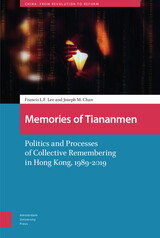 Memories of Tiananmen: Politics and Processes of Collective Remembering in Hong Kong, 1989-2019
Francis Lee
Amsterdam University Press, 2021 Memories of Tiananmen: Politics and Processes of Collective Remembering in Hong Kong, 1989-2019 analyzes how collective memory regarding the 1989 Beijing student movement and the Tiananmen crackdown was produced, contested, sustained, and transformed in Hong Kong between 1989 and 2019. Drawing on data gathered through multiple sources such as news reports, digital media content, on-site vigil surveys, population surveys, and in-depth interviews with activists, rally participants, and other stakeholders, it identifies six key processes in the dynamics of social remembering: memory formation, memory mobilization, memory institutionalization, intergenerational transfer, memory repair, and memory balkanization. The book demonstrates how a socially dominant collective memory, even one the state finds politically irritable, can be generated and maintained through constant negotiation and efforts by a wide range of actors. While Memories of Tiananmen mainly focuses on the interplay between political changes and the Tiananmen commemoration in the historical period within which the society enjoyed a significant degree of civil liberties, it also discusses how the trajectory of the collective memory may take a drastic turn as Hong Kong’s autonomy is abridged. The book promises to be a key reference for anyone interested in collective memory studies, social movement research, political communication, and China and Hong Kong studies.
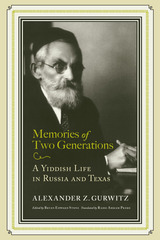 Memories of Two Generations: A Yiddish Life in Russia and Texas
Alexander Z. Gurwitz, Edited and Introduced by Bryan Edward Stone
University of Alabama Press, 2022 The 1935 autobiography of Alexander Ziskind Gurwitz, an Orthodox Jew whose lively recounting of his life in Tsarist Russia and his immigration to San Antonio, Texas, in 1910 captures turbulent changes in early twentieth-century Jewish history
In 1910, at the age of fifty-one, Alexander Ziskind Gurwitz made the bold decision to emigrate with his wife and four children from southeastern Ukraine in Tsarist Russia to begin a new life in Texas. In 1935, in his seventies, Gurwitz composed a retrospective autobiography, Memories of Two Generations, that recounts his personal story both of the rich history of the lost Jewish world of Eastern Europe and of the rambunctious development of frontier Jewish communities in the United States.
In both Europe and America, Gurwitz inhabited an almost exclusively Jewish world. As a boy, he studied in traditional yeshivas and earned a living as a Hebrew language teacher and kosher butcher. Widely travelled, Gurwitz recalls with wit and insight daily life in European shtetls, providing perceptive and informative comments about Jewish religion, history, politics, and social customs. Among the book’s most notable features is his first-hand, insider’s account of the yearly Jewish holiday cycle as it was observed in the nineteenth century, described as he experienced it as a child.
Gurwitz’s account of his arrival in Texas forms a cornerstone record of the Galveston Immigration Movement; this memoir represents the only complete narrative of that migration from an immigrant’s point of view. Gurwitz’s descriptions about the development of a thriving Orthodox community in San Antonio provide an important and unique primary source about a facet of American Jewish life that is not widely known.
Gurwitz wrote his memoir in his preferred Yiddish, and this translation into English by Rabbi Amram Prero captures the lyrical style of the original. Scholar and author Bryan Edward Stone’s special introduction and illuminating footnotes round out a superb edition that offers much to experts and general readers alike.
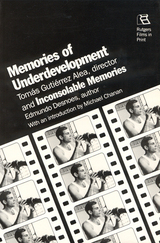 Memories Of Underdevelopment
Chanan, Michael
Rutgers University Press, 1990 Memories of Underdevelopment was the first great international success of Cuban cinema. The film provides a complex portrait of Sergio, a disaffected bourgeois intellectual who remains in Havana after the Revolution, suspended between two worlds. He can no longer accept the values of his family's reactionary past and yet boredom and the conditioning of his early life prevent him from committing himself to the new revolutionary society. Sergio's story is played out in the turbulent period of the Bay of Pigs invasion and the 1962 missile crisis, events he can only watch on his television screen or from his apartment balcony.The film, initially banned by the U.S. government as part of its trade quarantine of Cuba, was shown here five years after its original release. But American critics responded enthusiastically to it and the National Society of Film Critics bestowed an award on its director.
This double volume includes the complete continuity script of Memories, as well as the complete novel, Inconsolable Memories, upon which the film is based. An interview with Alea is reproduced here, as well as documentation of the political controversy that surrounded the film in this country. Michael Chanan's introduction places the film in the context of Cuban political and cultural history. The volume also includes a biographical sketch of Alea, a chronology of the Cuban Revolution, reviews, commentary, a filmography, and a bibliography.Michael Chanan lives in England, where he teaches and writes on film. He is the author of The Cuban Image: Cinema and Cultural Politics in Cuba.
|
|


